cultural development of gastronomy PDF
VerifiedAdded on 2022/01/17
|76
|17739
|145
AI Summary
Contribute Materials
Your contribution can guide someone’s learning journey. Share your
documents today.
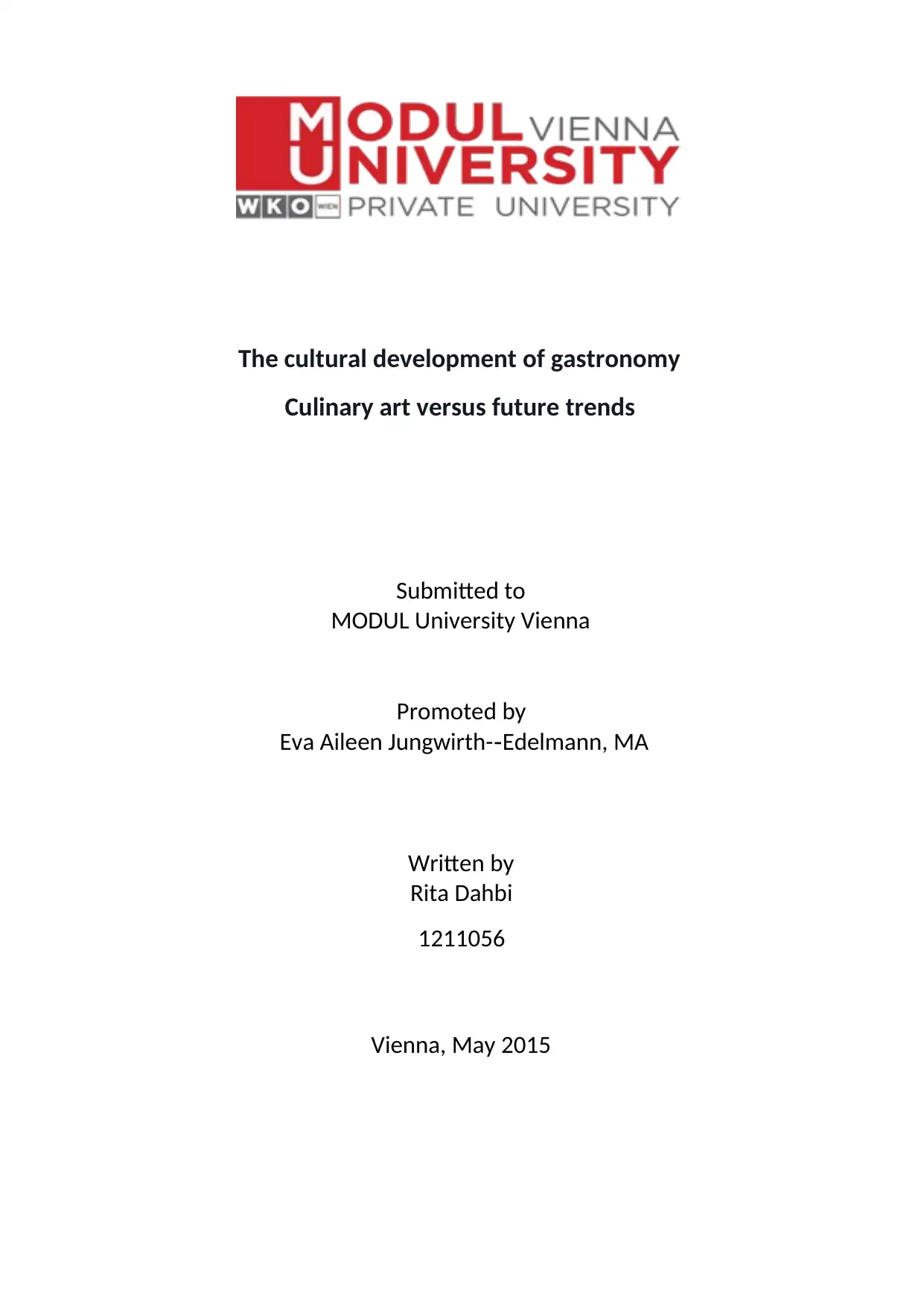
The cultural development of gastronomy
Culinary art versus future trends
Submitted to
MODUL University Vienna
Promoted by
Eva Aileen Jungwirth- Edelmann, MA‐
Written by
Rita Dahbi
1211056
Vienna, May 2015
Culinary art versus future trends
Submitted to
MODUL University Vienna
Promoted by
Eva Aileen Jungwirth- Edelmann, MA‐
Written by
Rita Dahbi
1211056
Vienna, May 2015
Secure Best Marks with AI Grader
Need help grading? Try our AI Grader for instant feedback on your assignments.

2
Declaration of Academic Honesty
I, Rita Dahbi
Born on the 21. March 1990 in Vienna, Austria
Herewith declare,
1. writing my bachelor thesis autonomously, without the use of sources
and aids, which were not explicitly stated and unauthorized,
2. that I have, neither nationally nor internationally, submitted my bachelor
thesis in any form of examination paper,
3. that all interview partners agreed to the publishing of the interview
content.
Vienna, May 2015 Rita Dahbi
Declaration of Academic Honesty
I, Rita Dahbi
Born on the 21. March 1990 in Vienna, Austria
Herewith declare,
1. writing my bachelor thesis autonomously, without the use of sources
and aids, which were not explicitly stated and unauthorized,
2. that I have, neither nationally nor internationally, submitted my bachelor
thesis in any form of examination paper,
3. that all interview partners agreed to the publishing of the interview
content.
Vienna, May 2015 Rita Dahbi
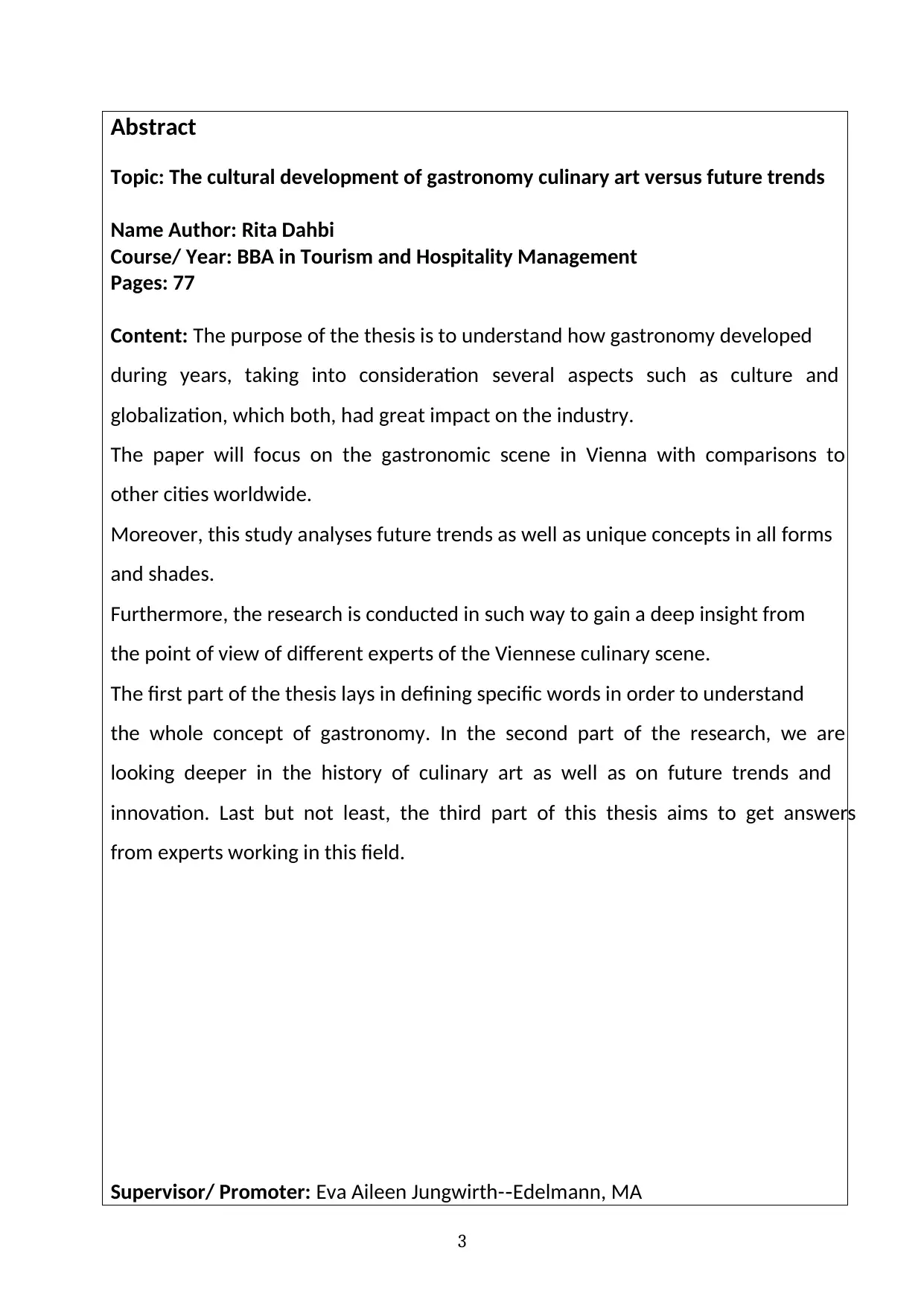
3
Abstract
Topic: The cultural development of gastronomy culinary art versus future trends
Name Author: Rita Dahbi
Course/ Year: BBA in Tourism and Hospitality Management
Pages: 77
Content: The purpose of the thesis is to understand how gastronomy developed
during years, taking into consideration several aspects such as culture and
globalization, which both, had great impact on the industry.
The paper will focus on the gastronomic scene in Vienna with comparisons to
other cities worldwide.
Moreover, this study analyses future trends as well as unique concepts in all forms
and shades.
Furthermore, the research is conducted in such way to gain a deep insight from
the point of view of different experts of the Viennese culinary scene.
The first part of the thesis lays in defining specific words in order to understand
the whole concept of gastronomy. In the second part of the research, we are
looking deeper in the history of culinary art as well as on future trends and
innovation. Last but not least, the third part of this thesis aims to get answers
from experts working in this field.
Supervisor/ Promoter: Eva Aileen Jungwirth- Edelmann, MA‐
Abstract
Topic: The cultural development of gastronomy culinary art versus future trends
Name Author: Rita Dahbi
Course/ Year: BBA in Tourism and Hospitality Management
Pages: 77
Content: The purpose of the thesis is to understand how gastronomy developed
during years, taking into consideration several aspects such as culture and
globalization, which both, had great impact on the industry.
The paper will focus on the gastronomic scene in Vienna with comparisons to
other cities worldwide.
Moreover, this study analyses future trends as well as unique concepts in all forms
and shades.
Furthermore, the research is conducted in such way to gain a deep insight from
the point of view of different experts of the Viennese culinary scene.
The first part of the thesis lays in defining specific words in order to understand
the whole concept of gastronomy. In the second part of the research, we are
looking deeper in the history of culinary art as well as on future trends and
innovation. Last but not least, the third part of this thesis aims to get answers
from experts working in this field.
Supervisor/ Promoter: Eva Aileen Jungwirth- Edelmann, MA‐
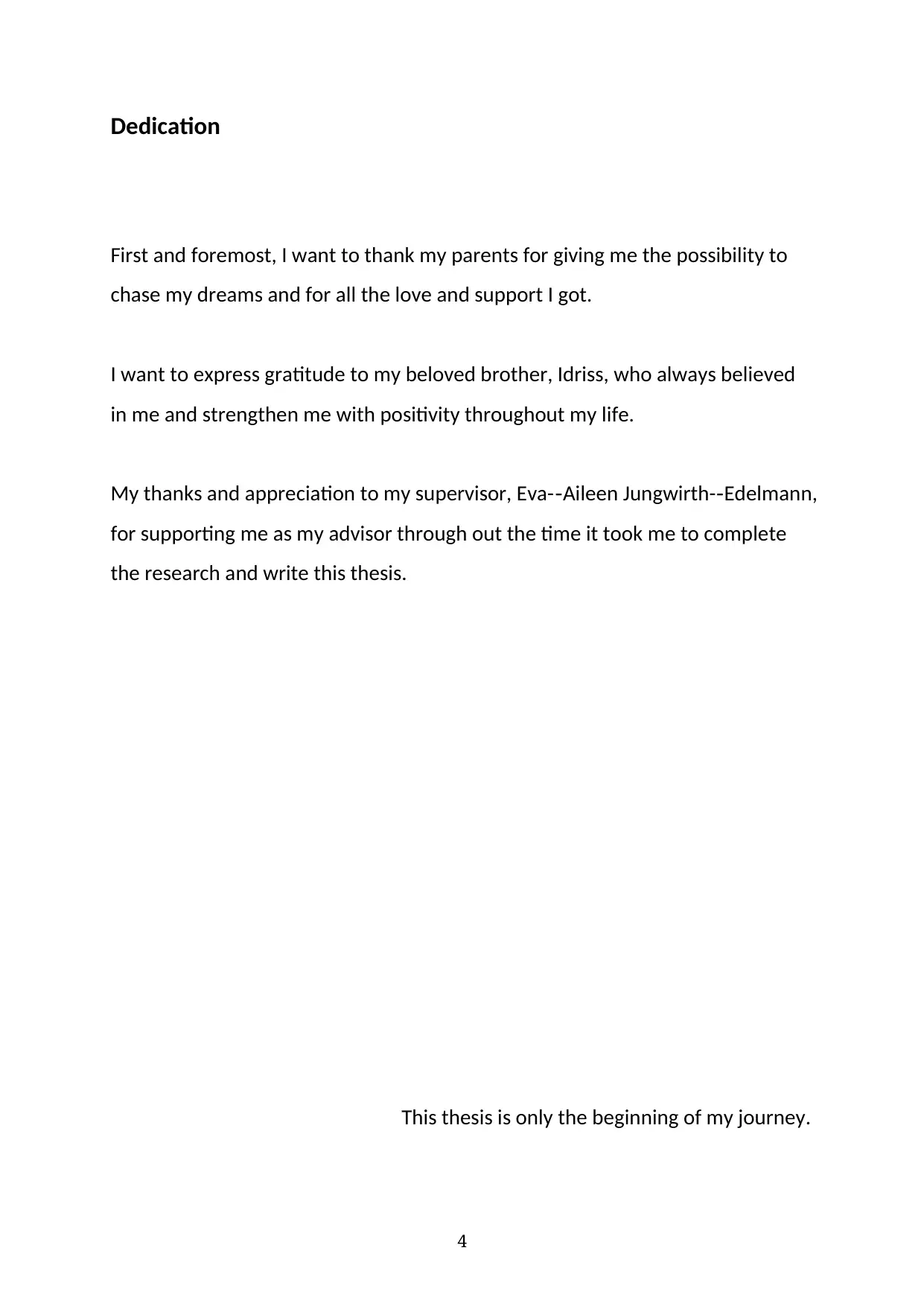
4
Dedication
First and foremost, I want to thank my parents for giving me the possibility to
chase my dreams and for all the love and support I got.
I want to express gratitude to my beloved brother, Idriss, who always believed
in me and strengthen me with positivity throughout my life.
My thanks and appreciation to my supervisor, Eva- Aileen Jungwirth- Edelmann,‐ ‐
for supporting me as my advisor through out the time it took me to complete
the research and write this thesis.
This thesis is only the beginning of my journey.
Dedication
First and foremost, I want to thank my parents for giving me the possibility to
chase my dreams and for all the love and support I got.
I want to express gratitude to my beloved brother, Idriss, who always believed
in me and strengthen me with positivity throughout my life.
My thanks and appreciation to my supervisor, Eva- Aileen Jungwirth- Edelmann,‐ ‐
for supporting me as my advisor through out the time it took me to complete
the research and write this thesis.
This thesis is only the beginning of my journey.
Secure Best Marks with AI Grader
Need help grading? Try our AI Grader for instant feedback on your assignments.
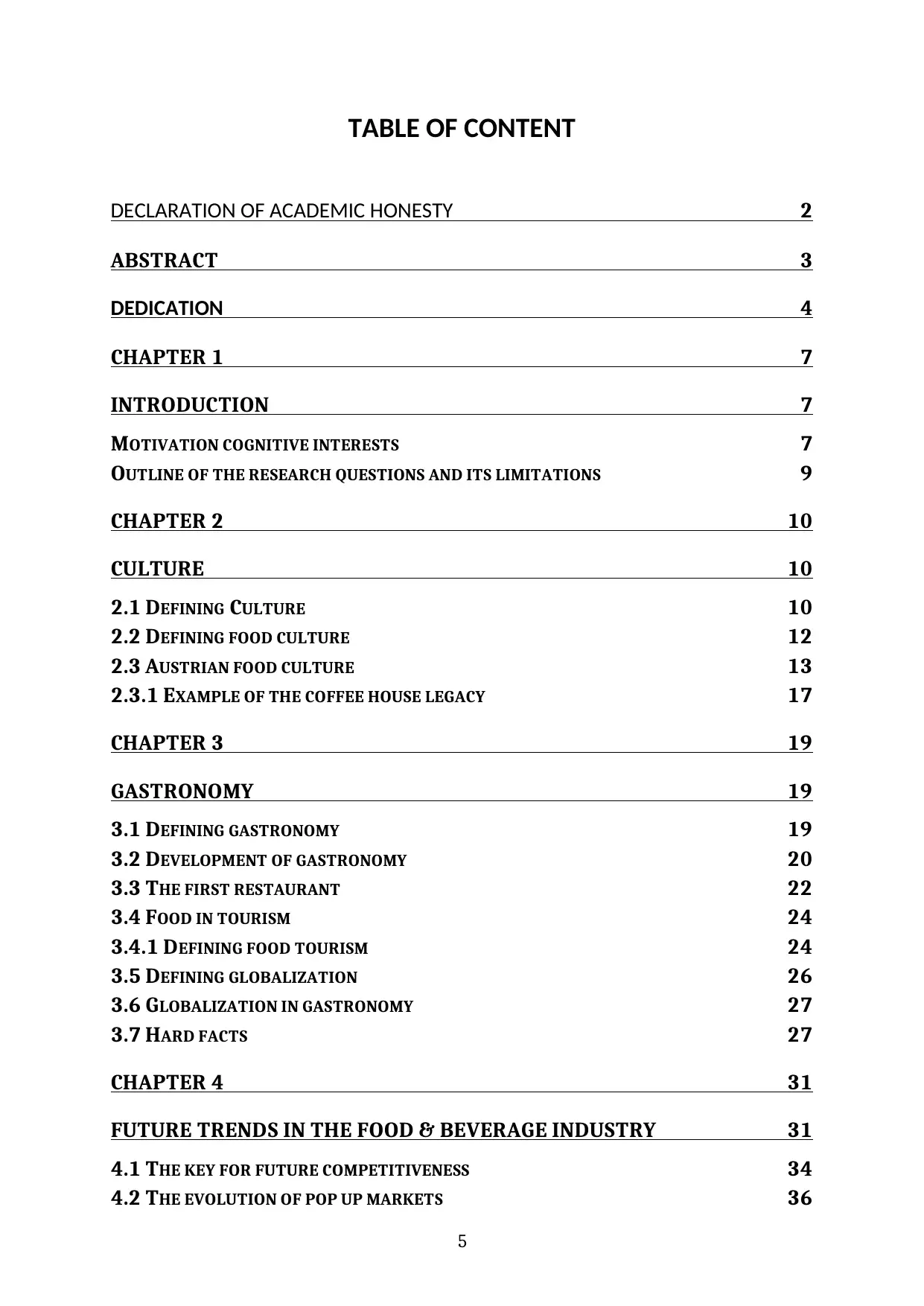
5
TABLE OF CONTENT
DECLARATION OF ACADEMIC HONESTY 2
ABSTRACT 3
DEDICATION 4
CHAPTER 1 7
INTRODUCTION 7
MOTIVATION COGNITIVE INTERESTS 7
OUTLINE OF THE RESEARCH QUESTIONS AND ITS LIMITATIONS 9
CHAPTER 2 10
CULTURE 10
2.1 DEFINING CULTURE 10
2.2 DEFINING FOOD CULTURE 12
2.3 AUSTRIAN FOOD CULTURE 13
2.3.1 EXAMPLE OF THE COFFEE HOUSE LEGACY 17
CHAPTER 3 19
GASTRONOMY 19
3.1 DEFINING GASTRONOMY 19
3.2 DEVELOPMENT OF GASTRONOMY 20
3.3 THE FIRST RESTAURANT 22
3.4 FOOD IN TOURISM 24
3.4.1 DEFINING FOOD TOURISM 24
3.5 DEFINING GLOBALIZATION 26
3.6 GLOBALIZATION IN GASTRONOMY 27
3.7 HARD FACTS 27
CHAPTER 4 31
FUTURE TRENDS IN THE FOOD & BEVERAGE INDUSTRY 31
4.1 THE KEY FOR FUTURE COMPETITIVENESS 34
4.2 THE EVOLUTION OF POP UP MARKETS 36
TABLE OF CONTENT
DECLARATION OF ACADEMIC HONESTY 2
ABSTRACT 3
DEDICATION 4
CHAPTER 1 7
INTRODUCTION 7
MOTIVATION COGNITIVE INTERESTS 7
OUTLINE OF THE RESEARCH QUESTIONS AND ITS LIMITATIONS 9
CHAPTER 2 10
CULTURE 10
2.1 DEFINING CULTURE 10
2.2 DEFINING FOOD CULTURE 12
2.3 AUSTRIAN FOOD CULTURE 13
2.3.1 EXAMPLE OF THE COFFEE HOUSE LEGACY 17
CHAPTER 3 19
GASTRONOMY 19
3.1 DEFINING GASTRONOMY 19
3.2 DEVELOPMENT OF GASTRONOMY 20
3.3 THE FIRST RESTAURANT 22
3.4 FOOD IN TOURISM 24
3.4.1 DEFINING FOOD TOURISM 24
3.5 DEFINING GLOBALIZATION 26
3.6 GLOBALIZATION IN GASTRONOMY 27
3.7 HARD FACTS 27
CHAPTER 4 31
FUTURE TRENDS IN THE FOOD & BEVERAGE INDUSTRY 31
4.1 THE KEY FOR FUTURE COMPETITIVENESS 34
4.2 THE EVOLUTION OF POP UP MARKETS 36
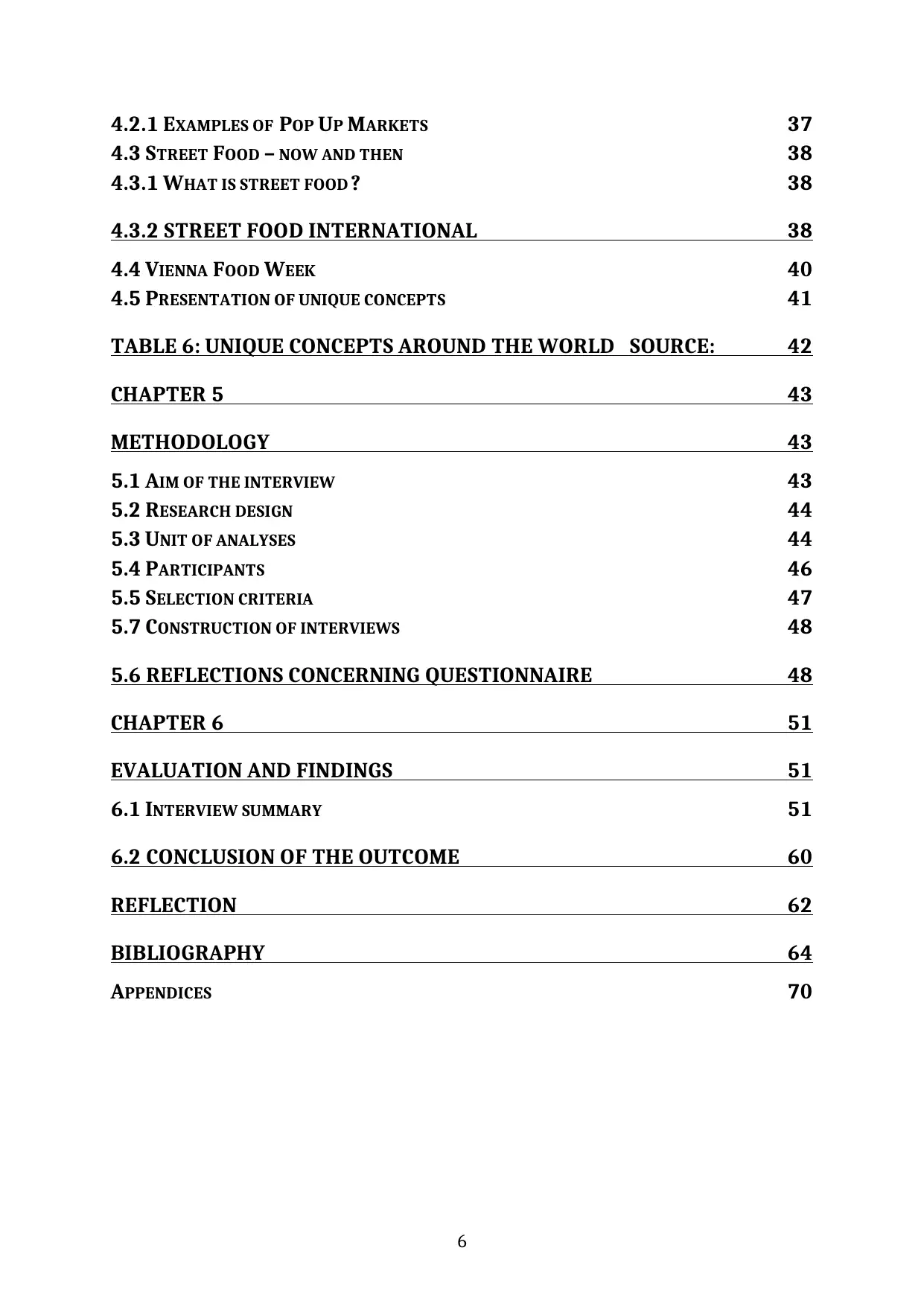
6
4.2.1 EXAMPLES OF POP UP MARKETS 37
4.3 STREET FOOD – NOW AND THEN 38
4.3.1 WHAT IS STREET FOOD ? 38
4.3.2 STREET FOOD INTERNATIONAL 38
4.4 VIENNA FOOD WEEK 40
4.5 PRESENTATION OF UNIQUE CONCEPTS 41
TABLE 6: UNIQUE CONCEPTS AROUND THE WORLD SOURCE: 42
CHAPTER 5 43
METHODOLOGY 43
5.1 AIM OF THE INTERVIEW 43
5.2 RESEARCH DESIGN 44
5.3 UNIT OF ANALYSES 44
5.4 PARTICIPANTS 46
5.5 SELECTION CRITERIA 47
5.7 CONSTRUCTION OF INTERVIEWS 48
5.6 REFLECTIONS CONCERNING QUESTIONNAIRE 48
CHAPTER 6 51
EVALUATION AND FINDINGS 51
6.1 INTERVIEW SUMMARY 51
6.2 CONCLUSION OF THE OUTCOME 60
REFLECTION 62
BIBLIOGRAPHY 64
APPENDICES 70
4.2.1 EXAMPLES OF POP UP MARKETS 37
4.3 STREET FOOD – NOW AND THEN 38
4.3.1 WHAT IS STREET FOOD ? 38
4.3.2 STREET FOOD INTERNATIONAL 38
4.4 VIENNA FOOD WEEK 40
4.5 PRESENTATION OF UNIQUE CONCEPTS 41
TABLE 6: UNIQUE CONCEPTS AROUND THE WORLD SOURCE: 42
CHAPTER 5 43
METHODOLOGY 43
5.1 AIM OF THE INTERVIEW 43
5.2 RESEARCH DESIGN 44
5.3 UNIT OF ANALYSES 44
5.4 PARTICIPANTS 46
5.5 SELECTION CRITERIA 47
5.7 CONSTRUCTION OF INTERVIEWS 48
5.6 REFLECTIONS CONCERNING QUESTIONNAIRE 48
CHAPTER 6 51
EVALUATION AND FINDINGS 51
6.1 INTERVIEW SUMMARY 51
6.2 CONCLUSION OF THE OUTCOME 60
REFLECTION 62
BIBLIOGRAPHY 64
APPENDICES 70
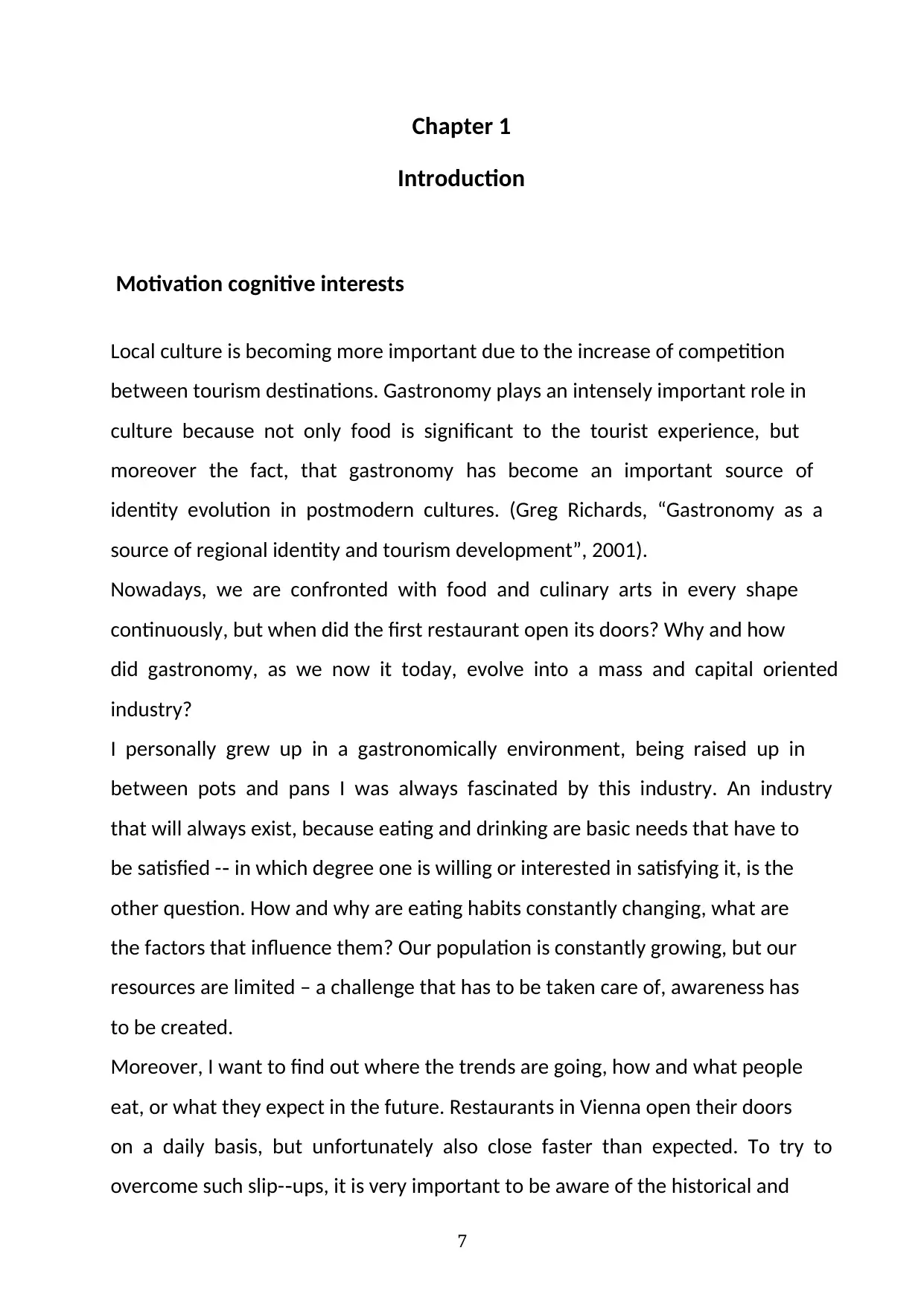
7
Chapter 1
Introduction
Motivation cognitive interests
Local culture is becoming more important due to the increase of competition
between tourism destinations. Gastronomy plays an intensely important role in
culture because not only food is significant to the tourist experience, but
moreover the fact, that gastronomy has become an important source of
identity evolution in postmodern cultures. (Greg Richards, “Gastronomy as a
source of regional identity and tourism development”, 2001).
Nowadays, we are confronted with food and culinary arts in every shape
continuously, but when did the first restaurant open its doors? Why and how
did gastronomy, as we now it today, evolve into a mass and capital oriented
industry?
I personally grew up in a gastronomically environment, being raised up in
between pots and pans I was always fascinated by this industry. An industry
that will always exist, because eating and drinking are basic needs that have to
be satisfied - in which degree one is willing or interested in satisfying it, is the‐
other question. How and why are eating habits constantly changing, what are
the factors that influence them? Our population is constantly growing, but our
resources are limited – a challenge that has to be taken care of, awareness has
to be created.
Moreover, I want to find out where the trends are going, how and what people
eat, or what they expect in the future. Restaurants in Vienna open their doors
on a daily basis, but unfortunately also close faster than expected. To try to
overcome such slip- ups, it is very important to be aware of the historical and‐
Chapter 1
Introduction
Motivation cognitive interests
Local culture is becoming more important due to the increase of competition
between tourism destinations. Gastronomy plays an intensely important role in
culture because not only food is significant to the tourist experience, but
moreover the fact, that gastronomy has become an important source of
identity evolution in postmodern cultures. (Greg Richards, “Gastronomy as a
source of regional identity and tourism development”, 2001).
Nowadays, we are confronted with food and culinary arts in every shape
continuously, but when did the first restaurant open its doors? Why and how
did gastronomy, as we now it today, evolve into a mass and capital oriented
industry?
I personally grew up in a gastronomically environment, being raised up in
between pots and pans I was always fascinated by this industry. An industry
that will always exist, because eating and drinking are basic needs that have to
be satisfied - in which degree one is willing or interested in satisfying it, is the‐
other question. How and why are eating habits constantly changing, what are
the factors that influence them? Our population is constantly growing, but our
resources are limited – a challenge that has to be taken care of, awareness has
to be created.
Moreover, I want to find out where the trends are going, how and what people
eat, or what they expect in the future. Restaurants in Vienna open their doors
on a daily basis, but unfortunately also close faster than expected. To try to
overcome such slip- ups, it is very important to be aware of the historical and‐
Paraphrase This Document
Need a fresh take? Get an instant paraphrase of this document with our AI Paraphraser

8
cultural background of gastronomy, as well as it´s developments over time and
its future trends. With globalization and new media technologies, the
gastronomic industry has to adapt, in order to stay competitive. Everybody is
different. Everyone has different needs. And everybody has different
definitions of a good “restaurant”. By comparing these different aspects and by
talking to experts in this field, I will try to understand the market in order to
create awareness.
The saying, ‘we are what we eat’ is becoming increasingly important, not
necessarily in the physical sense, it has more to do with the cuisine we
purchase on holiday and with which we identify ourselves.
Not only the modern tourist is becoming more mobile, but also the food we
purchase.
Summarizing up what Richards said, the association of a specific food typ with
areas is being confronted thru culinary styles as well as the growing mobility of
food and the increasing differentiation of foods and cookeries.
A long way from creating a homogenized gastronomic scene, the strain in the
middle of globalization and confinement is delivering continually varieties. Not
only are global nourishments rising asfor example the world wide renowned
brand Coca Cola or the US fast food franchise concept McDonald's, however
regional food is flourishing, and “fusion foods” are being invented to nourish
the “global soul” (Greg Richards, “Gastronomy as a source of regional identity
and tourism development”, 2001)
Richards states that vacationers themselves are adding to gastronomic
versatility, by making an interest for substances they have experienced abroad,
or in their own nations. There are various scientific diagrams that show how
gastronomy has improved in taste and craftsmanship through time.
cultural background of gastronomy, as well as it´s developments over time and
its future trends. With globalization and new media technologies, the
gastronomic industry has to adapt, in order to stay competitive. Everybody is
different. Everyone has different needs. And everybody has different
definitions of a good “restaurant”. By comparing these different aspects and by
talking to experts in this field, I will try to understand the market in order to
create awareness.
The saying, ‘we are what we eat’ is becoming increasingly important, not
necessarily in the physical sense, it has more to do with the cuisine we
purchase on holiday and with which we identify ourselves.
Not only the modern tourist is becoming more mobile, but also the food we
purchase.
Summarizing up what Richards said, the association of a specific food typ with
areas is being confronted thru culinary styles as well as the growing mobility of
food and the increasing differentiation of foods and cookeries.
A long way from creating a homogenized gastronomic scene, the strain in the
middle of globalization and confinement is delivering continually varieties. Not
only are global nourishments rising asfor example the world wide renowned
brand Coca Cola or the US fast food franchise concept McDonald's, however
regional food is flourishing, and “fusion foods” are being invented to nourish
the “global soul” (Greg Richards, “Gastronomy as a source of regional identity
and tourism development”, 2001)
Richards states that vacationers themselves are adding to gastronomic
versatility, by making an interest for substances they have experienced abroad,
or in their own nations. There are various scientific diagrams that show how
gastronomy has improved in taste and craftsmanship through time.
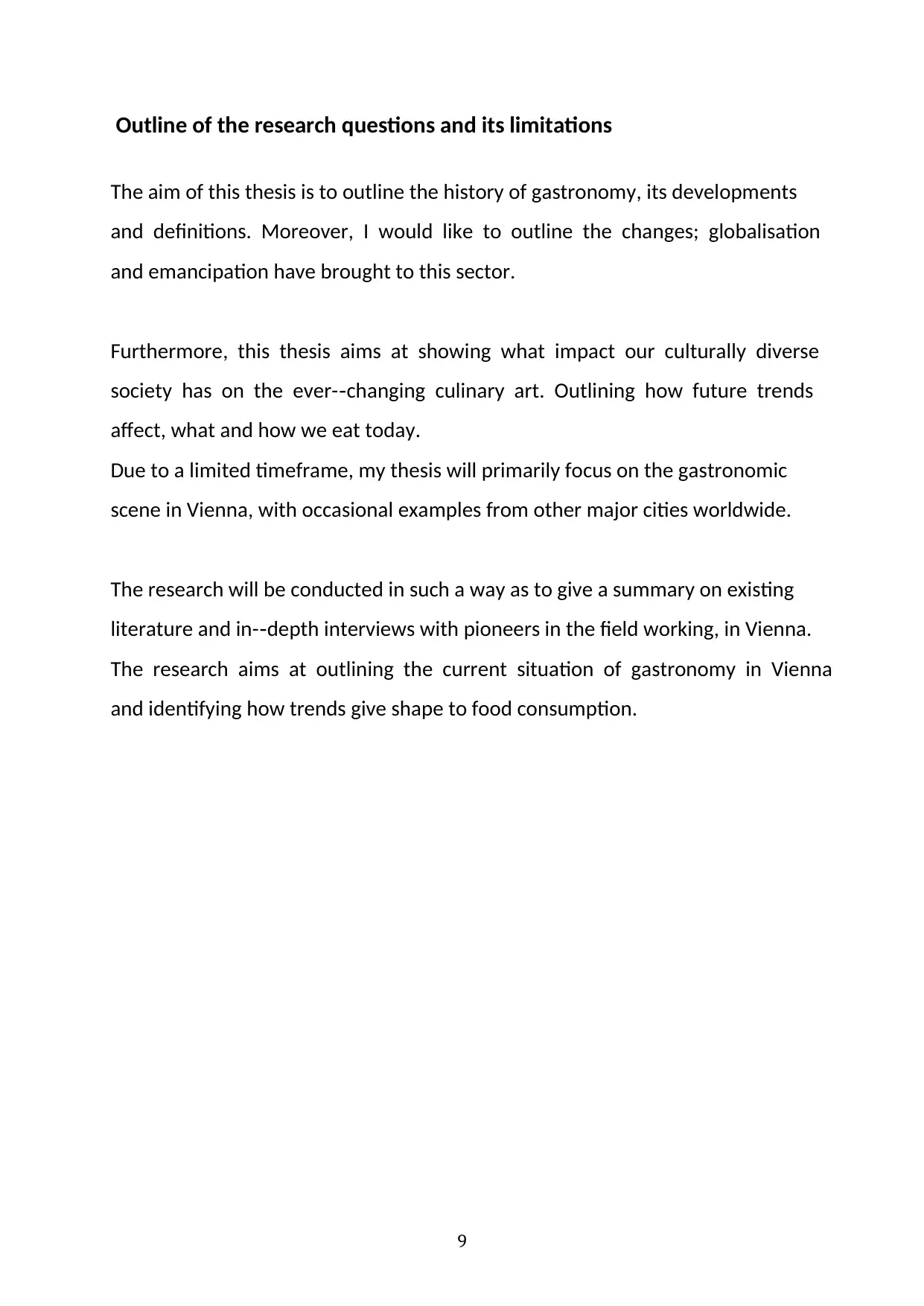
9
Outline of the research questions and its limitations
The aim of this thesis is to outline the history of gastronomy, its developments
and definitions. Moreover, I would like to outline the changes; globalisation
and emancipation have brought to this sector.
Furthermore, this thesis aims at showing what impact our culturally diverse
society has on the ever- changing culinary art. Outlining how future trends‐
affect, what and how we eat today.
Due to a limited timeframe, my thesis will primarily focus on the gastronomic
scene in Vienna, with occasional examples from other major cities worldwide.
The research will be conducted in such a way as to give a summary on existing
literature and in- depth interviews with pioneers in the field working, in Vienna.‐
The research aims at outlining the current situation of gastronomy in Vienna
and identifying how trends give shape to food consumption.
Outline of the research questions and its limitations
The aim of this thesis is to outline the history of gastronomy, its developments
and definitions. Moreover, I would like to outline the changes; globalisation
and emancipation have brought to this sector.
Furthermore, this thesis aims at showing what impact our culturally diverse
society has on the ever- changing culinary art. Outlining how future trends‐
affect, what and how we eat today.
Due to a limited timeframe, my thesis will primarily focus on the gastronomic
scene in Vienna, with occasional examples from other major cities worldwide.
The research will be conducted in such a way as to give a summary on existing
literature and in- depth interviews with pioneers in the field working, in Vienna.‐
The research aims at outlining the current situation of gastronomy in Vienna
and identifying how trends give shape to food consumption.
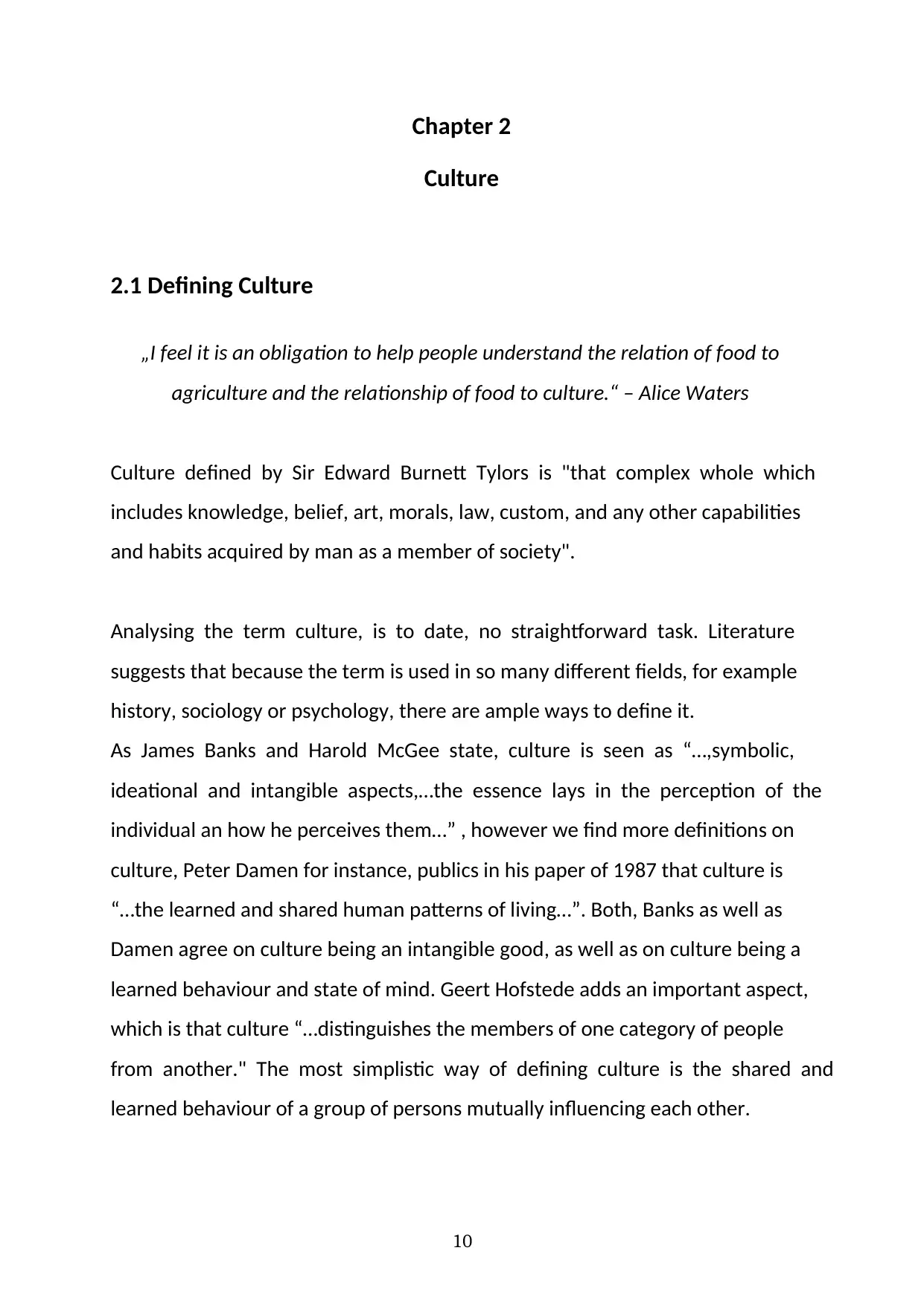
10
Chapter 2
Culture
2.1 Defining Culture
„I feel it is an obligation to help people understand the relation of food to
agriculture and the relationship of food to culture.“ – Alice Waters
Culture defined by Sir Edward Burnett Tylors is "that complex whole which
includes knowledge, belief, art, morals, law, custom, and any other capabilities
and habits acquired by man as a member of society".
Analysing the term culture, is to date, no straightforward task. Literature
suggests that because the term is used in so many different fields, for example
history, sociology or psychology, there are ample ways to define it.
As James Banks and Harold McGee state, culture is seen as “…,symbolic,
ideational and intangible aspects,…the essence lays in the perception of the
individual an how he perceives them…” , however we find more definitions on
culture, Peter Damen for instance, publics in his paper of 1987 that culture is
“…the learned and shared human patterns of living…”. Both, Banks as well as
Damen agree on culture being an intangible good, as well as on culture being a
learned behaviour and state of mind. Geert Hofstede adds an important aspect,
which is that culture “…distinguishes the members of one category of people
from another." The most simplistic way of defining culture is the shared and
learned behaviour of a group of persons mutually influencing each other.
Chapter 2
Culture
2.1 Defining Culture
„I feel it is an obligation to help people understand the relation of food to
agriculture and the relationship of food to culture.“ – Alice Waters
Culture defined by Sir Edward Burnett Tylors is "that complex whole which
includes knowledge, belief, art, morals, law, custom, and any other capabilities
and habits acquired by man as a member of society".
Analysing the term culture, is to date, no straightforward task. Literature
suggests that because the term is used in so many different fields, for example
history, sociology or psychology, there are ample ways to define it.
As James Banks and Harold McGee state, culture is seen as “…,symbolic,
ideational and intangible aspects,…the essence lays in the perception of the
individual an how he perceives them…” , however we find more definitions on
culture, Peter Damen for instance, publics in his paper of 1987 that culture is
“…the learned and shared human patterns of living…”. Both, Banks as well as
Damen agree on culture being an intangible good, as well as on culture being a
learned behaviour and state of mind. Geert Hofstede adds an important aspect,
which is that culture “…distinguishes the members of one category of people
from another." The most simplistic way of defining culture is the shared and
learned behaviour of a group of persons mutually influencing each other.
Secure Best Marks with AI Grader
Need help grading? Try our AI Grader for instant feedback on your assignments.
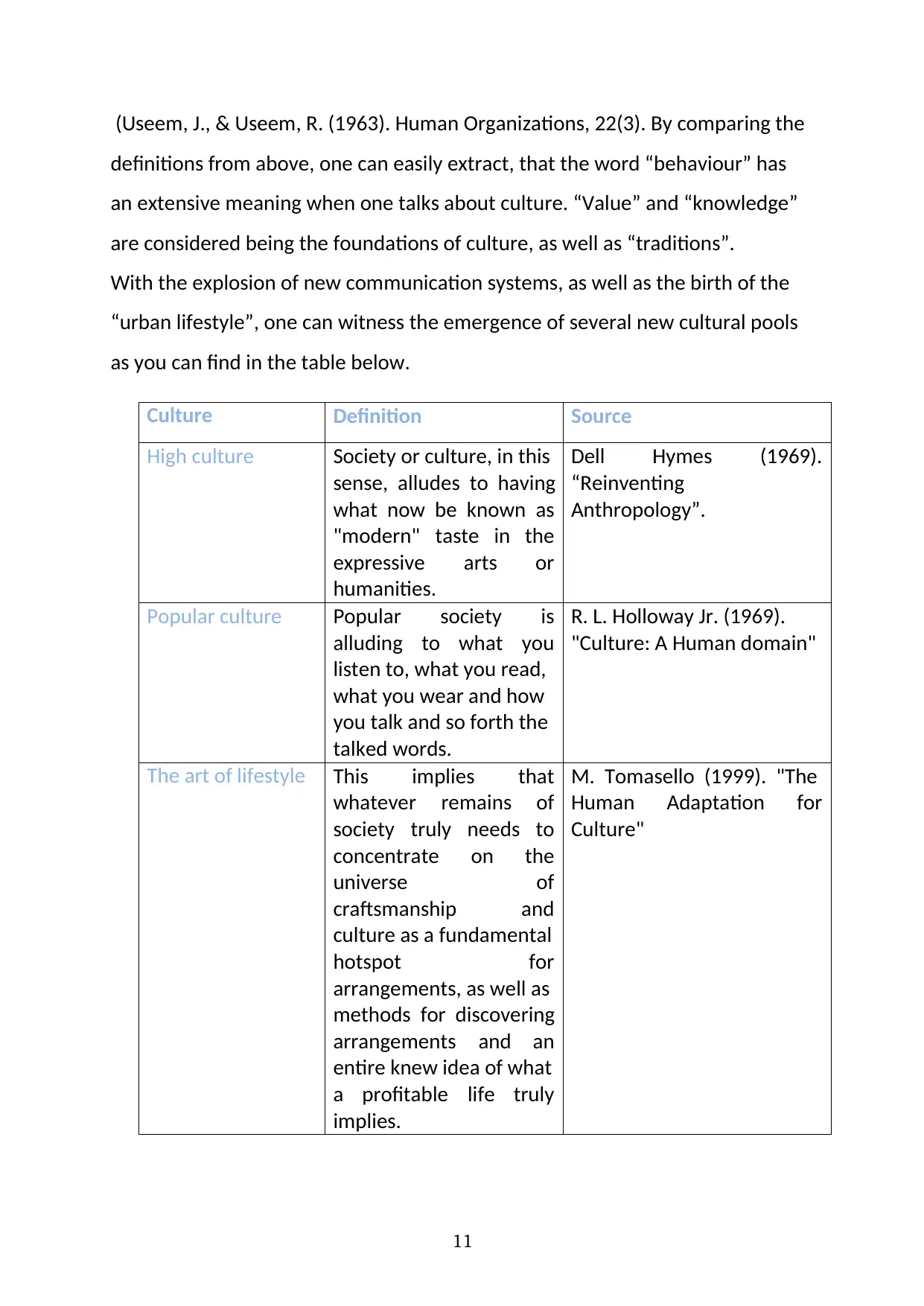
11
(Useem, J., & Useem, R. (1963). Human Organizations, 22(3). By comparing the
definitions from above, one can easily extract, that the word “behaviour” has
an extensive meaning when one talks about culture. “Value” and “knowledge”
are considered being the foundations of culture, as well as “traditions”.
With the explosion of new communication systems, as well as the birth of the
“urban lifestyle”, one can witness the emergence of several new cultural pools
as you can find in the table below.
Culture Definition Source
High culture Society or culture, in this
sense, alludes to having
what now be known as
"modern" taste in the
expressive arts or
humanities.
Dell Hymes (1969).
“Reinventing
Anthropology”.
Popular culture Popular society is
alluding to what you
listen to, what you read,
what you wear and how
you talk and so forth the
talked words.
R. L. Holloway Jr. (1969).
"Culture: A Human domain"
The art of lifestyle This implies that
whatever remains of
society truly needs to
concentrate on the
universe of
craftsmanship and
culture as a fundamental
hotspot for
arrangements, as well as
methods for discovering
arrangements and an
entire knew idea of what
a profitable life truly
implies.
M. Tomasello (1999). "The
Human Adaptation for
Culture"
(Useem, J., & Useem, R. (1963). Human Organizations, 22(3). By comparing the
definitions from above, one can easily extract, that the word “behaviour” has
an extensive meaning when one talks about culture. “Value” and “knowledge”
are considered being the foundations of culture, as well as “traditions”.
With the explosion of new communication systems, as well as the birth of the
“urban lifestyle”, one can witness the emergence of several new cultural pools
as you can find in the table below.
Culture Definition Source
High culture Society or culture, in this
sense, alludes to having
what now be known as
"modern" taste in the
expressive arts or
humanities.
Dell Hymes (1969).
“Reinventing
Anthropology”.
Popular culture Popular society is
alluding to what you
listen to, what you read,
what you wear and how
you talk and so forth the
talked words.
R. L. Holloway Jr. (1969).
"Culture: A Human domain"
The art of lifestyle This implies that
whatever remains of
society truly needs to
concentrate on the
universe of
craftsmanship and
culture as a fundamental
hotspot for
arrangements, as well as
methods for discovering
arrangements and an
entire knew idea of what
a profitable life truly
implies.
M. Tomasello (1999). "The
Human Adaptation for
Culture"
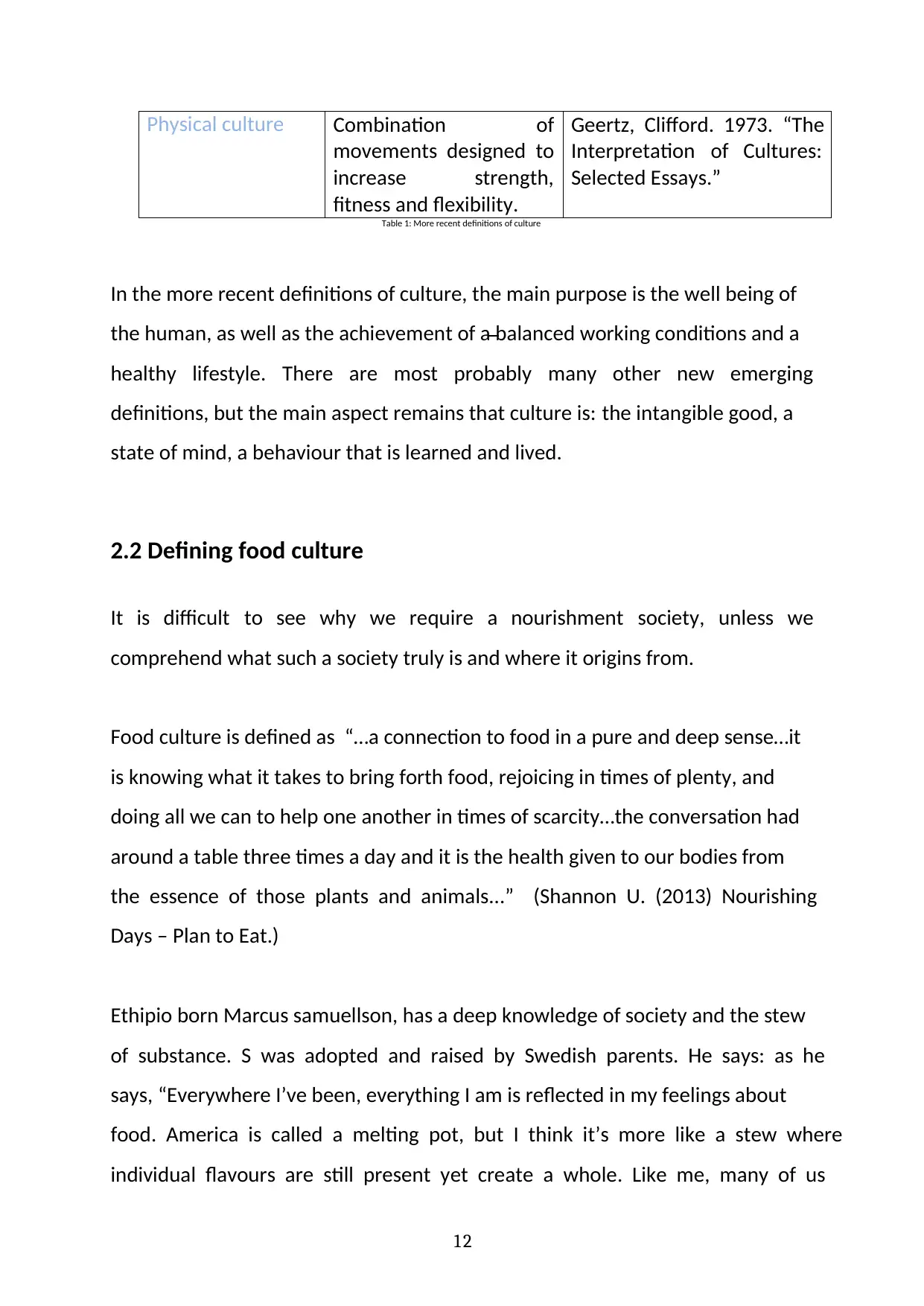
12
Table 1: More recent definitions of culture
In the more recent definitions of culture, the main purpose is the well being of
the human, as well as the achievement of a balanced working conditions and a
healthy lifestyle. There are most probably many other new emerging
definitions, but the main aspect remains that culture is: the intangible good, a
state of mind, a behaviour that is learned and lived.
2.2 Defining food culture
It is difficult to see why we require a nourishment society, unless we
comprehend what such a society truly is and where it origins from.
Food culture is defined as “…a connection to food in a pure and deep sense…it
is knowing what it takes to bring forth food, rejoicing in times of plenty, and
doing all we can to help one another in times of scarcity…the conversation had
around a table three times a day and it is the health given to our bodies from
the essence of those plants and animals...” (Shannon U. (2013) Nourishing
Days – Plan to Eat.)
Ethipio born Marcus samuellson, has a deep knowledge of society and the stew
of substance. S was adopted and raised by Swedish parents. He says: as he
says, “Everywhere I’ve been, everything I am is reflected in my feelings about
food. America is called a melting pot, but I think it’s more like a stew where
individual flavours are still present yet create a whole. Like me, many of us
Physical culture Combination of
movements designed to
increase strength,
fitness and flexibility.
Geertz, Clifford. 1973. “The
Interpretation of Cultures:
Selected Essays.”
Table 1: More recent definitions of culture
In the more recent definitions of culture, the main purpose is the well being of
the human, as well as the achievement of a balanced working conditions and a
healthy lifestyle. There are most probably many other new emerging
definitions, but the main aspect remains that culture is: the intangible good, a
state of mind, a behaviour that is learned and lived.
2.2 Defining food culture
It is difficult to see why we require a nourishment society, unless we
comprehend what such a society truly is and where it origins from.
Food culture is defined as “…a connection to food in a pure and deep sense…it
is knowing what it takes to bring forth food, rejoicing in times of plenty, and
doing all we can to help one another in times of scarcity…the conversation had
around a table three times a day and it is the health given to our bodies from
the essence of those plants and animals...” (Shannon U. (2013) Nourishing
Days – Plan to Eat.)
Ethipio born Marcus samuellson, has a deep knowledge of society and the stew
of substance. S was adopted and raised by Swedish parents. He says: as he
says, “Everywhere I’ve been, everything I am is reflected in my feelings about
food. America is called a melting pot, but I think it’s more like a stew where
individual flavours are still present yet create a whole. Like me, many of us
Physical culture Combination of
movements designed to
increase strength,
fitness and flexibility.
Geertz, Clifford. 1973. “The
Interpretation of Cultures:
Selected Essays.”
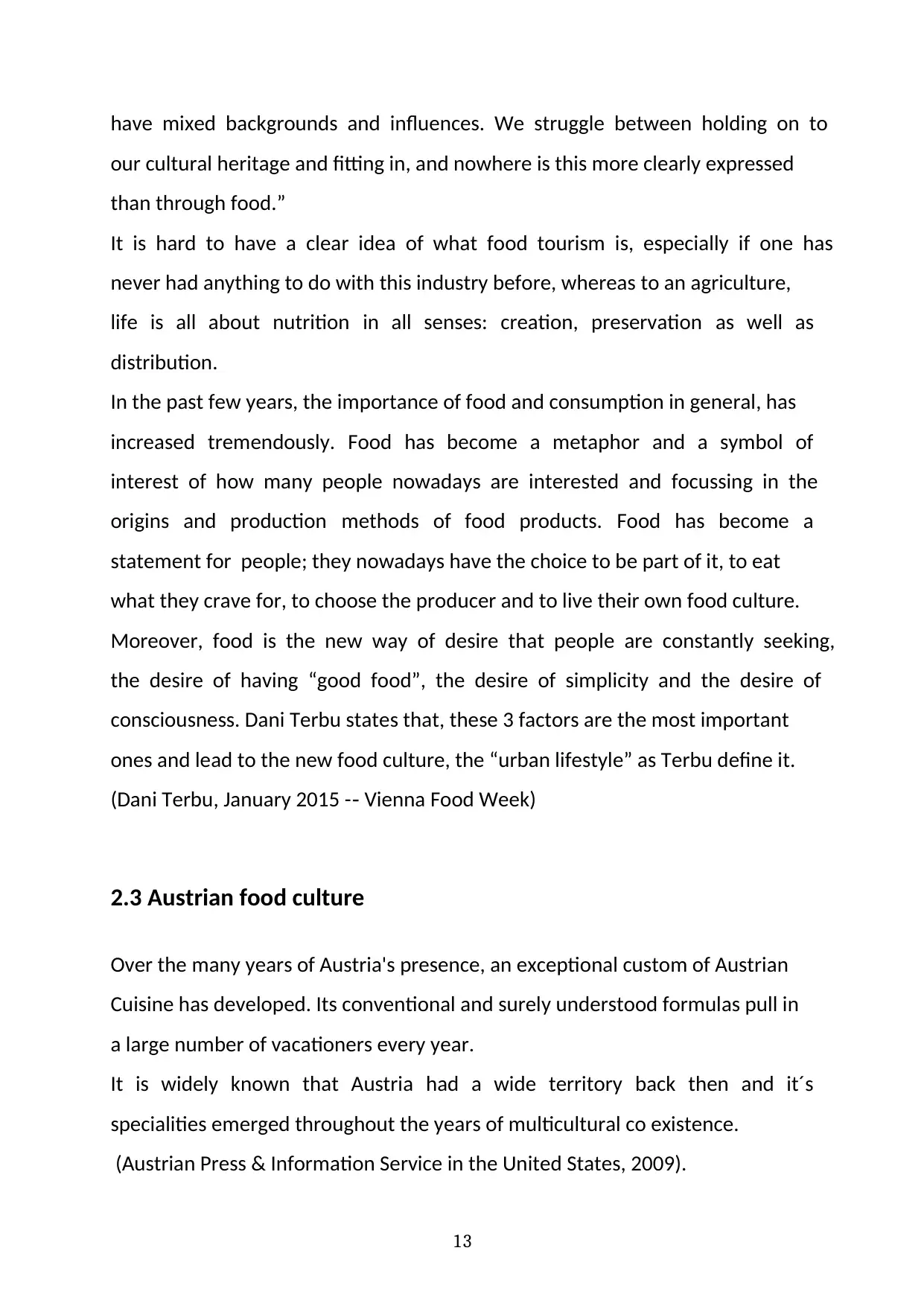
13
have mixed backgrounds and influences. We struggle between holding on to
our cultural heritage and fitting in, and nowhere is this more clearly expressed
than through food.”
It is hard to have a clear idea of what food tourism is, especially if one has
never had anything to do with this industry before, whereas to an agriculture,
life is all about nutrition in all senses: creation, preservation as well as
distribution.
In the past few years, the importance of food and consumption in general, has
increased tremendously. Food has become a metaphor and a symbol of
interest of how many people nowadays are interested and focussing in the
origins and production methods of food products. Food has become a
statement for people; they nowadays have the choice to be part of it, to eat
what they crave for, to choose the producer and to live their own food culture.
Moreover, food is the new way of desire that people are constantly seeking,
the desire of having “good food”, the desire of simplicity and the desire of
consciousness. Dani Terbu states that, these 3 factors are the most important
ones and lead to the new food culture, the “urban lifestyle” as Terbu define it.
(Dani Terbu, January 2015 - Vienna Food Week)‐
2.3 Austrian food culture
Over the many years of Austria's presence, an exceptional custom of Austrian
Cuisine has developed. Its conventional and surely understood formulas pull in
a large number of vacationers every year.
It is widely known that Austria had a wide territory back then and it´s
specialities emerged throughout the years of multicultural co existence.
(Austrian Press & Information Service in the United States, 2009).
have mixed backgrounds and influences. We struggle between holding on to
our cultural heritage and fitting in, and nowhere is this more clearly expressed
than through food.”
It is hard to have a clear idea of what food tourism is, especially if one has
never had anything to do with this industry before, whereas to an agriculture,
life is all about nutrition in all senses: creation, preservation as well as
distribution.
In the past few years, the importance of food and consumption in general, has
increased tremendously. Food has become a metaphor and a symbol of
interest of how many people nowadays are interested and focussing in the
origins and production methods of food products. Food has become a
statement for people; they nowadays have the choice to be part of it, to eat
what they crave for, to choose the producer and to live their own food culture.
Moreover, food is the new way of desire that people are constantly seeking,
the desire of having “good food”, the desire of simplicity and the desire of
consciousness. Dani Terbu states that, these 3 factors are the most important
ones and lead to the new food culture, the “urban lifestyle” as Terbu define it.
(Dani Terbu, January 2015 - Vienna Food Week)‐
2.3 Austrian food culture
Over the many years of Austria's presence, an exceptional custom of Austrian
Cuisine has developed. Its conventional and surely understood formulas pull in
a large number of vacationers every year.
It is widely known that Austria had a wide territory back then and it´s
specialities emerged throughout the years of multicultural co existence.
(Austrian Press & Information Service in the United States, 2009).
Paraphrase This Document
Need a fresh take? Get an instant paraphrase of this document with our AI Paraphraser
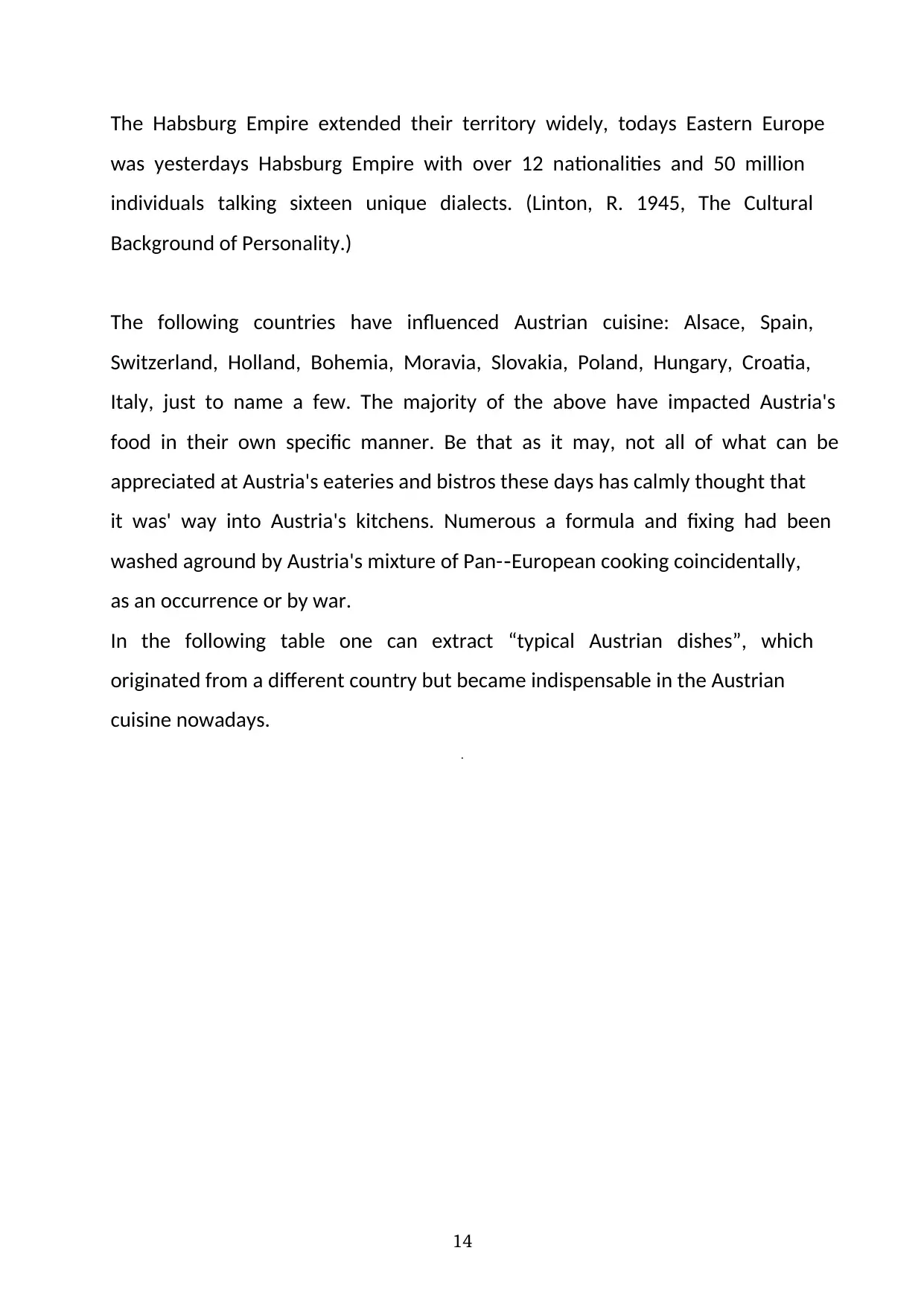
14
The Habsburg Empire extended their territory widely, todays Eastern Europe
was yesterdays Habsburg Empire with over 12 nationalities and 50 million
individuals talking sixteen unique dialects. (Linton, R. 1945, The Cultural
Background of Personality.)
The following countries have influenced Austrian cuisine: Alsace, Spain,
Switzerland, Holland, Bohemia, Moravia, Slovakia, Poland, Hungary, Croatia,
Italy, just to name a few. The majority of the above have impacted Austria's
food in their own specific manner. Be that as it may, not all of what can be
appreciated at Austria's eateries and bistros these days has calmly thought that
it was' way into Austria's kitchens. Numerous a formula and fixing had been
washed aground by Austria's mixture of Pan- European cooking coincidentally,‐
as an occurrence or by war.
In the following table one can extract “typical Austrian dishes”, which
originated from a different country but became indispensable in the Austrian
cuisine nowadays.
.
The Habsburg Empire extended their territory widely, todays Eastern Europe
was yesterdays Habsburg Empire with over 12 nationalities and 50 million
individuals talking sixteen unique dialects. (Linton, R. 1945, The Cultural
Background of Personality.)
The following countries have influenced Austrian cuisine: Alsace, Spain,
Switzerland, Holland, Bohemia, Moravia, Slovakia, Poland, Hungary, Croatia,
Italy, just to name a few. The majority of the above have impacted Austria's
food in their own specific manner. Be that as it may, not all of what can be
appreciated at Austria's eateries and bistros these days has calmly thought that
it was' way into Austria's kitchens. Numerous a formula and fixing had been
washed aground by Austria's mixture of Pan- European cooking coincidentally,‐
as an occurrence or by war.
In the following table one can extract “typical Austrian dishes”, which
originated from a different country but became indispensable in the Austrian
cuisine nowadays.
.
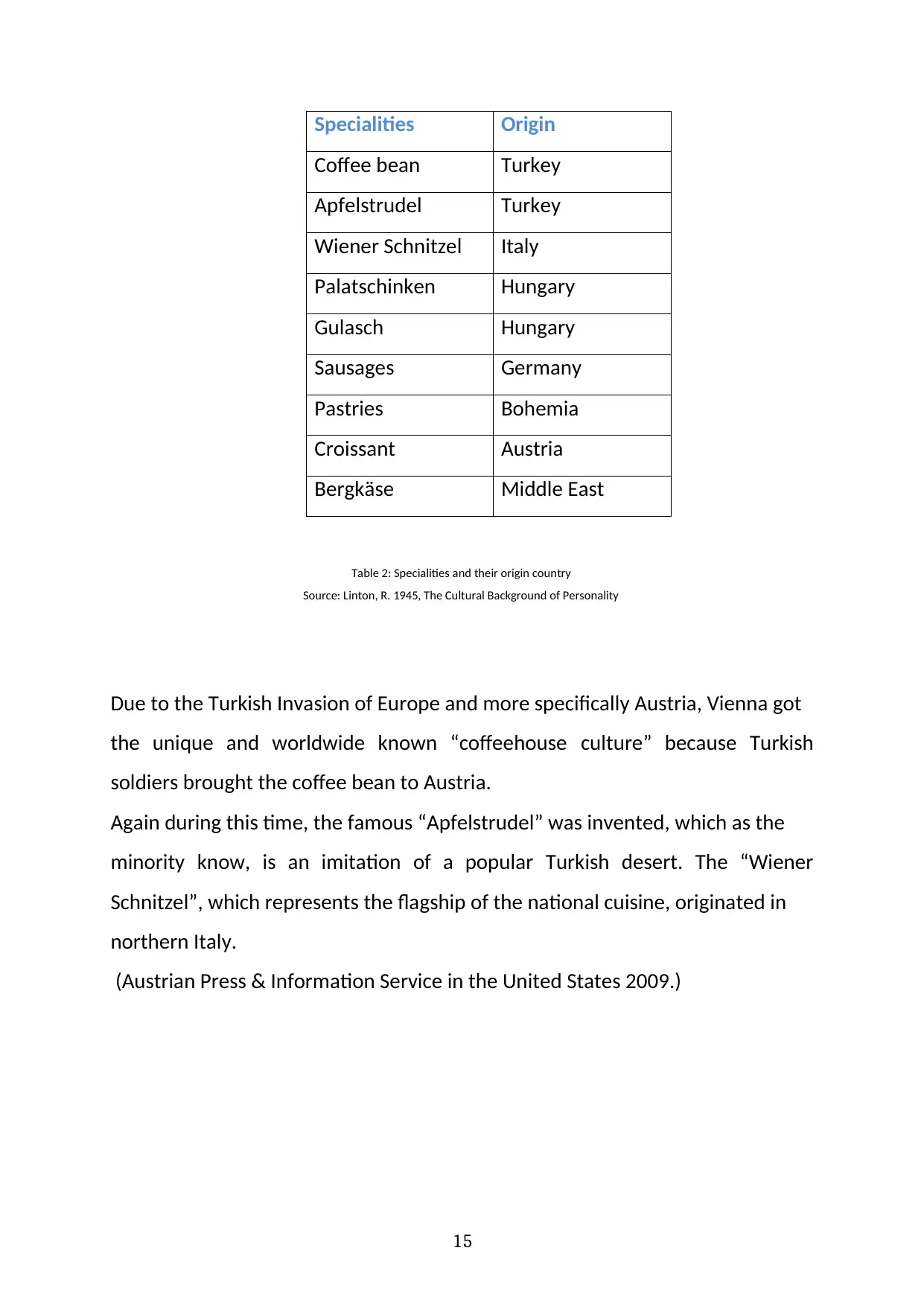
15
Table 2: Specialities and their origin country
Source: Linton, R. 1945, The Cultural Background of Personality
Due to the Turkish Invasion of Europe and more specifically Austria, Vienna got
the unique and worldwide known “coffeehouse culture” because Turkish
soldiers brought the coffee bean to Austria.
Again during this time, the famous “Apfelstrudel” was invented, which as the
minority know, is an imitation of a popular Turkish desert. The “Wiener
Schnitzel”, which represents the flagship of the national cuisine, originated in
northern Italy.
(Austrian Press & Information Service in the United States 2009.)
Specialities Origin
Coffee bean Turkey
Apfelstrudel Turkey
Wiener Schnitzel Italy
Palatschinken Hungary
Gulasch Hungary
Sausages Germany
Pastries Bohemia
Croissant Austria
Bergkäse Middle East
Table 2: Specialities and their origin country
Source: Linton, R. 1945, The Cultural Background of Personality
Due to the Turkish Invasion of Europe and more specifically Austria, Vienna got
the unique and worldwide known “coffeehouse culture” because Turkish
soldiers brought the coffee bean to Austria.
Again during this time, the famous “Apfelstrudel” was invented, which as the
minority know, is an imitation of a popular Turkish desert. The “Wiener
Schnitzel”, which represents the flagship of the national cuisine, originated in
northern Italy.
(Austrian Press & Information Service in the United States 2009.)
Specialities Origin
Coffee bean Turkey
Apfelstrudel Turkey
Wiener Schnitzel Italy
Palatschinken Hungary
Gulasch Hungary
Sausages Germany
Pastries Bohemia
Croissant Austria
Bergkäse Middle East
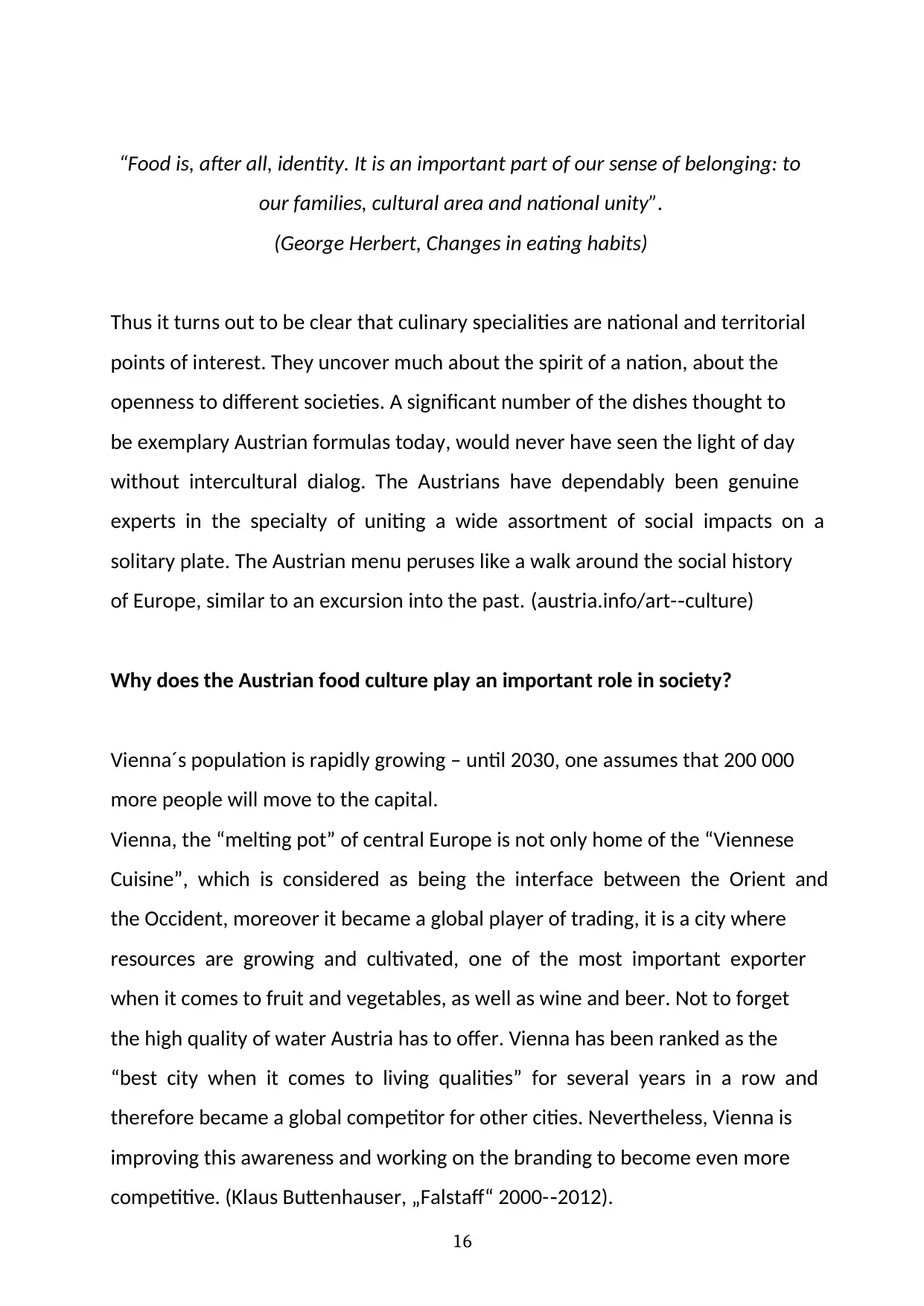
16
“Food is, after all, identity. It is an important part of our sense of belonging: to
our families, cultural area and national unity”.
(George Herbert, Changes in eating habits)
Thus it turns out to be clear that culinary specialities are national and territorial
points of interest. They uncover much about the spirit of a nation, about the
openness to different societies. A significant number of the dishes thought to
be exemplary Austrian formulas today, would never have seen the light of day
without intercultural dialog. The Austrians have dependably been genuine
experts in the specialty of uniting a wide assortment of social impacts on a
solitary plate. The Austrian menu peruses like a walk around the social history
of Europe, similar to an excursion into the past. (austria.info/art- culture)‐
Why does the Austrian food culture play an important role in society?
Vienna´s population is rapidly growing – until 2030, one assumes that 200 000
more people will move to the capital.
Vienna, the “melting pot” of central Europe is not only home of the “Viennese
Cuisine”, which is considered as being the interface between the Orient and
the Occident, moreover it became a global player of trading, it is a city where
resources are growing and cultivated, one of the most important exporter
when it comes to fruit and vegetables, as well as wine and beer. Not to forget
the high quality of water Austria has to offer. Vienna has been ranked as the
“best city when it comes to living qualities” for several years in a row and
therefore became a global competitor for other cities. Nevertheless, Vienna is
improving this awareness and working on the branding to become even more
competitive. (Klaus Buttenhauser, „Falstaff“ 2000- 2012).‐
“Food is, after all, identity. It is an important part of our sense of belonging: to
our families, cultural area and national unity”.
(George Herbert, Changes in eating habits)
Thus it turns out to be clear that culinary specialities are national and territorial
points of interest. They uncover much about the spirit of a nation, about the
openness to different societies. A significant number of the dishes thought to
be exemplary Austrian formulas today, would never have seen the light of day
without intercultural dialog. The Austrians have dependably been genuine
experts in the specialty of uniting a wide assortment of social impacts on a
solitary plate. The Austrian menu peruses like a walk around the social history
of Europe, similar to an excursion into the past. (austria.info/art- culture)‐
Why does the Austrian food culture play an important role in society?
Vienna´s population is rapidly growing – until 2030, one assumes that 200 000
more people will move to the capital.
Vienna, the “melting pot” of central Europe is not only home of the “Viennese
Cuisine”, which is considered as being the interface between the Orient and
the Occident, moreover it became a global player of trading, it is a city where
resources are growing and cultivated, one of the most important exporter
when it comes to fruit and vegetables, as well as wine and beer. Not to forget
the high quality of water Austria has to offer. Vienna has been ranked as the
“best city when it comes to living qualities” for several years in a row and
therefore became a global competitor for other cities. Nevertheless, Vienna is
improving this awareness and working on the branding to become even more
competitive. (Klaus Buttenhauser, „Falstaff“ 2000- 2012).‐
Secure Best Marks with AI Grader
Need help grading? Try our AI Grader for instant feedback on your assignments.
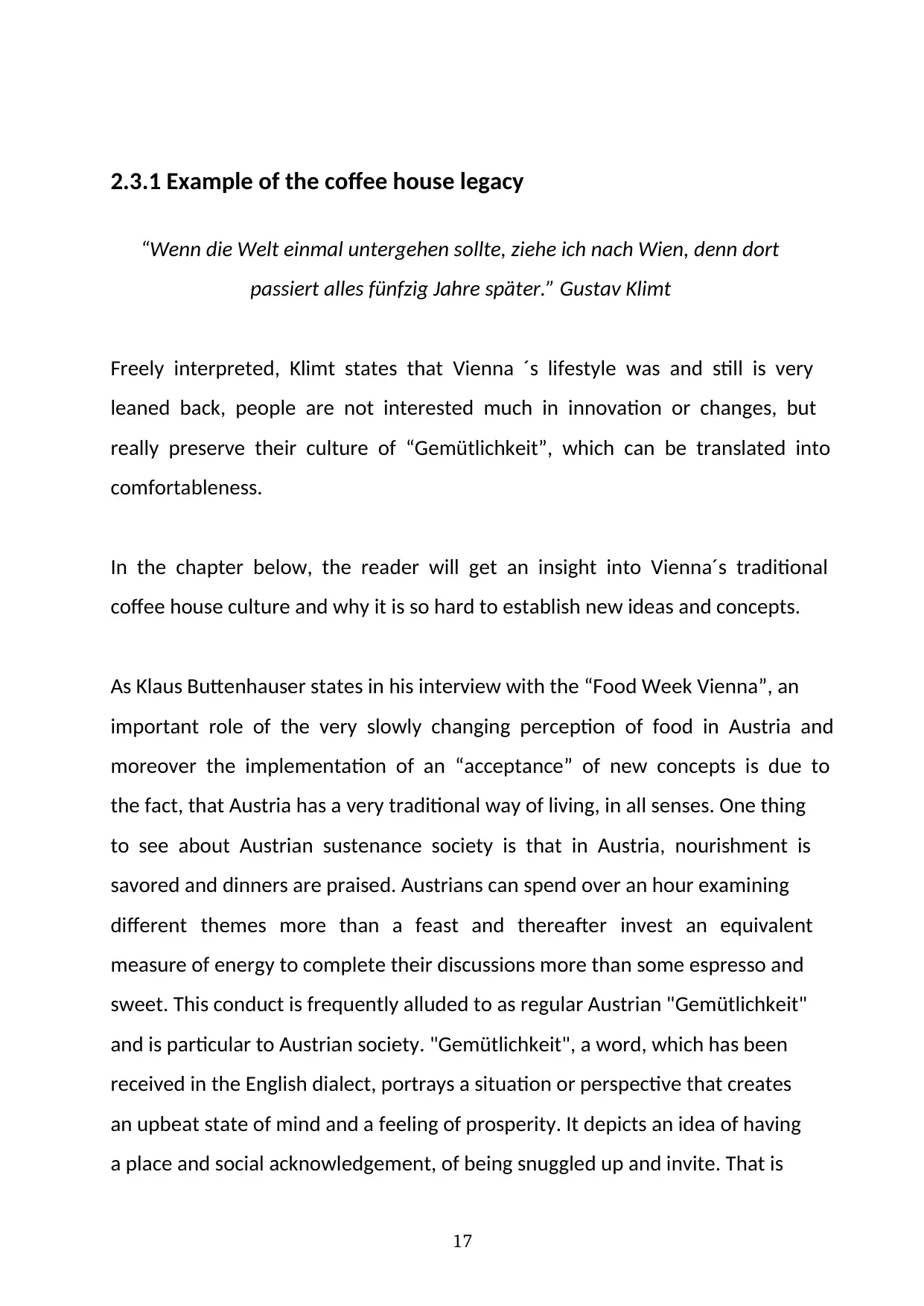
17
2.3.1 Example of the coffee house legacy
“Wenn die Welt einmal untergehen sollte, ziehe ich nach Wien, denn dort
passiert alles fünfzig Jahre später.” Gustav Klimt
Freely interpreted, Klimt states that Vienna ´s lifestyle was and still is very
leaned back, people are not interested much in innovation or changes, but
really preserve their culture of “Gemütlichkeit”, which can be translated into
comfortableness.
In the chapter below, the reader will get an insight into Vienna´s traditional
coffee house culture and why it is so hard to establish new ideas and concepts.
As Klaus Buttenhauser states in his interview with the “Food Week Vienna”, an
important role of the very slowly changing perception of food in Austria and
moreover the implementation of an “acceptance” of new concepts is due to
the fact, that Austria has a very traditional way of living, in all senses. One thing
to see about Austrian sustenance society is that in Austria, nourishment is
savored and dinners are praised. Austrians can spend over an hour examining
different themes more than a feast and thereafter invest an equivalent
measure of energy to complete their discussions more than some espresso and
sweet. This conduct is frequently alluded to as regular Austrian "Gemütlichkeit"
and is particular to Austrian society. "Gemütlichkeit", a word, which has been
received in the English dialect, portrays a situation or perspective that creates
an upbeat state of mind and a feeling of prosperity. It depicts an idea of having
a place and social acknowledgement, of being snuggled up and invite. That is
2.3.1 Example of the coffee house legacy
“Wenn die Welt einmal untergehen sollte, ziehe ich nach Wien, denn dort
passiert alles fünfzig Jahre später.” Gustav Klimt
Freely interpreted, Klimt states that Vienna ´s lifestyle was and still is very
leaned back, people are not interested much in innovation or changes, but
really preserve their culture of “Gemütlichkeit”, which can be translated into
comfortableness.
In the chapter below, the reader will get an insight into Vienna´s traditional
coffee house culture and why it is so hard to establish new ideas and concepts.
As Klaus Buttenhauser states in his interview with the “Food Week Vienna”, an
important role of the very slowly changing perception of food in Austria and
moreover the implementation of an “acceptance” of new concepts is due to
the fact, that Austria has a very traditional way of living, in all senses. One thing
to see about Austrian sustenance society is that in Austria, nourishment is
savored and dinners are praised. Austrians can spend over an hour examining
different themes more than a feast and thereafter invest an equivalent
measure of energy to complete their discussions more than some espresso and
sweet. This conduct is frequently alluded to as regular Austrian "Gemütlichkeit"
and is particular to Austrian society. "Gemütlichkeit", a word, which has been
received in the English dialect, portrays a situation or perspective that creates
an upbeat state of mind and a feeling of prosperity. It depicts an idea of having
a place and social acknowledgement, of being snuggled up and invite. That is
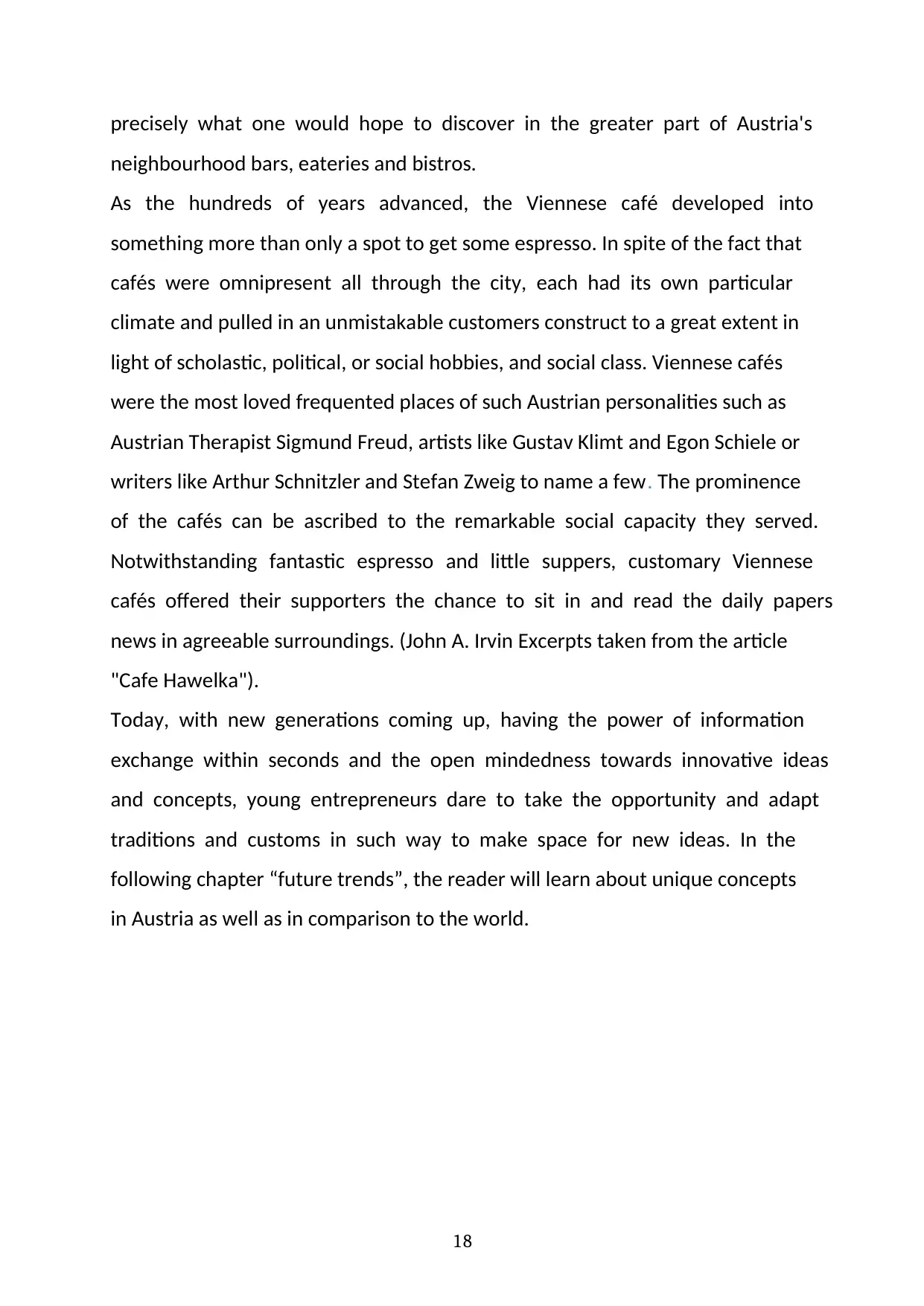
18
precisely what one would hope to discover in the greater part of Austria's
neighbourhood bars, eateries and bistros.
As the hundreds of years advanced, the Viennese café developed into
something more than only a spot to get some espresso. In spite of the fact that
cafés were omnipresent all through the city, each had its own particular
climate and pulled in an unmistakable customers construct to a great extent in
light of scholastic, political, or social hobbies, and social class. Viennese cafés
were the most loved frequented places of such Austrian personalities such as
Austrian Therapist Sigmund Freud, artists like Gustav Klimt and Egon Schiele or
writers like Arthur Schnitzler and Stefan Zweig to name a few. The prominence
of the cafés can be ascribed to the remarkable social capacity they served.
Notwithstanding fantastic espresso and little suppers, customary Viennese
cafés offered their supporters the chance to sit in and read the daily papers
news in agreeable surroundings. (John A. Irvin Excerpts taken from the article
"Cafe Hawelka").
Today, with new generations coming up, having the power of information
exchange within seconds and the open mindedness towards innovative ideas
and concepts, young entrepreneurs dare to take the opportunity and adapt
traditions and customs in such way to make space for new ideas. In the
following chapter “future trends”, the reader will learn about unique concepts
in Austria as well as in comparison to the world.
precisely what one would hope to discover in the greater part of Austria's
neighbourhood bars, eateries and bistros.
As the hundreds of years advanced, the Viennese café developed into
something more than only a spot to get some espresso. In spite of the fact that
cafés were omnipresent all through the city, each had its own particular
climate and pulled in an unmistakable customers construct to a great extent in
light of scholastic, political, or social hobbies, and social class. Viennese cafés
were the most loved frequented places of such Austrian personalities such as
Austrian Therapist Sigmund Freud, artists like Gustav Klimt and Egon Schiele or
writers like Arthur Schnitzler and Stefan Zweig to name a few. The prominence
of the cafés can be ascribed to the remarkable social capacity they served.
Notwithstanding fantastic espresso and little suppers, customary Viennese
cafés offered their supporters the chance to sit in and read the daily papers
news in agreeable surroundings. (John A. Irvin Excerpts taken from the article
"Cafe Hawelka").
Today, with new generations coming up, having the power of information
exchange within seconds and the open mindedness towards innovative ideas
and concepts, young entrepreneurs dare to take the opportunity and adapt
traditions and customs in such way to make space for new ideas. In the
following chapter “future trends”, the reader will learn about unique concepts
in Austria as well as in comparison to the world.
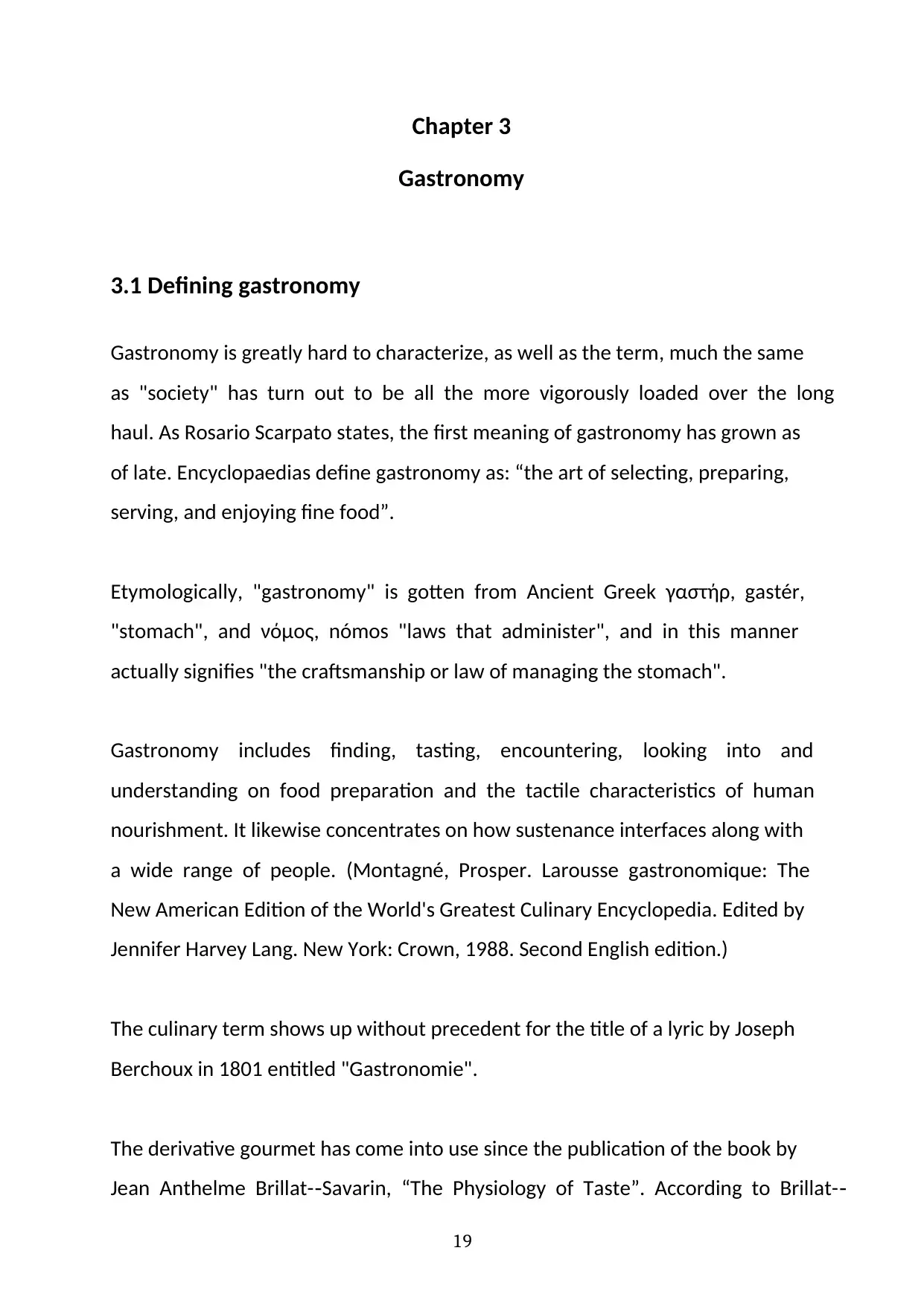
19
Chapter 3
Gastronomy
3.1 Defining gastronomy
Gastronomy is greatly hard to characterize, as well as the term, much the same
as "society" has turn out to be all the more vigorously loaded over the long
haul. As Rosario Scarpato states, the first meaning of gastronomy has grown as
of late. Encyclopaedias define gastronomy as: “the art of selecting, preparing,
serving, and enjoying fine food”.
Etymologically, "gastronomy" is gotten from Ancient Greek γαστήρ, gastér,
"stomach", and νόμος, nómos "laws that administer", and in this manner
actually signifies "the craftsmanship or law of managing the stomach".
Gastronomy includes finding, tasting, encountering, looking into and
understanding on food preparation and the tactile characteristics of human
nourishment. It likewise concentrates on how sustenance interfaces along with
a wide range of people. (Montagné, Prosper. Larousse gastronomique: The
New American Edition of the World's Greatest Culinary Encyclopedia. Edited by
Jennifer Harvey Lang. New York: Crown, 1988. Second English edition.)
The culinary term shows up without precedent for the title of a lyric by Joseph
Berchoux in 1801 entitled "Gastronomie".
The derivative gourmet has come into use since the publication of the book by
Jean Anthelme Brillat- Savarin, “The Physiology of Taste”. According to Brillat-‐ ‐
Chapter 3
Gastronomy
3.1 Defining gastronomy
Gastronomy is greatly hard to characterize, as well as the term, much the same
as "society" has turn out to be all the more vigorously loaded over the long
haul. As Rosario Scarpato states, the first meaning of gastronomy has grown as
of late. Encyclopaedias define gastronomy as: “the art of selecting, preparing,
serving, and enjoying fine food”.
Etymologically, "gastronomy" is gotten from Ancient Greek γαστήρ, gastér,
"stomach", and νόμος, nómos "laws that administer", and in this manner
actually signifies "the craftsmanship or law of managing the stomach".
Gastronomy includes finding, tasting, encountering, looking into and
understanding on food preparation and the tactile characteristics of human
nourishment. It likewise concentrates on how sustenance interfaces along with
a wide range of people. (Montagné, Prosper. Larousse gastronomique: The
New American Edition of the World's Greatest Culinary Encyclopedia. Edited by
Jennifer Harvey Lang. New York: Crown, 1988. Second English edition.)
The culinary term shows up without precedent for the title of a lyric by Joseph
Berchoux in 1801 entitled "Gastronomie".
The derivative gourmet has come into use since the publication of the book by
Jean Anthelme Brillat- Savarin, “The Physiology of Taste”. According to Brillat-‐ ‐
Paraphrase This Document
Need a fresh take? Get an instant paraphrase of this document with our AI Paraphraser

20
Savarin, "Gastronomy is the knowledge and understanding of all that relates to
man as he eats. Its purpose is to ensure the conservation of men, using the
best food possible."
3.2 Development of gastronomy
Cooking has incredibly developed throughout the hundreds of years, and all the
more particularly since the Renaissance, which denoted the begin of more
expound, imaginative cooking, with already obscure items originating from the
New World, for example, chocolate, beans, pepper and later tomatoes, corn
and potatoes. After the French Revolution, which assumed a conclusive part in
abrogating exchange organizations, Marie- Antoine‐ Carêrme added to the
refinement of French food. He streamlined and arranged a food that was
extremely unpredictable at the time, through a few noteworthy works. (Le
Maître d’hôtel français, Le Cuisinier parisien, L’Art de la cuisine française au
XIXe siècle).
The modernization and organization of French gastronomy is generally
attributed to Georges Auguste Escoffier, who simplified the modern menu and
the structure of meals.
Cooking is continually being modernized, supported by science and innovation,
for case with the revelation of cleansing by warm handling in hermetically fixed
jars, which implied that nourishments could be saved, then the entry of the
first gas cookers in the 19th century, then the first ice chest, and so forth.
In the late 1960s and the beginning of 1970s, renowned chefs like Paul Boscue
or Michel Guérard founded the term “nouvelle cuisine” which was
characterized by lighter dishes, experimenting with ingredients and falvours.
Savarin, "Gastronomy is the knowledge and understanding of all that relates to
man as he eats. Its purpose is to ensure the conservation of men, using the
best food possible."
3.2 Development of gastronomy
Cooking has incredibly developed throughout the hundreds of years, and all the
more particularly since the Renaissance, which denoted the begin of more
expound, imaginative cooking, with already obscure items originating from the
New World, for example, chocolate, beans, pepper and later tomatoes, corn
and potatoes. After the French Revolution, which assumed a conclusive part in
abrogating exchange organizations, Marie- Antoine‐ Carêrme added to the
refinement of French food. He streamlined and arranged a food that was
extremely unpredictable at the time, through a few noteworthy works. (Le
Maître d’hôtel français, Le Cuisinier parisien, L’Art de la cuisine française au
XIXe siècle).
The modernization and organization of French gastronomy is generally
attributed to Georges Auguste Escoffier, who simplified the modern menu and
the structure of meals.
Cooking is continually being modernized, supported by science and innovation,
for case with the revelation of cleansing by warm handling in hermetically fixed
jars, which implied that nourishments could be saved, then the entry of the
first gas cookers in the 19th century, then the first ice chest, and so forth.
In the late 1960s and the beginning of 1970s, renowned chefs like Paul Boscue
or Michel Guérard founded the term “nouvelle cuisine” which was
characterized by lighter dishes, experimenting with ingredients and falvours.

21
In the same way as different administrations and "encounters" offered to
(post) advanced customers, a particular arrangement of generation,
conveyance and presentation has risen that can be described as one of the
“social commercial enterprises”.
In the social business of gastronomy the quality bind is being stretched out to
incorporate an extensive variety of financial exercises, a considerable lot of
which are identified with tourism. (Blank Fritz, “Gastronomy”).
Nowadays food and personal identity are closely connected. In other words,
“what we eat is who we are”, for instance, vegan food covers more then our
basic need to eat, it has become a lifestyle. A further example would be the
trend for organic food, which flows into the clothing industry. Furthermore,
certain childhood treats become our adult comfort food. Changing our eating
habits is perceived, psychologically, stripping away of our identity, on a
regional, personal and national level. Tourists perceive food as an oral intake of
the destinations culture. Nevertheless, tourists tend to eat the same way they
would at home. For example, study show that English sightseers like to go to
pubs or some even bring food from home on their vacation. (Anne- Mette‐
Hjalager, Greg Richards - Tourism and Gastronomy.)‐
Sustenance has been utilized, as a method for producing and supporting
personalities, chiefly in light of the fact that what we eat and the way we eat
are such essential parts of our way of life. As Hjalager brings up, dietary
patterns are "… parochial practices that are found out and socially bound." In
Brief clarification this implies in a straightforward case: a few Catholics still
keep away from meat on Friday, as a demonstration of penitence, thus
frequently eat angle on this day, Moslems and Jews refrain from eating pork,
while Hindus, because the cow is holy to them, will not eat beef.
In the same way as different administrations and "encounters" offered to
(post) advanced customers, a particular arrangement of generation,
conveyance and presentation has risen that can be described as one of the
“social commercial enterprises”.
In the social business of gastronomy the quality bind is being stretched out to
incorporate an extensive variety of financial exercises, a considerable lot of
which are identified with tourism. (Blank Fritz, “Gastronomy”).
Nowadays food and personal identity are closely connected. In other words,
“what we eat is who we are”, for instance, vegan food covers more then our
basic need to eat, it has become a lifestyle. A further example would be the
trend for organic food, which flows into the clothing industry. Furthermore,
certain childhood treats become our adult comfort food. Changing our eating
habits is perceived, psychologically, stripping away of our identity, on a
regional, personal and national level. Tourists perceive food as an oral intake of
the destinations culture. Nevertheless, tourists tend to eat the same way they
would at home. For example, study show that English sightseers like to go to
pubs or some even bring food from home on their vacation. (Anne- Mette‐
Hjalager, Greg Richards - Tourism and Gastronomy.)‐
Sustenance has been utilized, as a method for producing and supporting
personalities, chiefly in light of the fact that what we eat and the way we eat
are such essential parts of our way of life. As Hjalager brings up, dietary
patterns are "… parochial practices that are found out and socially bound." In
Brief clarification this implies in a straightforward case: a few Catholics still
keep away from meat on Friday, as a demonstration of penitence, thus
frequently eat angle on this day, Moslems and Jews refrain from eating pork,
while Hindus, because the cow is holy to them, will not eat beef.
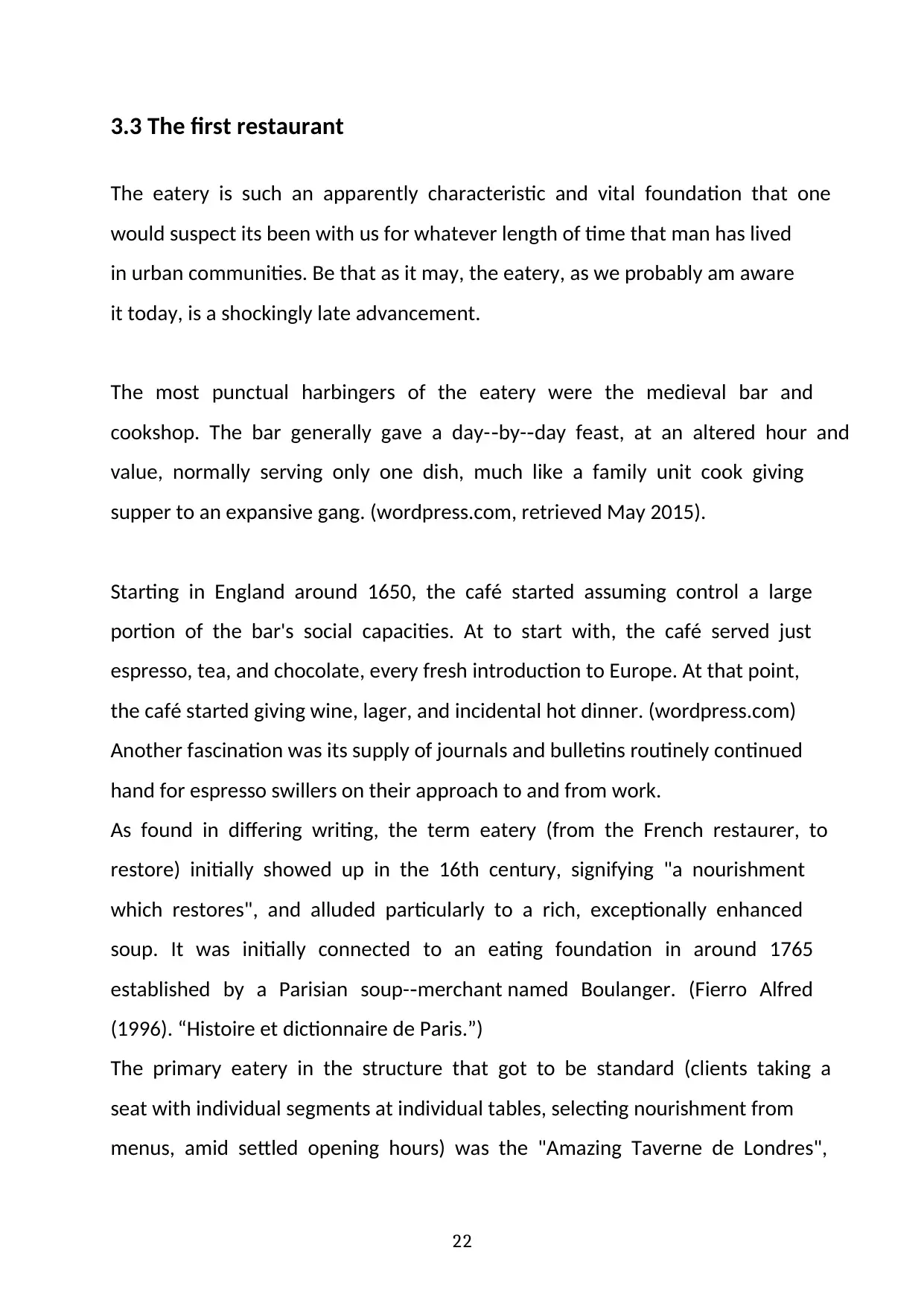
22
3.3 The first restaurant
The eatery is such an apparently characteristic and vital foundation that one
would suspect its been with us for whatever length of time that man has lived
in urban communities. Be that as it may, the eatery, as we probably am aware
it today, is a shockingly late advancement.
The most punctual harbingers of the eatery were the medieval bar and
cookshop. The bar generally gave a day- by- day feast, at an altered hour and‐ ‐
value, normally serving only one dish, much like a family unit cook giving
supper to an expansive gang. (wordpress.com, retrieved May 2015).
Starting in England around 1650, the café started assuming control a large
portion of the bar's social capacities. At to start with, the café served just
espresso, tea, and chocolate, every fresh introduction to Europe. At that point,
the café started giving wine, lager, and incidental hot dinner. (wordpress.com)
Another fascination was its supply of journals and bulletins routinely continued
hand for espresso swillers on their approach to and from work.
As found in differing writing, the term eatery (from the French restaurer, to
restore) initially showed up in the 16th century, signifying "a nourishment
which restores", and alluded particularly to a rich, exceptionally enhanced
soup. It was initially connected to an eating foundation in around 1765
established by a Parisian soup- merchant‐ named Boulanger. (Fierro Alfred
(1996). “Histoire et dictionnaire de Paris.”)
The primary eatery in the structure that got to be standard (clients taking a
seat with individual segments at individual tables, selecting nourishment from
menus, amid settled opening hours) was the "Amazing Taverne de Londres",
3.3 The first restaurant
The eatery is such an apparently characteristic and vital foundation that one
would suspect its been with us for whatever length of time that man has lived
in urban communities. Be that as it may, the eatery, as we probably am aware
it today, is a shockingly late advancement.
The most punctual harbingers of the eatery were the medieval bar and
cookshop. The bar generally gave a day- by- day feast, at an altered hour and‐ ‐
value, normally serving only one dish, much like a family unit cook giving
supper to an expansive gang. (wordpress.com, retrieved May 2015).
Starting in England around 1650, the café started assuming control a large
portion of the bar's social capacities. At to start with, the café served just
espresso, tea, and chocolate, every fresh introduction to Europe. At that point,
the café started giving wine, lager, and incidental hot dinner. (wordpress.com)
Another fascination was its supply of journals and bulletins routinely continued
hand for espresso swillers on their approach to and from work.
As found in differing writing, the term eatery (from the French restaurer, to
restore) initially showed up in the 16th century, signifying "a nourishment
which restores", and alluded particularly to a rich, exceptionally enhanced
soup. It was initially connected to an eating foundation in around 1765
established by a Parisian soup- merchant‐ named Boulanger. (Fierro Alfred
(1996). “Histoire et dictionnaire de Paris.”)
The primary eatery in the structure that got to be standard (clients taking a
seat with individual segments at individual tables, selecting nourishment from
menus, amid settled opening hours) was the "Amazing Taverne de Londres",
Secure Best Marks with AI Grader
Need help grading? Try our AI Grader for instant feedback on your assignments.
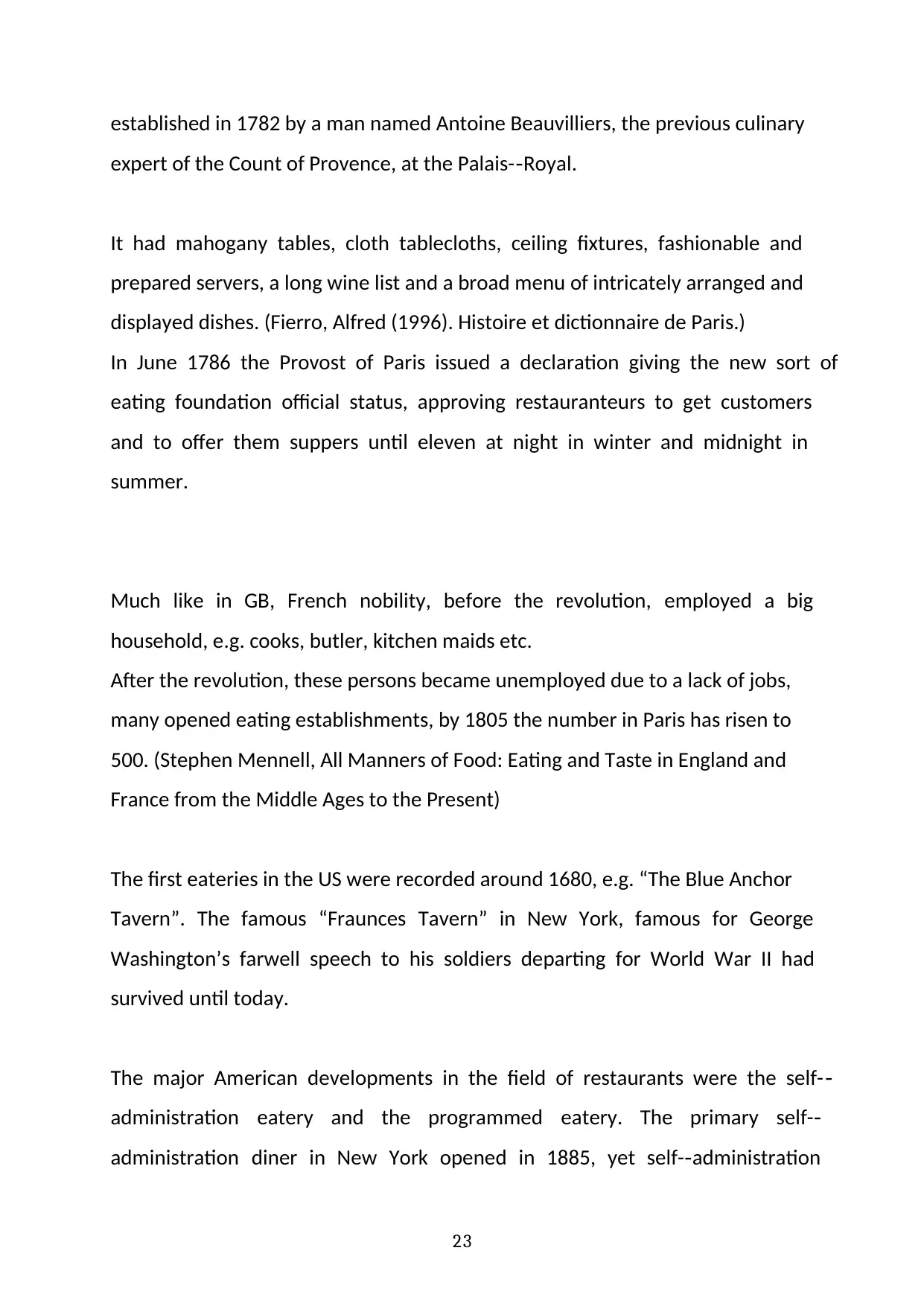
23
established in 1782 by a man named Antoine Beauvilliers, the previous culinary
expert of the Count of Provence, at the Palais- Royal.‐
It had mahogany tables, cloth tablecloths, ceiling fixtures, fashionable and
prepared servers, a long wine list and a broad menu of intricately arranged and
displayed dishes. (Fierro, Alfred (1996). Histoire et dictionnaire de Paris.)
In June 1786 the Provost of Paris issued a declaration giving the new sort of
eating foundation official status, approving restauranteurs to get customers
and to offer them suppers until eleven at night in winter and midnight in
summer.
Much like in GB, French nobility, before the revolution, employed a big
household, e.g. cooks, butler, kitchen maids etc.
After the revolution, these persons became unemployed due to a lack of jobs,
many opened eating establishments, by 1805 the number in Paris has risen to
500. (Stephen Mennell, All Manners of Food: Eating and Taste in England and
France from the Middle Ages to the Present)
The first eateries in the US were recorded around 1680, e.g. “The Blue Anchor
Tavern”. The famous “Fraunces Tavern” in New York, famous for George
Washington’s farwell speech to his soldiers departing for World War II had
survived until today.
The major American developments in the field of restaurants were the self- ‐
administration eatery and the programmed eatery. The primary self-‐
administration diner in New York opened in 1885, yet self- administration‐
established in 1782 by a man named Antoine Beauvilliers, the previous culinary
expert of the Count of Provence, at the Palais- Royal.‐
It had mahogany tables, cloth tablecloths, ceiling fixtures, fashionable and
prepared servers, a long wine list and a broad menu of intricately arranged and
displayed dishes. (Fierro, Alfred (1996). Histoire et dictionnaire de Paris.)
In June 1786 the Provost of Paris issued a declaration giving the new sort of
eating foundation official status, approving restauranteurs to get customers
and to offer them suppers until eleven at night in winter and midnight in
summer.
Much like in GB, French nobility, before the revolution, employed a big
household, e.g. cooks, butler, kitchen maids etc.
After the revolution, these persons became unemployed due to a lack of jobs,
many opened eating establishments, by 1805 the number in Paris has risen to
500. (Stephen Mennell, All Manners of Food: Eating and Taste in England and
France from the Middle Ages to the Present)
The first eateries in the US were recorded around 1680, e.g. “The Blue Anchor
Tavern”. The famous “Fraunces Tavern” in New York, famous for George
Washington’s farwell speech to his soldiers departing for World War II had
survived until today.
The major American developments in the field of restaurants were the self- ‐
administration eatery and the programmed eatery. The primary self-‐
administration diner in New York opened in 1885, yet self- administration‐
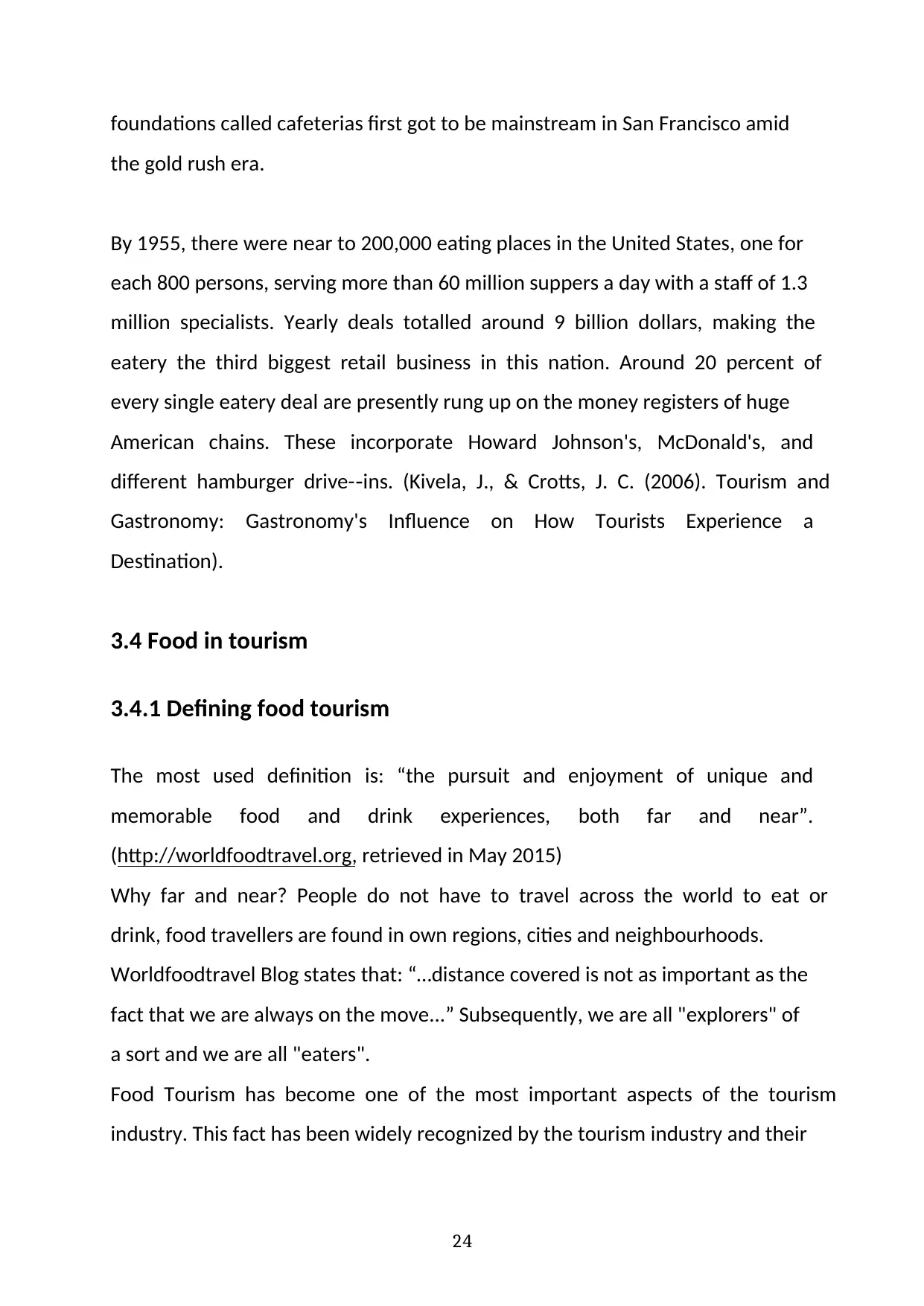
24
foundations called cafeterias first got to be mainstream in San Francisco amid
the gold rush era.
By 1955, there were near to 200,000 eating places in the United States, one for
each 800 persons, serving more than 60 million suppers a day with a staff of 1.3
million specialists. Yearly deals totalled around 9 billion dollars, making the
eatery the third biggest retail business in this nation. Around 20 percent of
every single eatery deal are presently rung up on the money registers of huge
American chains. These incorporate Howard Johnson's, McDonald's, and
different hamburger drive- ins. (Kivela, J., & Crotts, J. C. (2006). Tourism and‐
Gastronomy: Gastronomy's Influence on How Tourists Experience a
Destination).
3.4 Food in tourism
3.4.1 Defining food tourism
The most used definition is: “the pursuit and enjoyment of unique and
memorable food and drink experiences, both far and near”.
(http://worldfoodtravel.org, retrieved in May 2015)
Why far and near? People do not have to travel across the world to eat or
drink, food travellers are found in own regions, cities and neighbourhoods.
Worldfoodtravel Blog states that: “…distance covered is not as important as the
fact that we are always on the move...” Subsequently, we are all "explorers" of
a sort and we are all "eaters".
Food Tourism has become one of the most important aspects of the tourism
industry. This fact has been widely recognized by the tourism industry and their
foundations called cafeterias first got to be mainstream in San Francisco amid
the gold rush era.
By 1955, there were near to 200,000 eating places in the United States, one for
each 800 persons, serving more than 60 million suppers a day with a staff of 1.3
million specialists. Yearly deals totalled around 9 billion dollars, making the
eatery the third biggest retail business in this nation. Around 20 percent of
every single eatery deal are presently rung up on the money registers of huge
American chains. These incorporate Howard Johnson's, McDonald's, and
different hamburger drive- ins. (Kivela, J., & Crotts, J. C. (2006). Tourism and‐
Gastronomy: Gastronomy's Influence on How Tourists Experience a
Destination).
3.4 Food in tourism
3.4.1 Defining food tourism
The most used definition is: “the pursuit and enjoyment of unique and
memorable food and drink experiences, both far and near”.
(http://worldfoodtravel.org, retrieved in May 2015)
Why far and near? People do not have to travel across the world to eat or
drink, food travellers are found in own regions, cities and neighbourhoods.
Worldfoodtravel Blog states that: “…distance covered is not as important as the
fact that we are always on the move...” Subsequently, we are all "explorers" of
a sort and we are all "eaters".
Food Tourism has become one of the most important aspects of the tourism
industry. This fact has been widely recognized by the tourism industry and their
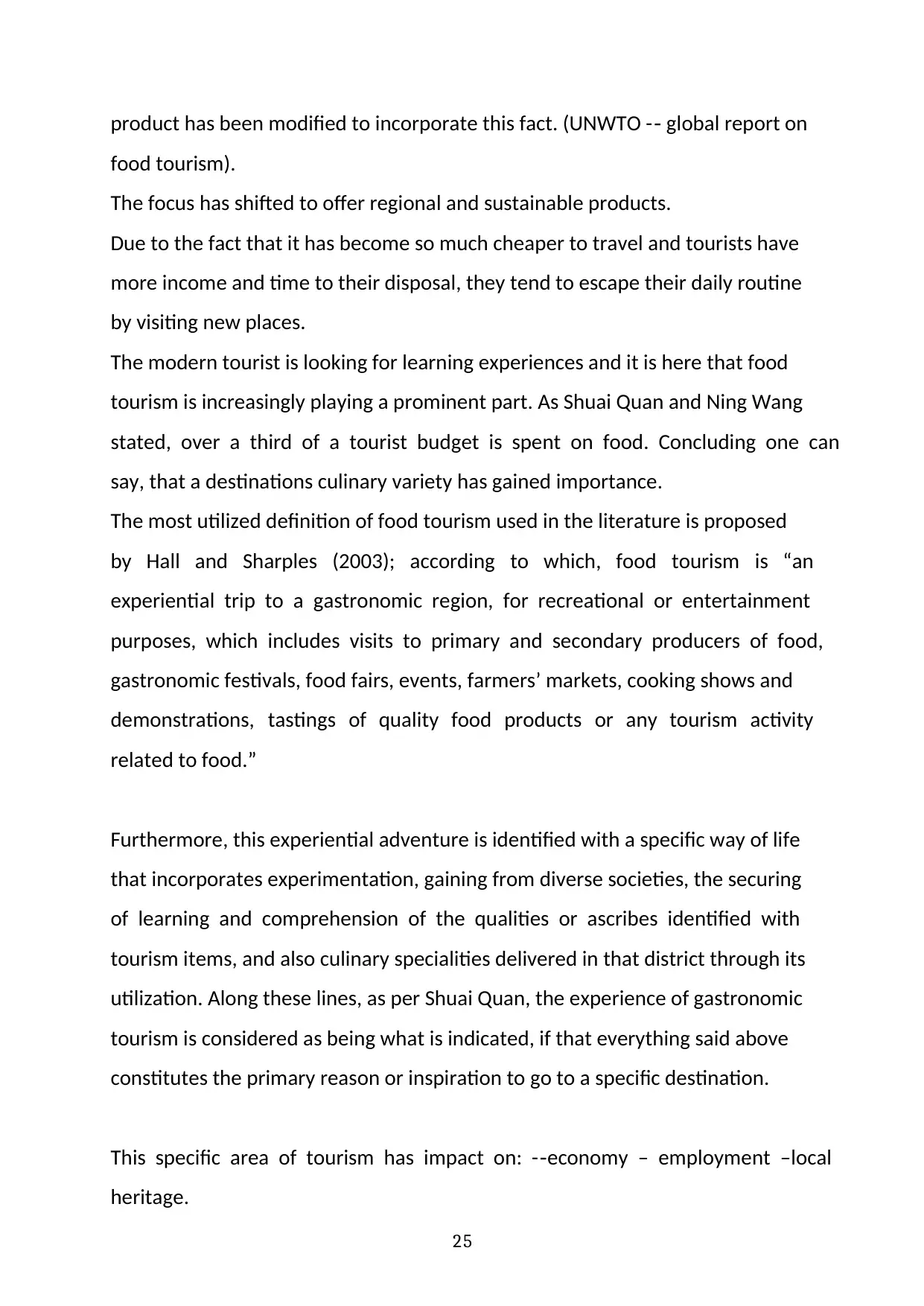
25
product has been modified to incorporate this fact. (UNWTO - global report on‐
food tourism).
The focus has shifted to offer regional and sustainable products.
Due to the fact that it has become so much cheaper to travel and tourists have
more income and time to their disposal, they tend to escape their daily routine
by visiting new places.
The modern tourist is looking for learning experiences and it is here that food
tourism is increasingly playing a prominent part. As Shuai Quan and Ning Wang
stated, over a third of a tourist budget is spent on food. Concluding one can
say, that a destinations culinary variety has gained importance.
The most utilized definition of food tourism used in the literature is proposed
by Hall and Sharples (2003); according to which, food tourism is “an
experiential trip to a gastronomic region, for recreational or entertainment
purposes, which includes visits to primary and secondary producers of food,
gastronomic festivals, food fairs, events, farmers’ markets, cooking shows and
demonstrations, tastings of quality food products or any tourism activity
related to food.”
Furthermore, this experiential adventure is identified with a specific way of life
that incorporates experimentation, gaining from diverse societies, the securing
of learning and comprehension of the qualities or ascribes identified with
tourism items, and also culinary specialities delivered in that district through its
utilization. Along these lines, as per Shuai Quan, the experience of gastronomic
tourism is considered as being what is indicated, if that everything said above
constitutes the primary reason or inspiration to go to a specific destination.
This specific area of tourism has impact on: - economy – employment –local‐
heritage.
product has been modified to incorporate this fact. (UNWTO - global report on‐
food tourism).
The focus has shifted to offer regional and sustainable products.
Due to the fact that it has become so much cheaper to travel and tourists have
more income and time to their disposal, they tend to escape their daily routine
by visiting new places.
The modern tourist is looking for learning experiences and it is here that food
tourism is increasingly playing a prominent part. As Shuai Quan and Ning Wang
stated, over a third of a tourist budget is spent on food. Concluding one can
say, that a destinations culinary variety has gained importance.
The most utilized definition of food tourism used in the literature is proposed
by Hall and Sharples (2003); according to which, food tourism is “an
experiential trip to a gastronomic region, for recreational or entertainment
purposes, which includes visits to primary and secondary producers of food,
gastronomic festivals, food fairs, events, farmers’ markets, cooking shows and
demonstrations, tastings of quality food products or any tourism activity
related to food.”
Furthermore, this experiential adventure is identified with a specific way of life
that incorporates experimentation, gaining from diverse societies, the securing
of learning and comprehension of the qualities or ascribes identified with
tourism items, and also culinary specialities delivered in that district through its
utilization. Along these lines, as per Shuai Quan, the experience of gastronomic
tourism is considered as being what is indicated, if that everything said above
constitutes the primary reason or inspiration to go to a specific destination.
This specific area of tourism has impact on: - economy – employment –local‐
heritage.
Paraphrase This Document
Need a fresh take? Get an instant paraphrase of this document with our AI Paraphraser
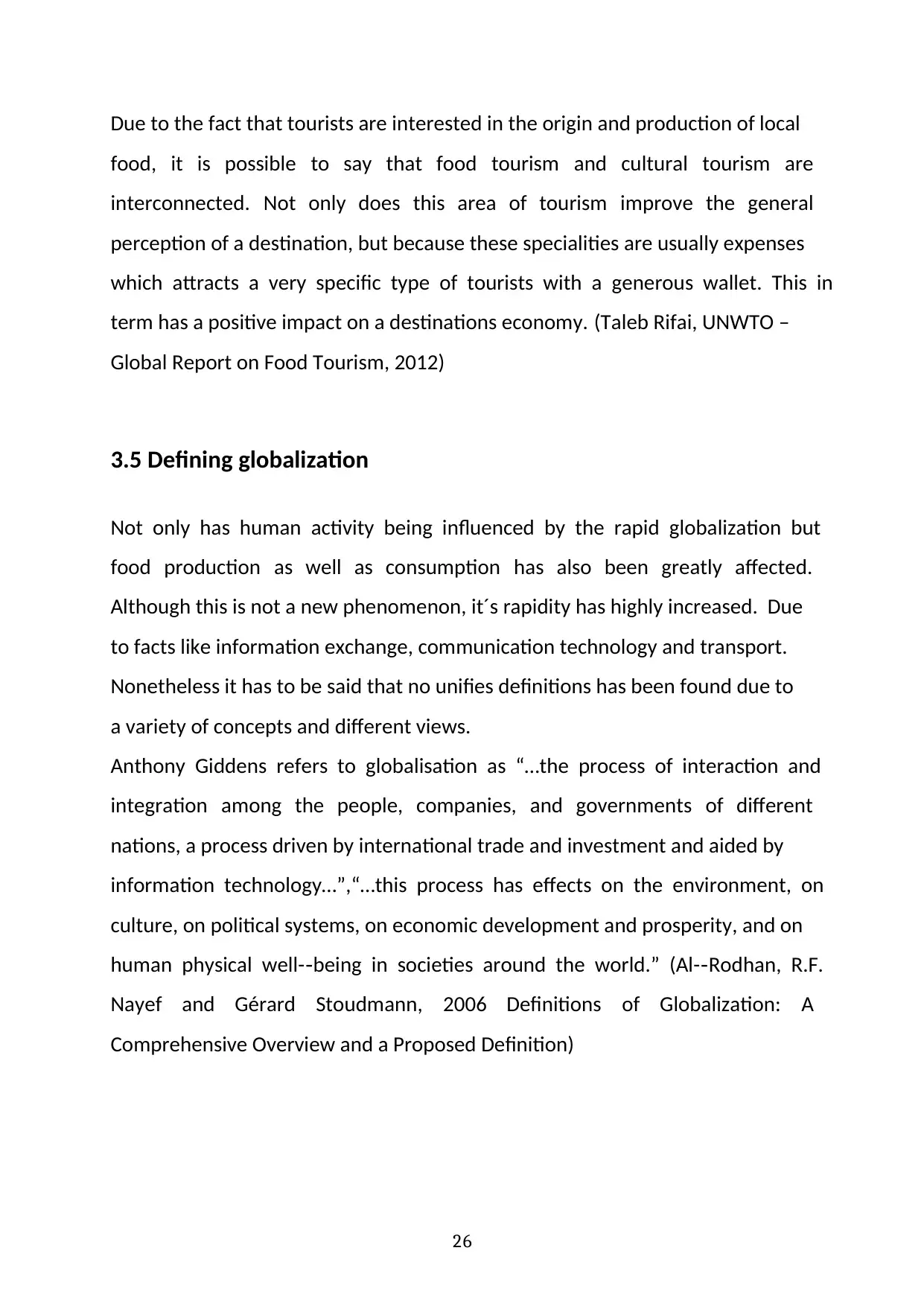
26
Due to the fact that tourists are interested in the origin and production of local
food, it is possible to say that food tourism and cultural tourism are
interconnected. Not only does this area of tourism improve the general
perception of a destination, but because these specialities are usually expenses
which attracts a very specific type of tourists with a generous wallet. This in
term has a positive impact on a destinations economy. (Taleb Rifai, UNWTO –
Global Report on Food Tourism, 2012)
3.5 Defining globalization
Not only has human activity being influenced by the rapid globalization but
food production as well as consumption has also been greatly affected.
Although this is not a new phenomenon, it´s rapidity has highly increased. Due
to facts like information exchange, communication technology and transport.
Nonetheless it has to be said that no unifies definitions has been found due to
a variety of concepts and different views.
Anthony Giddens refers to globalisation as “…the process of interaction and
integration among the people, companies, and governments of different
nations, a process driven by international trade and investment and aided by
information technology…”,“…this process has effects on the environment, on
culture, on political systems, on economic development and prosperity, and on
human physical well- being in societies around the world.” (Al- Rodhan, R.F.‐ ‐
Nayef and Gérard Stoudmann, 2006 Definitions of Globalization: A
Comprehensive Overview and a Proposed Definition)
Due to the fact that tourists are interested in the origin and production of local
food, it is possible to say that food tourism and cultural tourism are
interconnected. Not only does this area of tourism improve the general
perception of a destination, but because these specialities are usually expenses
which attracts a very specific type of tourists with a generous wallet. This in
term has a positive impact on a destinations economy. (Taleb Rifai, UNWTO –
Global Report on Food Tourism, 2012)
3.5 Defining globalization
Not only has human activity being influenced by the rapid globalization but
food production as well as consumption has also been greatly affected.
Although this is not a new phenomenon, it´s rapidity has highly increased. Due
to facts like information exchange, communication technology and transport.
Nonetheless it has to be said that no unifies definitions has been found due to
a variety of concepts and different views.
Anthony Giddens refers to globalisation as “…the process of interaction and
integration among the people, companies, and governments of different
nations, a process driven by international trade and investment and aided by
information technology…”,“…this process has effects on the environment, on
culture, on political systems, on economic development and prosperity, and on
human physical well- being in societies around the world.” (Al- Rodhan, R.F.‐ ‐
Nayef and Gérard Stoudmann, 2006 Definitions of Globalization: A
Comprehensive Overview and a Proposed Definition)
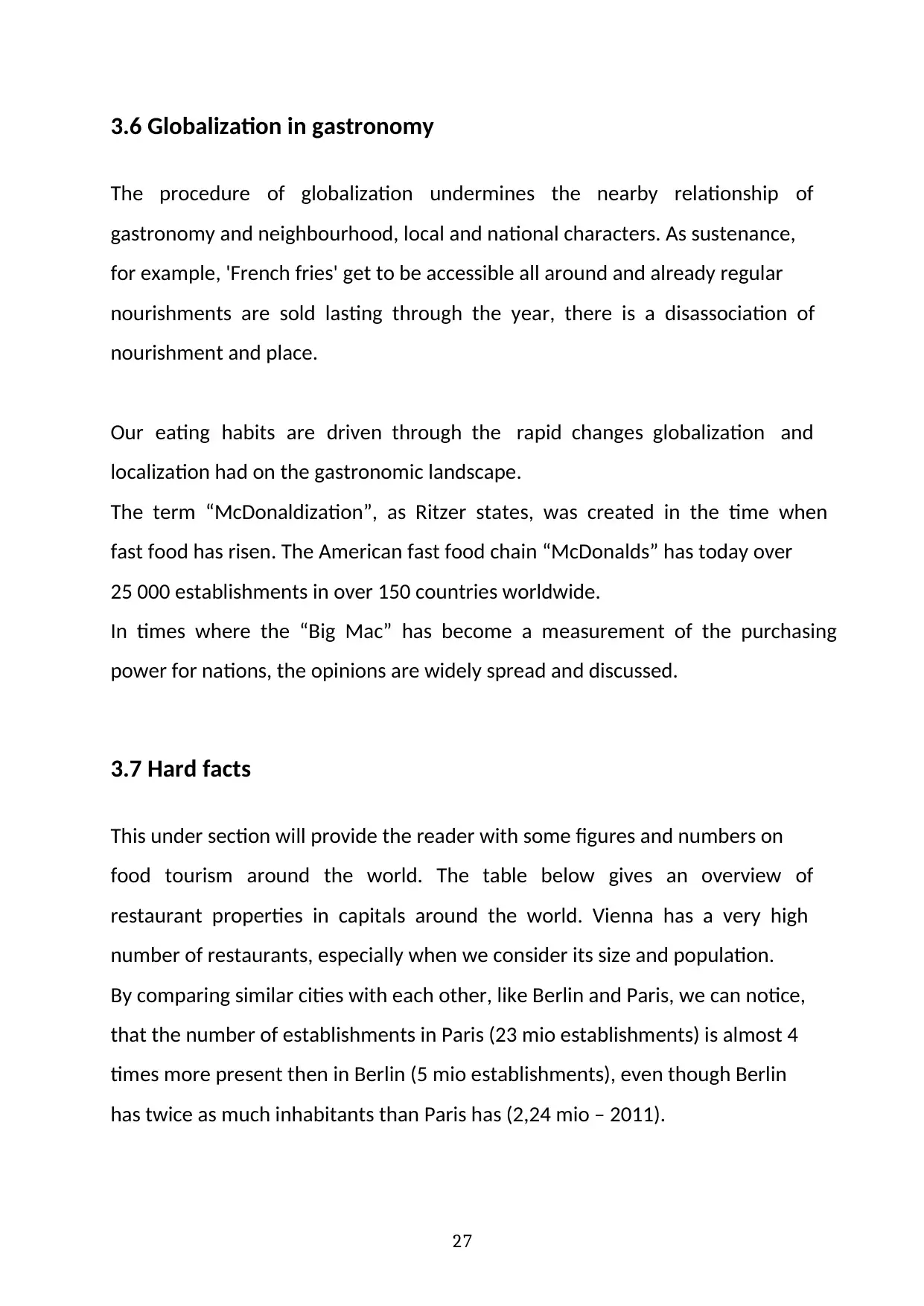
27
3.6 Globalization in gastronomy
The procedure of globalization undermines the nearby relationship of
gastronomy and neighbourhood, local and national characters. As sustenance,
for example, 'French fries' get to be accessible all around and already regular
nourishments are sold lasting through the year, there is a disassociation of
nourishment and place.
Our eating habits are driven through the rapid changes globalization and
localization had on the gastronomic landscape.
The term “McDonaldization”, as Ritzer states, was created in the time when
fast food has risen. The American fast food chain “McDonalds” has today over
25 000 establishments in over 150 countries worldwide.
In times where the “Big Mac” has become a measurement of the purchasing
power for nations, the opinions are widely spread and discussed.
3.7 Hard facts
This under section will provide the reader with some figures and numbers on
food tourism around the world. The table below gives an overview of
restaurant properties in capitals around the world. Vienna has a very high
number of restaurants, especially when we consider its size and population.
By comparing similar cities with each other, like Berlin and Paris, we can notice,
that the number of establishments in Paris (23 mio establishments) is almost 4
times more present then in Berlin (5 mio establishments), even though Berlin
has twice as much inhabitants than Paris has (2,24 mio – 2011).
3.6 Globalization in gastronomy
The procedure of globalization undermines the nearby relationship of
gastronomy and neighbourhood, local and national characters. As sustenance,
for example, 'French fries' get to be accessible all around and already regular
nourishments are sold lasting through the year, there is a disassociation of
nourishment and place.
Our eating habits are driven through the rapid changes globalization and
localization had on the gastronomic landscape.
The term “McDonaldization”, as Ritzer states, was created in the time when
fast food has risen. The American fast food chain “McDonalds” has today over
25 000 establishments in over 150 countries worldwide.
In times where the “Big Mac” has become a measurement of the purchasing
power for nations, the opinions are widely spread and discussed.
3.7 Hard facts
This under section will provide the reader with some figures and numbers on
food tourism around the world. The table below gives an overview of
restaurant properties in capitals around the world. Vienna has a very high
number of restaurants, especially when we consider its size and population.
By comparing similar cities with each other, like Berlin and Paris, we can notice,
that the number of establishments in Paris (23 mio establishments) is almost 4
times more present then in Berlin (5 mio establishments), even though Berlin
has twice as much inhabitants than Paris has (2,24 mio – 2011).

28
London is the “culinary hotspot” of Europe. With more than 37 mio
establishments it has no competition at all – it has even more restaurant
properties then metropolis likes New York (24 mio.) or Hong Kong (11 mio.)
Interestingly, Amsterdam has almost as many restaurants in the city as Vienna,
although it is rather small city with not even 1 mio. Inhabitants. Compared, to
Vienna, who has almost twice as many inhabitants.
Table 3: Number of restaurant establishments around the world
.Source: http://www.worldcitiescultureforum.com/indicators/number- restaurants‐
City Restaurant number Date
Amsterdam 1.312 2012
Berlin 4.885 2008
Bogota 6.158 2013
Hong Kong 11.834 2012
Istanbul 9.508 2012
Johannesburg 15.000 2012
London 37.450 2011
Los Angeles 28.787 2013
New York 24.249 2012
Toronto 7.983 2013
Paris 22.327 2010
Singapore 2.426 2012
Vienna 1.983 2013
Moscow 3.159 2014
London is the “culinary hotspot” of Europe. With more than 37 mio
establishments it has no competition at all – it has even more restaurant
properties then metropolis likes New York (24 mio.) or Hong Kong (11 mio.)
Interestingly, Amsterdam has almost as many restaurants in the city as Vienna,
although it is rather small city with not even 1 mio. Inhabitants. Compared, to
Vienna, who has almost twice as many inhabitants.
Table 3: Number of restaurant establishments around the world
.Source: http://www.worldcitiescultureforum.com/indicators/number- restaurants‐
City Restaurant number Date
Amsterdam 1.312 2012
Berlin 4.885 2008
Bogota 6.158 2013
Hong Kong 11.834 2012
Istanbul 9.508 2012
Johannesburg 15.000 2012
London 37.450 2011
Los Angeles 28.787 2013
New York 24.249 2012
Toronto 7.983 2013
Paris 22.327 2010
Singapore 2.426 2012
Vienna 1.983 2013
Moscow 3.159 2014
Secure Best Marks with AI Grader
Need help grading? Try our AI Grader for instant feedback on your assignments.
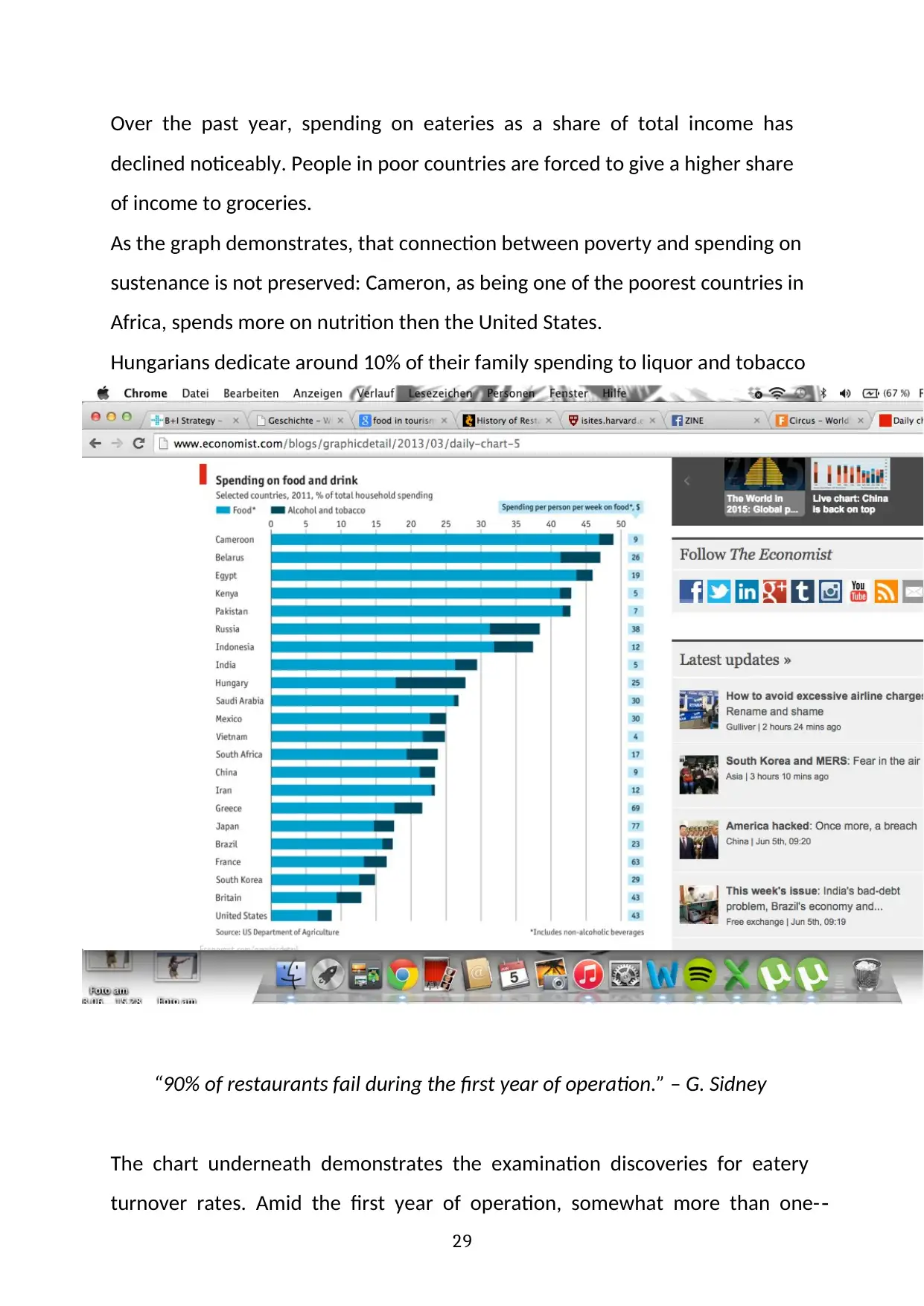
29
Over the past year, spending on eateries as a share of total income has
declined noticeably. People in poor countries are forced to give a higher share
of income to groceries.
As the graph demonstrates, that connection between poverty and spending on
sustenance is not preserved: Cameron, as being one of the poorest countries in
Africa, spends more on nutrition then the United States.
Hungarians dedicate around 10% of their family spending to liquor and tobacco
and only 15% on eateries. (economist.com, retrieved May 2015)
Table 4: Spending on food and drinks of selected countries in 2011
Source: theeconomist.com
“90% of restaurants fail during the first year of operation.” – G. Sidney
The chart underneath demonstrates the examination discoveries for eatery
turnover rates. Amid the first year of operation, somewhat more than one- ‐
Over the past year, spending on eateries as a share of total income has
declined noticeably. People in poor countries are forced to give a higher share
of income to groceries.
As the graph demonstrates, that connection between poverty and spending on
sustenance is not preserved: Cameron, as being one of the poorest countries in
Africa, spends more on nutrition then the United States.
Hungarians dedicate around 10% of their family spending to liquor and tobacco
and only 15% on eateries. (economist.com, retrieved May 2015)
Table 4: Spending on food and drinks of selected countries in 2011
Source: theeconomist.com
“90% of restaurants fail during the first year of operation.” – G. Sidney
The chart underneath demonstrates the examination discoveries for eatery
turnover rates. Amid the first year of operation, somewhat more than one- ‐
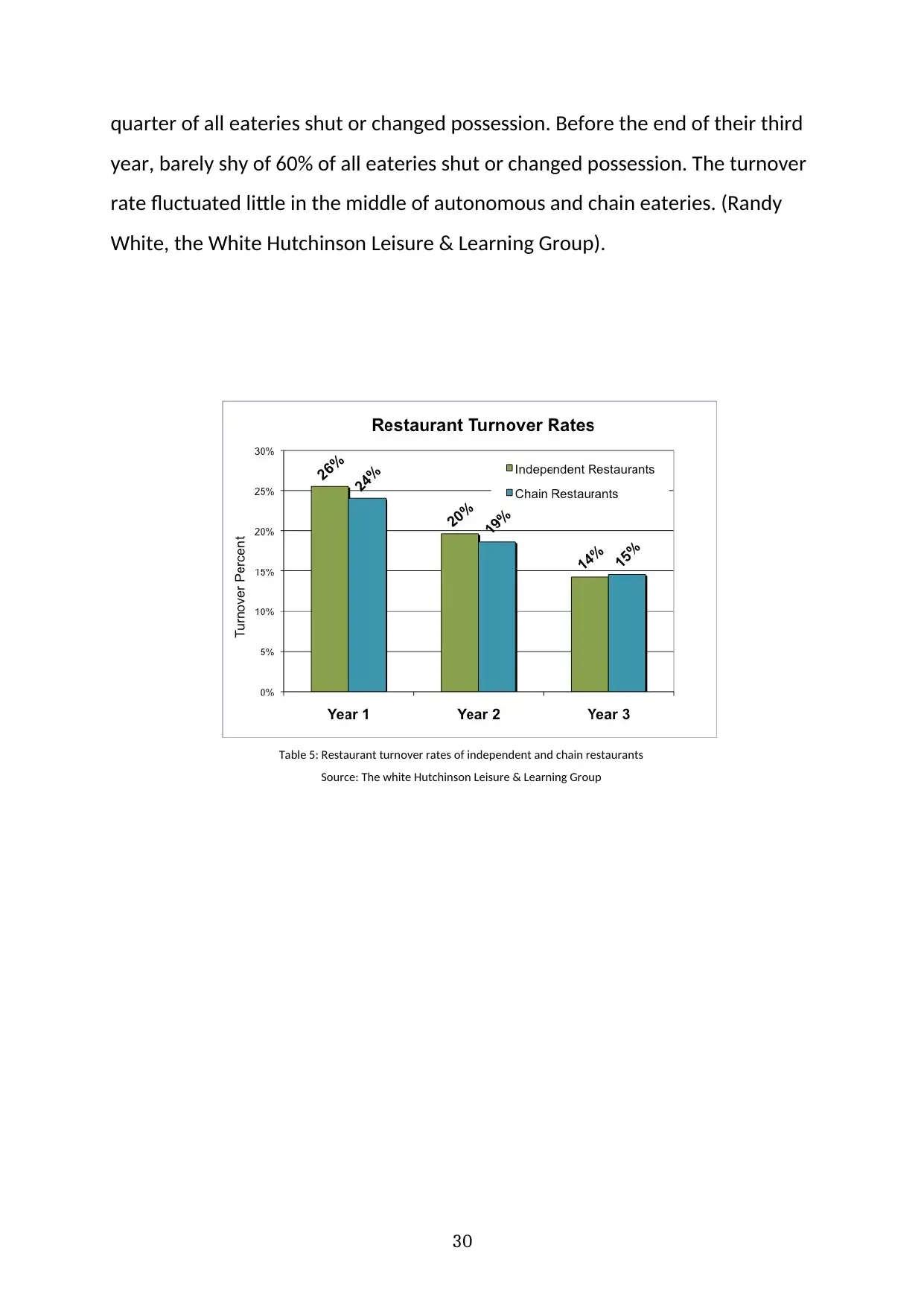
30
quarter of all eateries shut or changed possession. Before the end of their third
year, barely shy of 60% of all eateries shut or changed possession. The turnover
rate fluctuated little in the middle of autonomous and chain eateries. (Randy
White, the White Hutchinson Leisure & Learning Group).
Table 5: Restaurant turnover rates of independent and chain restaurants
Source: The white Hutchinson Leisure & Learning Group
quarter of all eateries shut or changed possession. Before the end of their third
year, barely shy of 60% of all eateries shut or changed possession. The turnover
rate fluctuated little in the middle of autonomous and chain eateries. (Randy
White, the White Hutchinson Leisure & Learning Group).
Table 5: Restaurant turnover rates of independent and chain restaurants
Source: The white Hutchinson Leisure & Learning Group
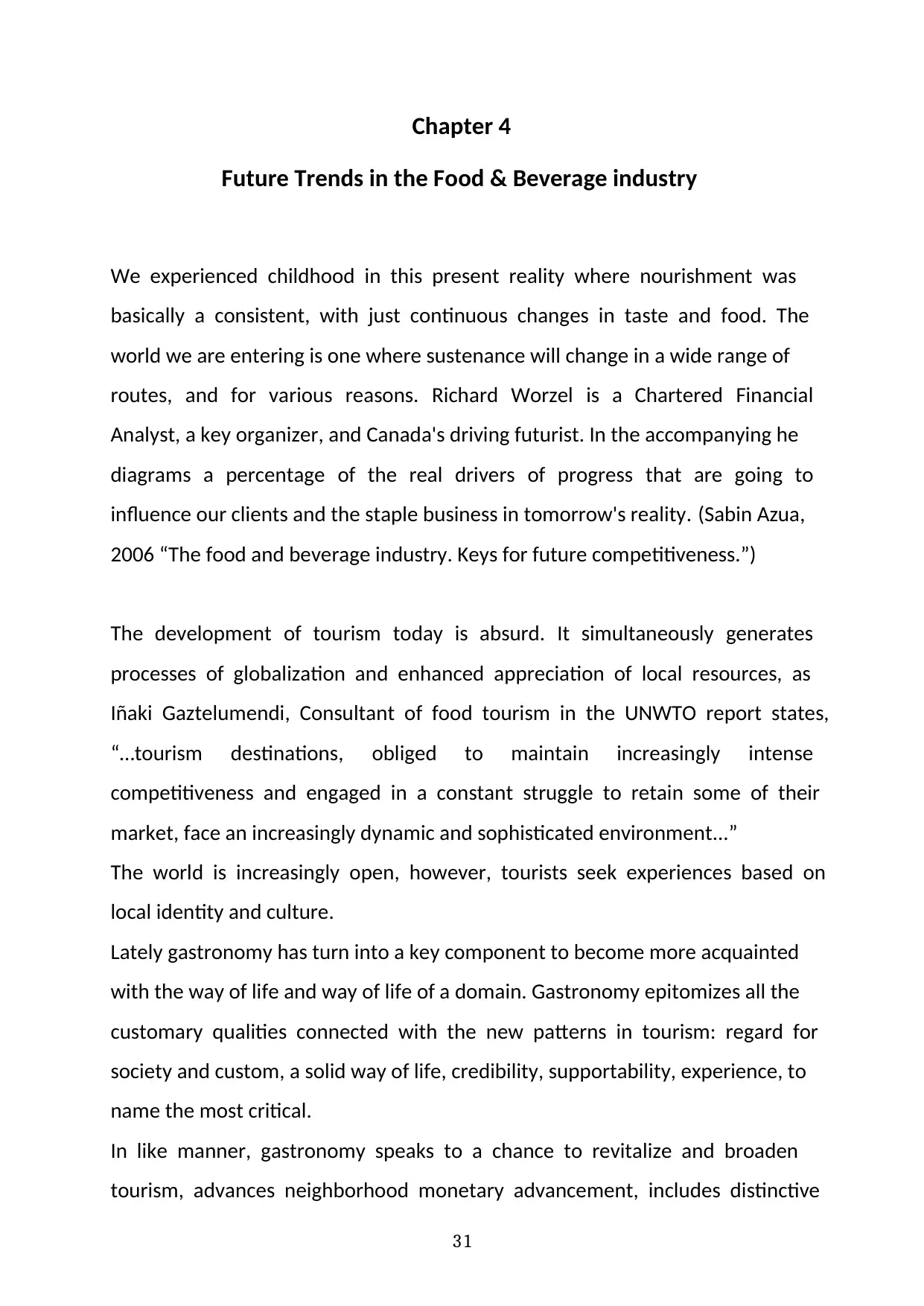
31
Chapter 4
Future Trends in the Food & Beverage industry
We experienced childhood in this present reality where nourishment was
basically a consistent, with just continuous changes in taste and food. The
world we are entering is one where sustenance will change in a wide range of
routes, and for various reasons. Richard Worzel is a Chartered Financial
Analyst, a key organizer, and Canada's driving futurist. In the accompanying he
diagrams a percentage of the real drivers of progress that are going to
influence our clients and the staple business in tomorrow's reality. (Sabin Azua,
2006 “The food and beverage industry. Keys for future competitiveness.”)
The development of tourism today is absurd. It simultaneously generates
processes of globalization and enhanced appreciation of local resources, as
Iñaki Gaztelumendi, Consultant of food tourism in the UNWTO report states,
“…tourism destinations, obliged to maintain increasingly intense
competitiveness and engaged in a constant struggle to retain some of their
market, face an increasingly dynamic and sophisticated environment...”
The world is increasingly open, however, tourists seek experiences based on
local identity and culture.
Lately gastronomy has turn into a key component to become more acquainted
with the way of life and way of life of a domain. Gastronomy epitomizes all the
customary qualities connected with the new patterns in tourism: regard for
society and custom, a solid way of life, credibility, supportability, experience, to
name the most critical.
In like manner, gastronomy speaks to a chance to revitalize and broaden
tourism, advances neighborhood monetary advancement, includes distinctive
Chapter 4
Future Trends in the Food & Beverage industry
We experienced childhood in this present reality where nourishment was
basically a consistent, with just continuous changes in taste and food. The
world we are entering is one where sustenance will change in a wide range of
routes, and for various reasons. Richard Worzel is a Chartered Financial
Analyst, a key organizer, and Canada's driving futurist. In the accompanying he
diagrams a percentage of the real drivers of progress that are going to
influence our clients and the staple business in tomorrow's reality. (Sabin Azua,
2006 “The food and beverage industry. Keys for future competitiveness.”)
The development of tourism today is absurd. It simultaneously generates
processes of globalization and enhanced appreciation of local resources, as
Iñaki Gaztelumendi, Consultant of food tourism in the UNWTO report states,
“…tourism destinations, obliged to maintain increasingly intense
competitiveness and engaged in a constant struggle to retain some of their
market, face an increasingly dynamic and sophisticated environment...”
The world is increasingly open, however, tourists seek experiences based on
local identity and culture.
Lately gastronomy has turn into a key component to become more acquainted
with the way of life and way of life of a domain. Gastronomy epitomizes all the
customary qualities connected with the new patterns in tourism: regard for
society and custom, a solid way of life, credibility, supportability, experience, to
name the most critical.
In like manner, gastronomy speaks to a chance to revitalize and broaden
tourism, advances neighborhood monetary advancement, includes distinctive
Paraphrase This Document
Need a fresh take? Get an instant paraphrase of this document with our AI Paraphraser
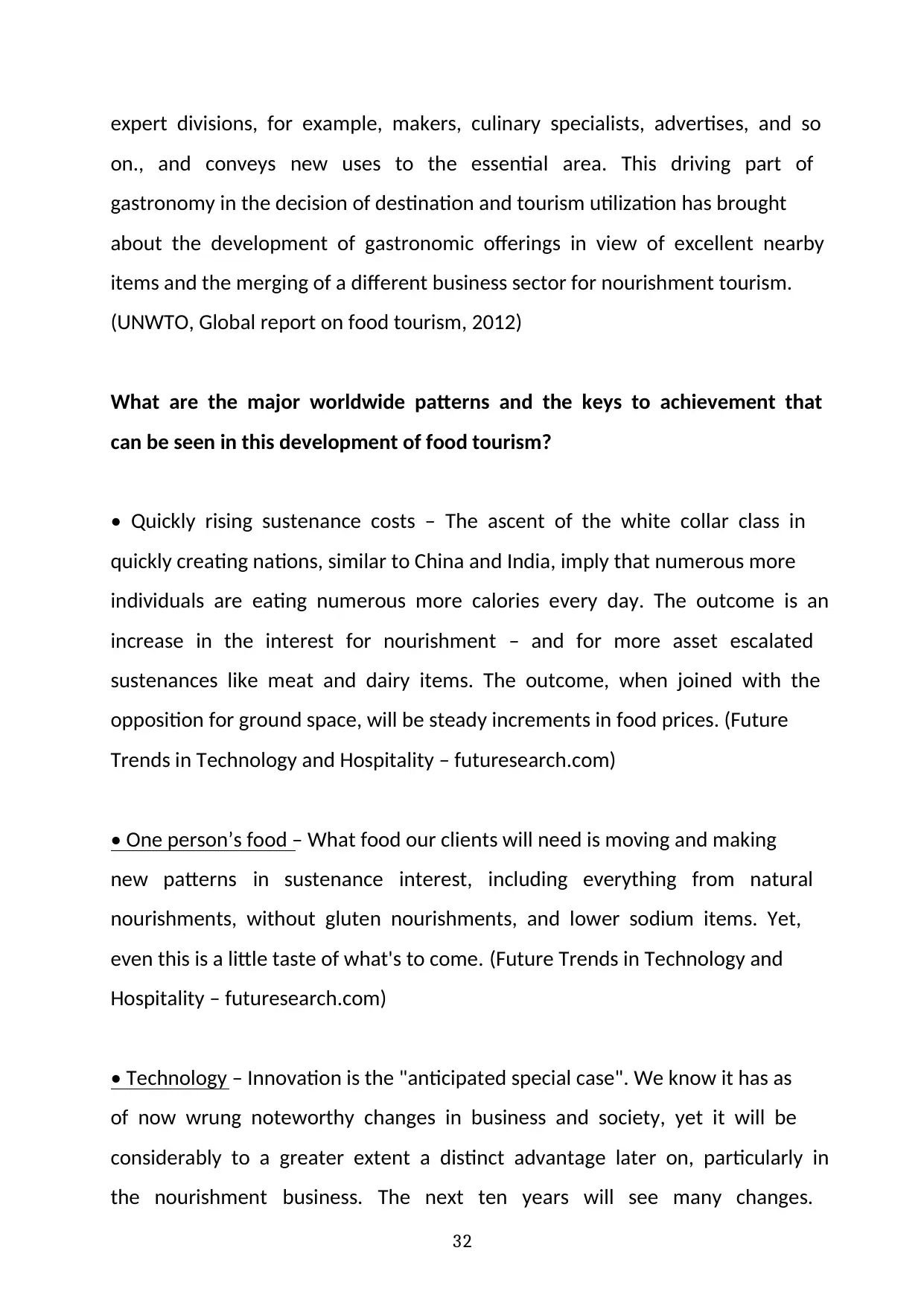
32
expert divisions, for example, makers, culinary specialists, advertises, and so
on., and conveys new uses to the essential area. This driving part of
gastronomy in the decision of destination and tourism utilization has brought
about the development of gastronomic offerings in view of excellent nearby
items and the merging of a different business sector for nourishment tourism.
(UNWTO, Global report on food tourism, 2012)
What are the major worldwide patterns and the keys to achievement that
can be seen in this development of food tourism?
• Quickly rising sustenance costs – The ascent of the white collar class in
quickly creating nations, similar to China and India, imply that numerous more
individuals are eating numerous more calories every day. The outcome is an
increase in the interest for nourishment – and for more asset escalated
sustenances like meat and dairy items. The outcome, when joined with the
opposition for ground space, will be steady increments in food prices. (Future
Trends in Technology and Hospitality – futuresearch.com)
• One person’s food – What food our clients will need is moving and making
new patterns in sustenance interest, including everything from natural
nourishments, without gluten nourishments, and lower sodium items. Yet,
even this is a little taste of what's to come. (Future Trends in Technology and
Hospitality – futuresearch.com)
• Technology – Innovation is the "anticipated special case". We know it has as
of now wrung noteworthy changes in business and society, yet it will be
considerably to a greater extent a distinct advantage later on, particularly in
the nourishment business. The next ten years will see many changes.
expert divisions, for example, makers, culinary specialists, advertises, and so
on., and conveys new uses to the essential area. This driving part of
gastronomy in the decision of destination and tourism utilization has brought
about the development of gastronomic offerings in view of excellent nearby
items and the merging of a different business sector for nourishment tourism.
(UNWTO, Global report on food tourism, 2012)
What are the major worldwide patterns and the keys to achievement that
can be seen in this development of food tourism?
• Quickly rising sustenance costs – The ascent of the white collar class in
quickly creating nations, similar to China and India, imply that numerous more
individuals are eating numerous more calories every day. The outcome is an
increase in the interest for nourishment – and for more asset escalated
sustenances like meat and dairy items. The outcome, when joined with the
opposition for ground space, will be steady increments in food prices. (Future
Trends in Technology and Hospitality – futuresearch.com)
• One person’s food – What food our clients will need is moving and making
new patterns in sustenance interest, including everything from natural
nourishments, without gluten nourishments, and lower sodium items. Yet,
even this is a little taste of what's to come. (Future Trends in Technology and
Hospitality – futuresearch.com)
• Technology – Innovation is the "anticipated special case". We know it has as
of now wrung noteworthy changes in business and society, yet it will be
considerably to a greater extent a distinct advantage later on, particularly in
the nourishment business. The next ten years will see many changes.
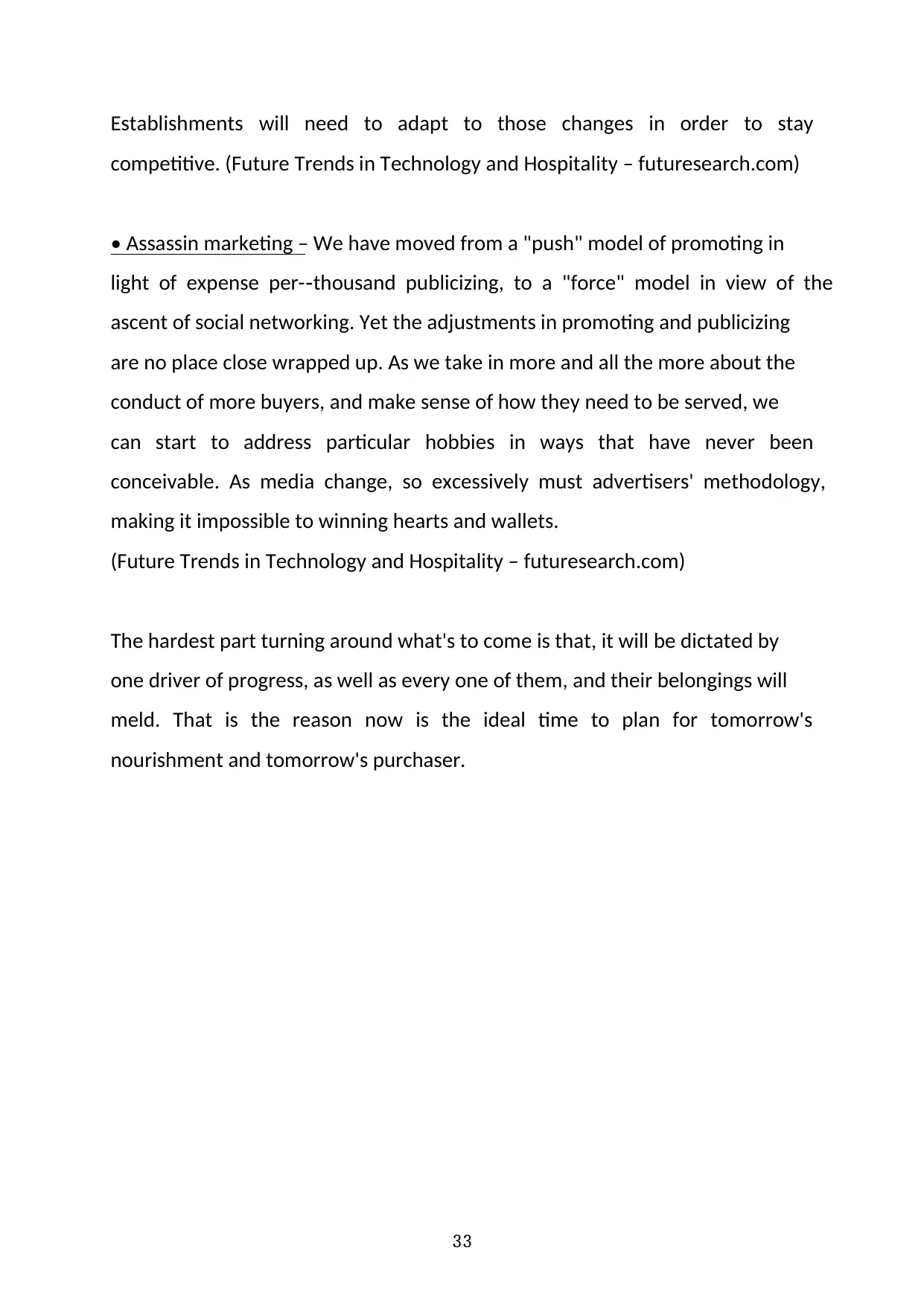
33
Establishments will need to adapt to those changes in order to stay
competitive. (Future Trends in Technology and Hospitality – futuresearch.com)
• Assassin marketing – We have moved from a "push" model of promoting in
light of expense per- thousand publicizing, to a "force" model in view of the‐
ascent of social networking. Yet the adjustments in promoting and publicizing
are no place close wrapped up. As we take in more and all the more about the
conduct of more buyers, and make sense of how they need to be served, we
can start to address particular hobbies in ways that have never been
conceivable. As media change, so excessively must advertisers' methodology,
making it impossible to winning hearts and wallets.
(Future Trends in Technology and Hospitality – futuresearch.com)
The hardest part turning around what's to come is that, it will be dictated by
one driver of progress, as well as every one of them, and their belongings will
meld. That is the reason now is the ideal time to plan for tomorrow's
nourishment and tomorrow's purchaser.
Establishments will need to adapt to those changes in order to stay
competitive. (Future Trends in Technology and Hospitality – futuresearch.com)
• Assassin marketing – We have moved from a "push" model of promoting in
light of expense per- thousand publicizing, to a "force" model in view of the‐
ascent of social networking. Yet the adjustments in promoting and publicizing
are no place close wrapped up. As we take in more and all the more about the
conduct of more buyers, and make sense of how they need to be served, we
can start to address particular hobbies in ways that have never been
conceivable. As media change, so excessively must advertisers' methodology,
making it impossible to winning hearts and wallets.
(Future Trends in Technology and Hospitality – futuresearch.com)
The hardest part turning around what's to come is that, it will be dictated by
one driver of progress, as well as every one of them, and their belongings will
meld. That is the reason now is the ideal time to plan for tomorrow's
nourishment and tomorrow's purchaser.
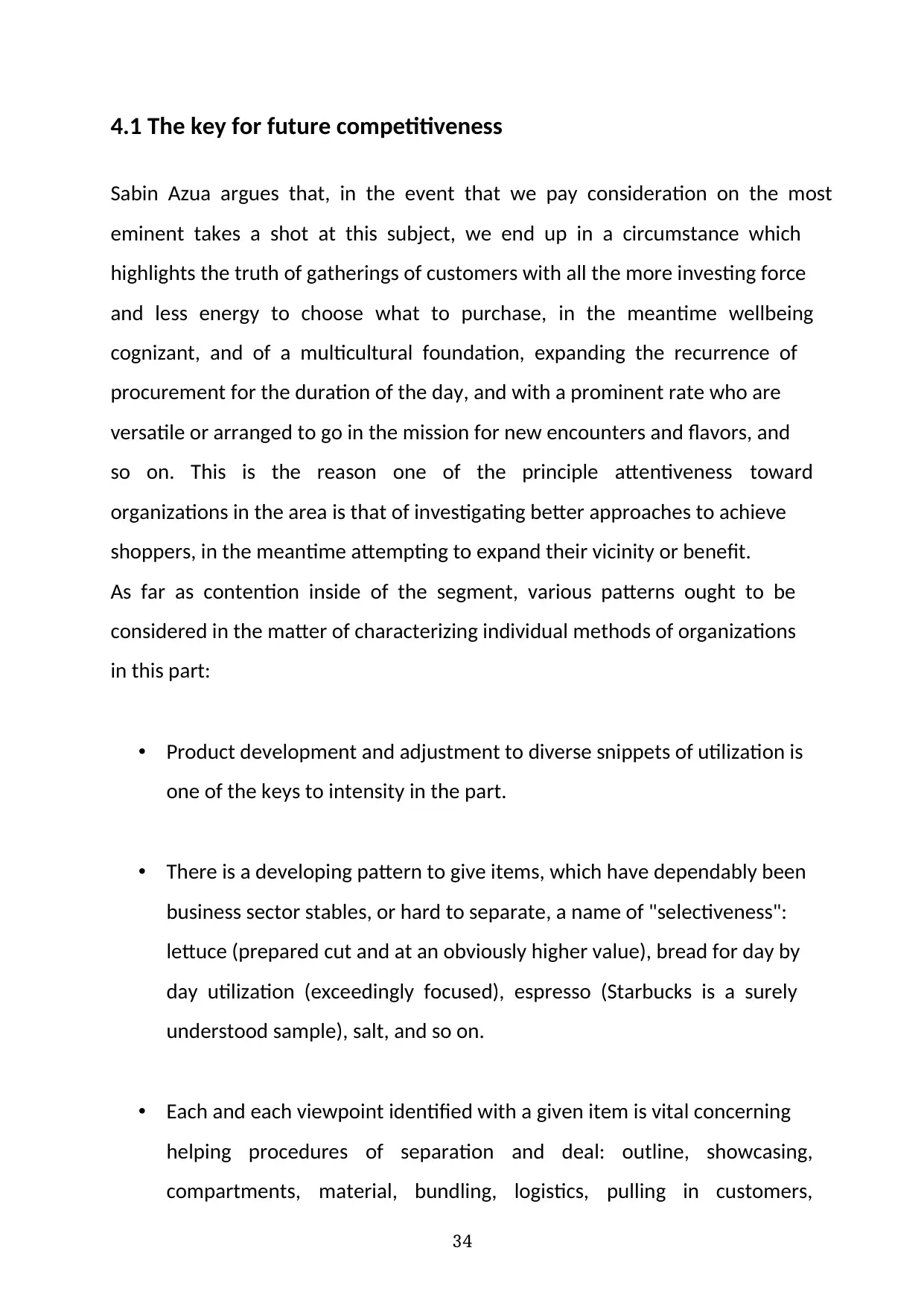
34
4.1 The key for future competitiveness
Sabin Azua argues that, in the event that we pay consideration on the most
eminent takes a shot at this subject, we end up in a circumstance which
highlights the truth of gatherings of customers with all the more investing force
and less energy to choose what to purchase, in the meantime wellbeing
cognizant, and of a multicultural foundation, expanding the recurrence of
procurement for the duration of the day, and with a prominent rate who are
versatile or arranged to go in the mission for new encounters and flavors, and
so on. This is the reason one of the principle attentiveness toward
organizations in the area is that of investigating better approaches to achieve
shoppers, in the meantime attempting to expand their vicinity or benefit.
As far as contention inside of the segment, various patterns ought to be
considered in the matter of characterizing individual methods of organizations
in this part:
• Product development and adjustment to diverse snippets of utilization is
one of the keys to intensity in the part.
• There is a developing pattern to give items, which have dependably been
business sector stables, or hard to separate, a name of "selectiveness":
lettuce (prepared cut and at an obviously higher value), bread for day by
day utilization (exceedingly focused), espresso (Starbucks is a surely
understood sample), salt, and so on.
• Each and each viewpoint identified with a given item is vital concerning
helping procedures of separation and deal: outline, showcasing,
compartments, material, bundling, logistics, pulling in customers,
4.1 The key for future competitiveness
Sabin Azua argues that, in the event that we pay consideration on the most
eminent takes a shot at this subject, we end up in a circumstance which
highlights the truth of gatherings of customers with all the more investing force
and less energy to choose what to purchase, in the meantime wellbeing
cognizant, and of a multicultural foundation, expanding the recurrence of
procurement for the duration of the day, and with a prominent rate who are
versatile or arranged to go in the mission for new encounters and flavors, and
so on. This is the reason one of the principle attentiveness toward
organizations in the area is that of investigating better approaches to achieve
shoppers, in the meantime attempting to expand their vicinity or benefit.
As far as contention inside of the segment, various patterns ought to be
considered in the matter of characterizing individual methods of organizations
in this part:
• Product development and adjustment to diverse snippets of utilization is
one of the keys to intensity in the part.
• There is a developing pattern to give items, which have dependably been
business sector stables, or hard to separate, a name of "selectiveness":
lettuce (prepared cut and at an obviously higher value), bread for day by
day utilization (exceedingly focused), espresso (Starbucks is a surely
understood sample), salt, and so on.
• Each and each viewpoint identified with a given item is vital concerning
helping procedures of separation and deal: outline, showcasing,
compartments, material, bundling, logistics, pulling in customers,
Secure Best Marks with AI Grader
Need help grading? Try our AI Grader for instant feedback on your assignments.
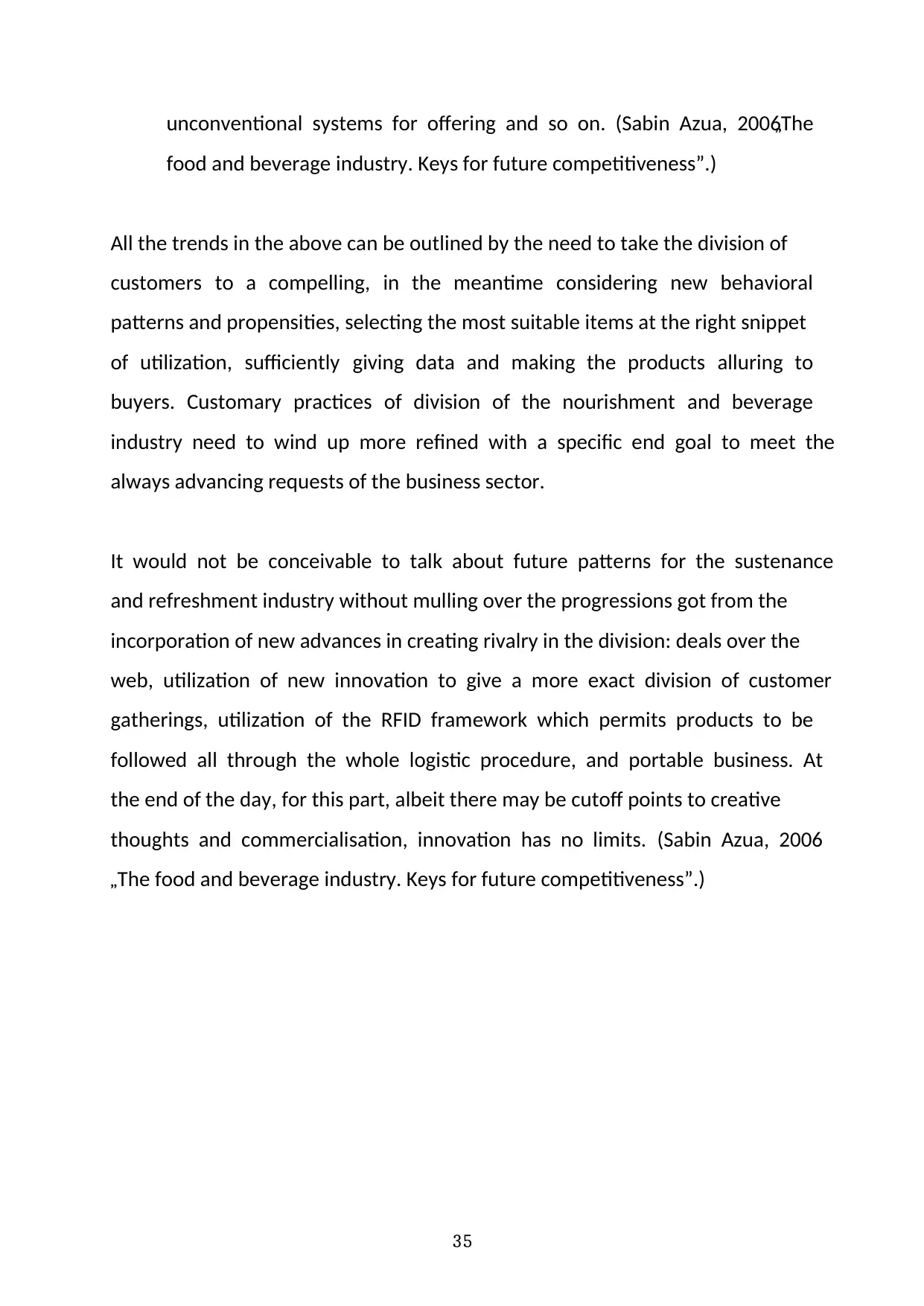
35
unconventional systems for offering and so on. (Sabin Azua, 2006„The
food and beverage industry. Keys for future competitiveness”.)
All the trends in the above can be outlined by the need to take the division of
customers to a compelling, in the meantime considering new behavioral
patterns and propensities, selecting the most suitable items at the right snippet
of utilization, sufficiently giving data and making the products alluring to
buyers. Customary practices of division of the nourishment and beverage
industry need to wind up more refined with a specific end goal to meet the
always advancing requests of the business sector.
It would not be conceivable to talk about future patterns for the sustenance
and refreshment industry without mulling over the progressions got from the
incorporation of new advances in creating rivalry in the division: deals over the
web, utilization of new innovation to give a more exact division of customer
gatherings, utilization of the RFID framework which permits products to be
followed all through the whole logistic procedure, and portable business. At
the end of the day, for this part, albeit there may be cutoff points to creative
thoughts and commercialisation, innovation has no limits. (Sabin Azua, 2006
„The food and beverage industry. Keys for future competitiveness”.)
unconventional systems for offering and so on. (Sabin Azua, 2006„The
food and beverage industry. Keys for future competitiveness”.)
All the trends in the above can be outlined by the need to take the division of
customers to a compelling, in the meantime considering new behavioral
patterns and propensities, selecting the most suitable items at the right snippet
of utilization, sufficiently giving data and making the products alluring to
buyers. Customary practices of division of the nourishment and beverage
industry need to wind up more refined with a specific end goal to meet the
always advancing requests of the business sector.
It would not be conceivable to talk about future patterns for the sustenance
and refreshment industry without mulling over the progressions got from the
incorporation of new advances in creating rivalry in the division: deals over the
web, utilization of new innovation to give a more exact division of customer
gatherings, utilization of the RFID framework which permits products to be
followed all through the whole logistic procedure, and portable business. At
the end of the day, for this part, albeit there may be cutoff points to creative
thoughts and commercialisation, innovation has no limits. (Sabin Azua, 2006
„The food and beverage industry. Keys for future competitiveness”.)

36
4.2 The evolution of pop up markets
“If new products can come and go, why can't the stores that display them do
the same?” (trendwatching.com)
Pops ups come in all shapes and sizes, and satisfy a mixture of diverse
purposes. Some utilization appear to build brand presentation, others channel
its vitality to unite all the more definitively with their crowd and upgrade their
client experience. Some saddle "appear" to manufacture expectation leading
the pack up to a dispatch or occasion, and others depend on it to test new
markets, or even restore old ones. (PopUnion – popuppages.com, retrieved
February 2012).
Interestingly, there is an underlying theme across all of these purposes -‐
discovery.
It helps individuals discover new products and services. It helps brands discover
new ways to communicate with their audiences. It helps businesses discover
new markets and opportunities. It helps property managers discover new
clients and properties themselves to discover new uses. It helps communities
discover new ways to engage, interact and progress. (popuppages.com,
retrieved February 2015).
But importantly, the power of pop up “…no longer relies on any interaction or
intersection with other industries, such as retail or real estate – it has
discovered a market all of its own…”, as Ana Tripovic, General Manager of
PopUpMarketing says.
As a result, pop up is fast moving beyond a “trend” to become a “trade” in its
own right. A new “Pop Up Culture” has formed, resulting in the emergence of a
pop up “industry”.
4.2 The evolution of pop up markets
“If new products can come and go, why can't the stores that display them do
the same?” (trendwatching.com)
Pops ups come in all shapes and sizes, and satisfy a mixture of diverse
purposes. Some utilization appear to build brand presentation, others channel
its vitality to unite all the more definitively with their crowd and upgrade their
client experience. Some saddle "appear" to manufacture expectation leading
the pack up to a dispatch or occasion, and others depend on it to test new
markets, or even restore old ones. (PopUnion – popuppages.com, retrieved
February 2012).
Interestingly, there is an underlying theme across all of these purposes -‐
discovery.
It helps individuals discover new products and services. It helps brands discover
new ways to communicate with their audiences. It helps businesses discover
new markets and opportunities. It helps property managers discover new
clients and properties themselves to discover new uses. It helps communities
discover new ways to engage, interact and progress. (popuppages.com,
retrieved February 2015).
But importantly, the power of pop up “…no longer relies on any interaction or
intersection with other industries, such as retail or real estate – it has
discovered a market all of its own…”, as Ana Tripovic, General Manager of
PopUpMarketing says.
As a result, pop up is fast moving beyond a “trend” to become a “trade” in its
own right. A new “Pop Up Culture” has formed, resulting in the emergence of a
pop up “industry”.
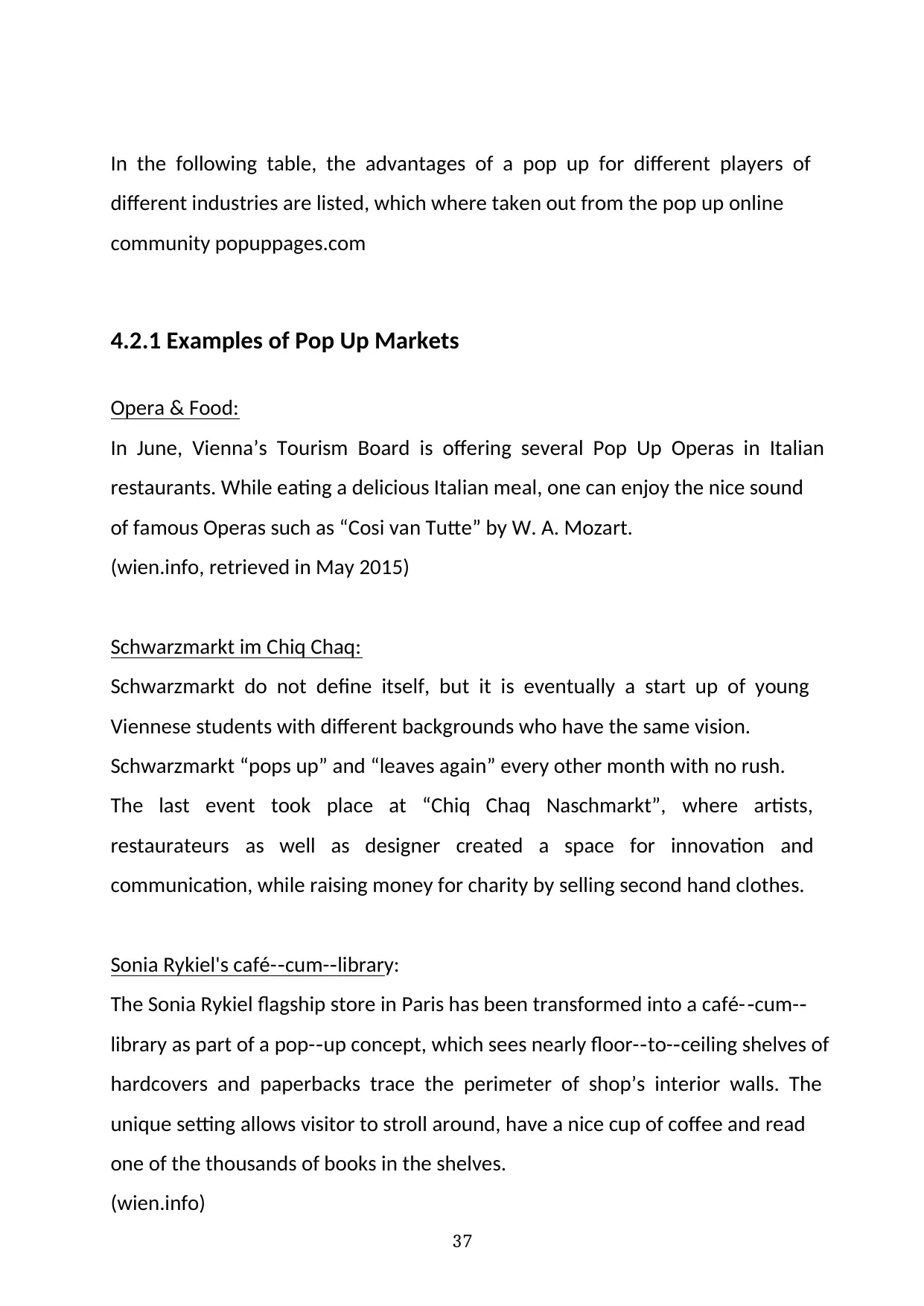
37
In the following table, the advantages of a pop up for different players of
different industries are listed, which where taken out from the pop up online
community popuppages.com
4.2.1 Examples of Pop Up Markets
Opera & Food:
In June, Vienna’s Tourism Board is offering several Pop Up Operas in Italian
restaurants. While eating a delicious Italian meal, one can enjoy the nice sound
of famous Operas such as “Cosi van Tutte” by W. A. Mozart.
(wien.info, retrieved in May 2015)
Schwarzmarkt im Chiq Chaq:
Schwarzmarkt do not define itself, but it is eventually a start up of young
Viennese students with different backgrounds who have the same vision.
Schwarzmarkt “pops up” and “leaves again” every other month with no rush.
The last event took place at “Chiq Chaq Naschmarkt”, where artists,
restaurateurs as well as designer created a space for innovation and
communication, while raising money for charity by selling second hand clothes.
Sonia Rykiel's café- cum- library:‐ ‐
The Sonia Rykiel flagship store in Paris has been transformed into a café- cum-‐ ‐
library as part of a pop- up concept, which sees nearly floor- to- ceiling shelves of‐ ‐ ‐
hardcovers and paperbacks trace the perimeter of shop’s interior walls. The
unique setting allows visitor to stroll around, have a nice cup of coffee and read
one of the thousands of books in the shelves.
(wien.info)
In the following table, the advantages of a pop up for different players of
different industries are listed, which where taken out from the pop up online
community popuppages.com
4.2.1 Examples of Pop Up Markets
Opera & Food:
In June, Vienna’s Tourism Board is offering several Pop Up Operas in Italian
restaurants. While eating a delicious Italian meal, one can enjoy the nice sound
of famous Operas such as “Cosi van Tutte” by W. A. Mozart.
(wien.info, retrieved in May 2015)
Schwarzmarkt im Chiq Chaq:
Schwarzmarkt do not define itself, but it is eventually a start up of young
Viennese students with different backgrounds who have the same vision.
Schwarzmarkt “pops up” and “leaves again” every other month with no rush.
The last event took place at “Chiq Chaq Naschmarkt”, where artists,
restaurateurs as well as designer created a space for innovation and
communication, while raising money for charity by selling second hand clothes.
Sonia Rykiel's café- cum- library:‐ ‐
The Sonia Rykiel flagship store in Paris has been transformed into a café- cum-‐ ‐
library as part of a pop- up concept, which sees nearly floor- to- ceiling shelves of‐ ‐ ‐
hardcovers and paperbacks trace the perimeter of shop’s interior walls. The
unique setting allows visitor to stroll around, have a nice cup of coffee and read
one of the thousands of books in the shelves.
(wien.info)
Paraphrase This Document
Need a fresh take? Get an instant paraphrase of this document with our AI Paraphraser

38
4.3 Street Food – now and then
4.3.1 What is street food?
Street food is prepared to- eat nourishment or beverage sold in a road or other‐
open spot, for example, a business or reasonable, regularly from a convenient
nourishment corner, sustenance truck or sustenance truck. (Artemis P.
Simopoulos, Ramesh Venkataramana - Street Foods 2000, 2011)‐
Street food was generally consumed by poor urban occupants of antiquated
Rome, whose homes did not have broilers or hearths. In those days, chickpea
soup was one of the normal suppers, alongside bread and grain glue.
In old China, where large indulged poor people consumed street food, rich
inhabitants would send hirelings to purchase street food for their bosses to eat
in their homes.
A voyaging Florentine reported in the late 1300s that in Cairo, individuals
conveyed outing fabrics to spread in the city and eat their suppers of sheep
kebabs, rice and misuses that they had bought from road sellers. In
Renaissance Turkey, numerous intersections saw merchants offering "chomps
of hot meat", it was the Ottoman Turkey who initially authorized and regularize
road sustenance benchmarks, in 1502. (Cathy K. Kaufman (2006- 08- 30).‐ ‐
Cooking in Ancient Civilizations,2012)
4.3.2 Street food international
Street food is found around the world, however has varieties within both,
cultures and regions. Dorling Kindersley describes Vietnams street food of as
being "…fresh and lighter than many of the cuisines in the area…", while
4.3 Street Food – now and then
4.3.1 What is street food?
Street food is prepared to- eat nourishment or beverage sold in a road or other‐
open spot, for example, a business or reasonable, regularly from a convenient
nourishment corner, sustenance truck or sustenance truck. (Artemis P.
Simopoulos, Ramesh Venkataramana - Street Foods 2000, 2011)‐
Street food was generally consumed by poor urban occupants of antiquated
Rome, whose homes did not have broilers or hearths. In those days, chickpea
soup was one of the normal suppers, alongside bread and grain glue.
In old China, where large indulged poor people consumed street food, rich
inhabitants would send hirelings to purchase street food for their bosses to eat
in their homes.
A voyaging Florentine reported in the late 1300s that in Cairo, individuals
conveyed outing fabrics to spread in the city and eat their suppers of sheep
kebabs, rice and misuses that they had bought from road sellers. In
Renaissance Turkey, numerous intersections saw merchants offering "chomps
of hot meat", it was the Ottoman Turkey who initially authorized and regularize
road sustenance benchmarks, in 1502. (Cathy K. Kaufman (2006- 08- 30).‐ ‐
Cooking in Ancient Civilizations,2012)
4.3.2 Street food international
Street food is found around the world, however has varieties within both,
cultures and regions. Dorling Kindersley describes Vietnams street food of as
being "…fresh and lighter than many of the cuisines in the area…", while
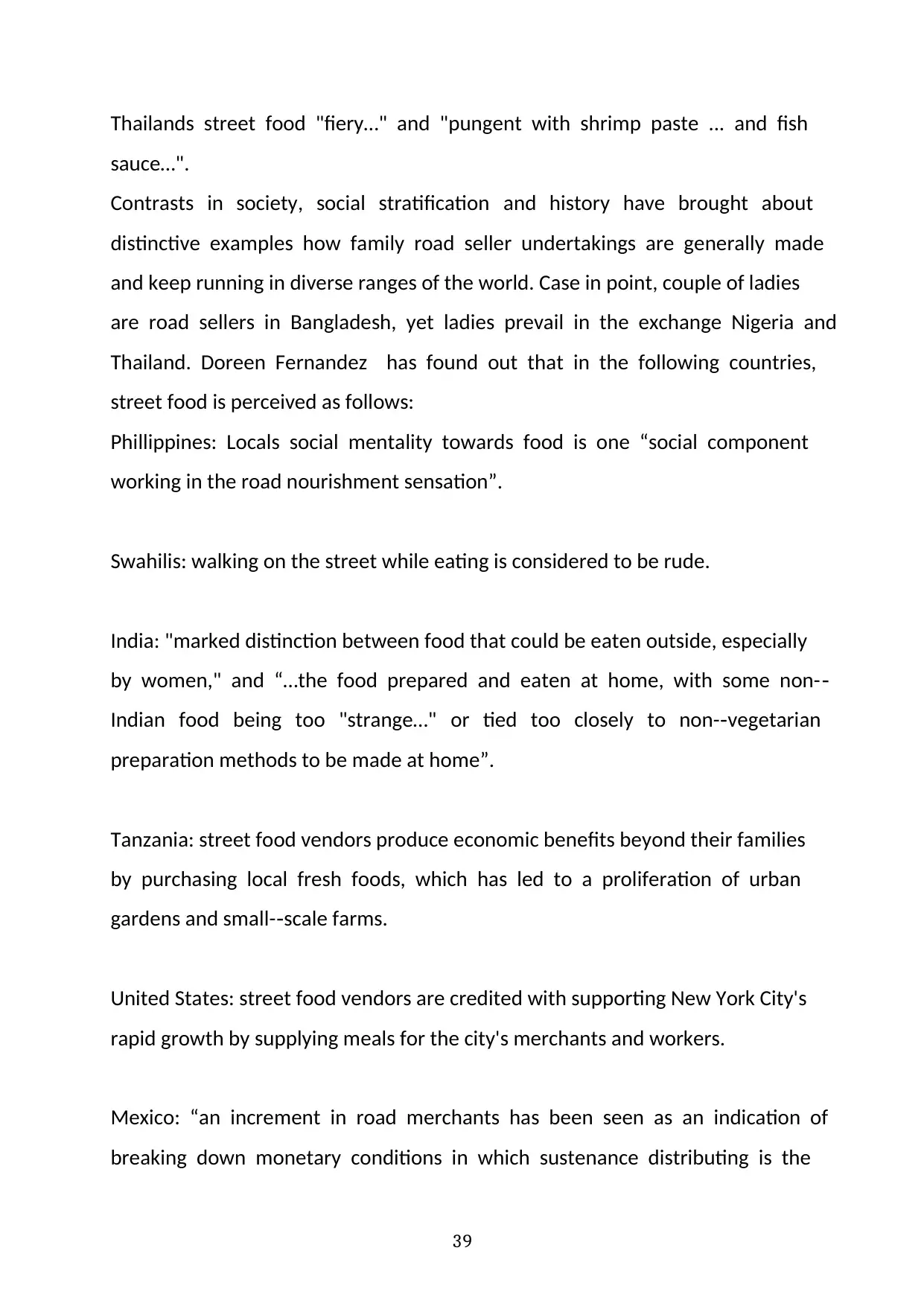
39
Thailands street food "fiery…" and "pungent with shrimp paste ... and fish
sauce…".
Contrasts in society, social stratification and history have brought about
distinctive examples how family road seller undertakings are generally made
and keep running in diverse ranges of the world. Case in point, couple of ladies
are road sellers in Bangladesh, yet ladies prevail in the exchange Nigeria and
Thailand. Doreen Fernandez has found out that in the following countries,
street food is perceived as follows:
Phillippines: Locals social mentality towards food is one “social component
working in the road nourishment sensation”.
Swahilis: walking on the street while eating is considered to be rude.
India: "marked distinction between food that could be eaten outside, especially
by women," and “…the food prepared and eaten at home, with some non- ‐
Indian food being too "strange…" or tied too closely to non- vegetarian‐
preparation methods to be made at home”.
Tanzania: street food vendors produce economic benefits beyond their families
by purchasing local fresh foods, which has led to a proliferation of urban
gardens and small- scale farms.‐
United States: street food vendors are credited with supporting New York City's
rapid growth by supplying meals for the city's merchants and workers.
Mexico: “an increment in road merchants has been seen as an indication of
breaking down monetary conditions in which sustenance distributing is the
Thailands street food "fiery…" and "pungent with shrimp paste ... and fish
sauce…".
Contrasts in society, social stratification and history have brought about
distinctive examples how family road seller undertakings are generally made
and keep running in diverse ranges of the world. Case in point, couple of ladies
are road sellers in Bangladesh, yet ladies prevail in the exchange Nigeria and
Thailand. Doreen Fernandez has found out that in the following countries,
street food is perceived as follows:
Phillippines: Locals social mentality towards food is one “social component
working in the road nourishment sensation”.
Swahilis: walking on the street while eating is considered to be rude.
India: "marked distinction between food that could be eaten outside, especially
by women," and “…the food prepared and eaten at home, with some non- ‐
Indian food being too "strange…" or tied too closely to non- vegetarian‐
preparation methods to be made at home”.
Tanzania: street food vendors produce economic benefits beyond their families
by purchasing local fresh foods, which has led to a proliferation of urban
gardens and small- scale farms.‐
United States: street food vendors are credited with supporting New York City's
rapid growth by supplying meals for the city's merchants and workers.
Mexico: “an increment in road merchants has been seen as an indication of
breaking down monetary conditions in which sustenance distributing is the
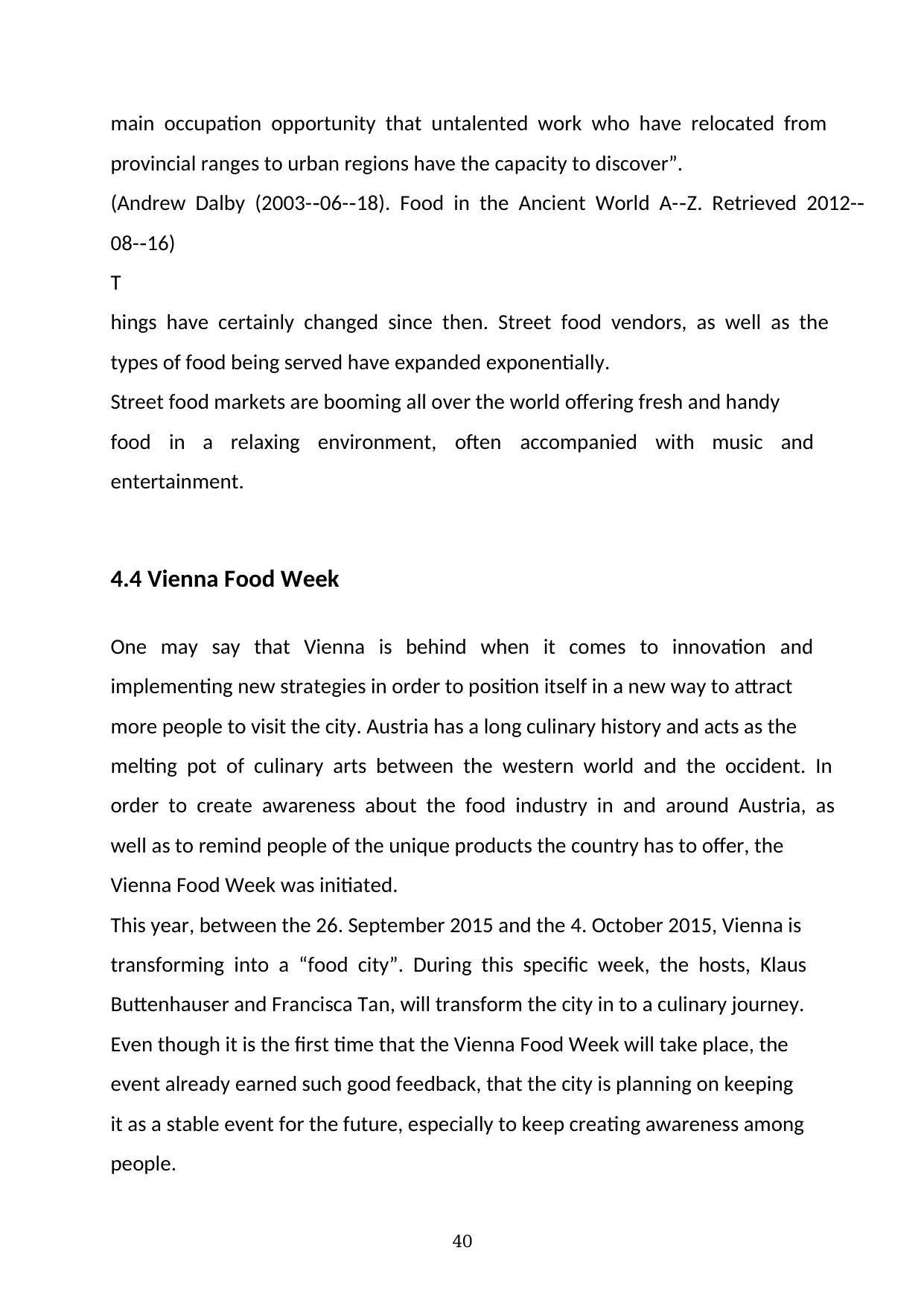
40
main occupation opportunity that untalented work who have relocated from
provincial ranges to urban regions have the capacity to discover”.
(Andrew Dalby (2003- 06- 18). Food in the Ancient World A- Z. Retrieved 2012-‐ ‐ ‐ ‐
08- 16)‐
T
hings have certainly changed since then. Street food vendors, as well as the
types of food being served have expanded exponentially.
Street food markets are booming all over the world offering fresh and handy
food in a relaxing environment, often accompanied with music and
entertainment.
4.4 Vienna Food Week
One may say that Vienna is behind when it comes to innovation and
implementing new strategies in order to position itself in a new way to attract
more people to visit the city. Austria has a long culinary history and acts as the
melting pot of culinary arts between the western world and the occident. In
order to create awareness about the food industry in and around Austria, as
well as to remind people of the unique products the country has to offer, the
Vienna Food Week was initiated.
This year, between the 26. September 2015 and the 4. October 2015, Vienna is
transforming into a “food city”. During this specific week, the hosts, Klaus
Buttenhauser and Francisca Tan, will transform the city in to a culinary journey.
Even though it is the first time that the Vienna Food Week will take place, the
event already earned such good feedback, that the city is planning on keeping
it as a stable event for the future, especially to keep creating awareness among
people.
main occupation opportunity that untalented work who have relocated from
provincial ranges to urban regions have the capacity to discover”.
(Andrew Dalby (2003- 06- 18). Food in the Ancient World A- Z. Retrieved 2012-‐ ‐ ‐ ‐
08- 16)‐
T
hings have certainly changed since then. Street food vendors, as well as the
types of food being served have expanded exponentially.
Street food markets are booming all over the world offering fresh and handy
food in a relaxing environment, often accompanied with music and
entertainment.
4.4 Vienna Food Week
One may say that Vienna is behind when it comes to innovation and
implementing new strategies in order to position itself in a new way to attract
more people to visit the city. Austria has a long culinary history and acts as the
melting pot of culinary arts between the western world and the occident. In
order to create awareness about the food industry in and around Austria, as
well as to remind people of the unique products the country has to offer, the
Vienna Food Week was initiated.
This year, between the 26. September 2015 and the 4. October 2015, Vienna is
transforming into a “food city”. During this specific week, the hosts, Klaus
Buttenhauser and Francisca Tan, will transform the city in to a culinary journey.
Even though it is the first time that the Vienna Food Week will take place, the
event already earned such good feedback, that the city is planning on keeping
it as a stable event for the future, especially to keep creating awareness among
people.
Secure Best Marks with AI Grader
Need help grading? Try our AI Grader for instant feedback on your assignments.
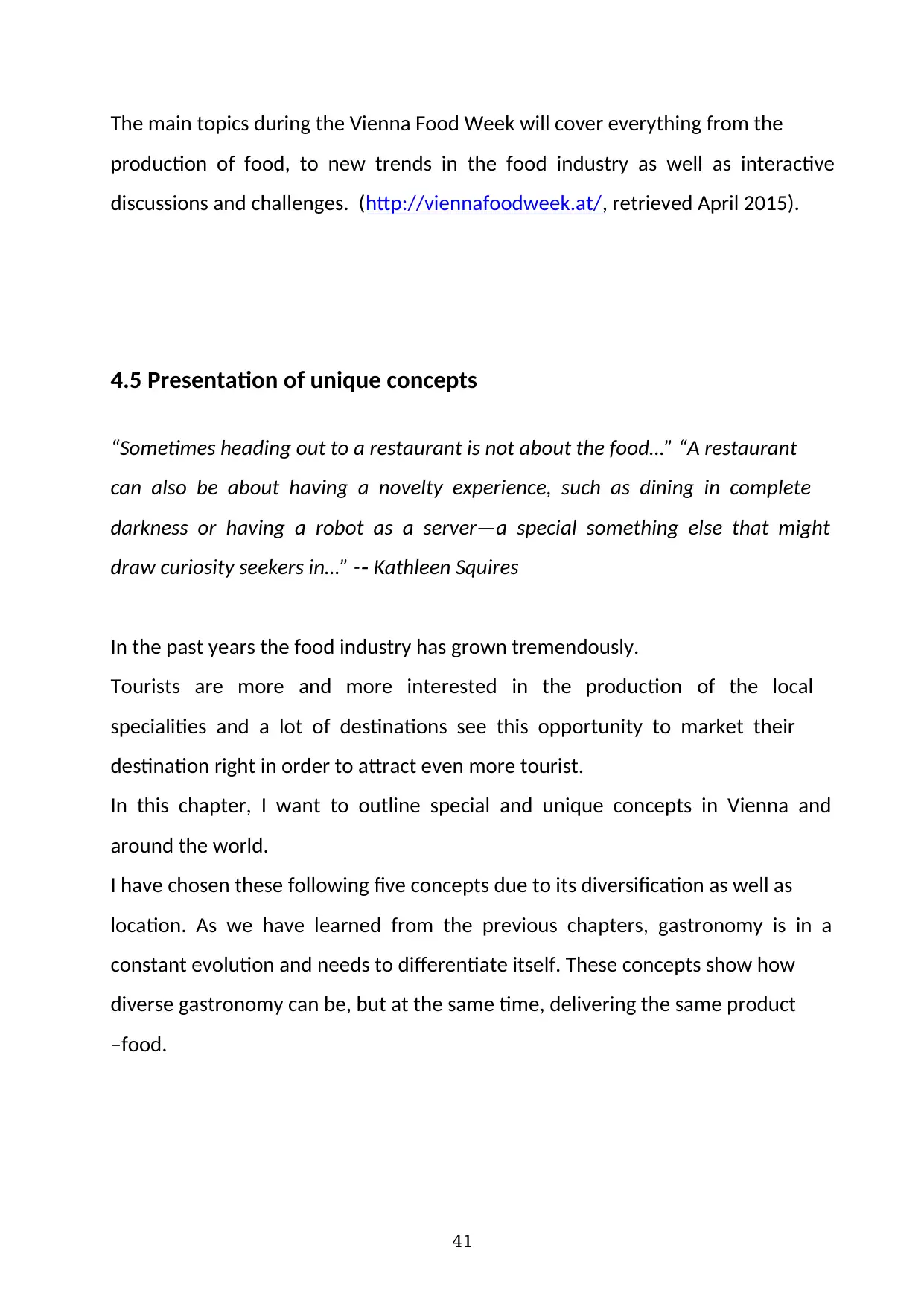
41
The main topics during the Vienna Food Week will cover everything from the
production of food, to new trends in the food industry as well as interactive
discussions and challenges. (http://viennafoodweek.at/, retrieved April 2015).
4.5 Presentation of unique concepts
“Sometimes heading out to a restaurant is not about the food…” “A restaurant
can also be about having a novelty experience, such as dining in complete
darkness or having a robot as a server—a special something else that might
draw curiosity seekers in…” - Kathleen Squires‐
In the past years the food industry has grown tremendously.
Tourists are more and more interested in the production of the local
specialities and a lot of destinations see this opportunity to market their
destination right in order to attract even more tourist.
In this chapter, I want to outline special and unique concepts in Vienna and
around the world.
I have chosen these following five concepts due to its diversification as well as
location. As we have learned from the previous chapters, gastronomy is in a
constant evolution and needs to differentiate itself. These concepts show how
diverse gastronomy can be, but at the same time, delivering the same product
–food.
The main topics during the Vienna Food Week will cover everything from the
production of food, to new trends in the food industry as well as interactive
discussions and challenges. (http://viennafoodweek.at/, retrieved April 2015).
4.5 Presentation of unique concepts
“Sometimes heading out to a restaurant is not about the food…” “A restaurant
can also be about having a novelty experience, such as dining in complete
darkness or having a robot as a server—a special something else that might
draw curiosity seekers in…” - Kathleen Squires‐
In the past years the food industry has grown tremendously.
Tourists are more and more interested in the production of the local
specialities and a lot of destinations see this opportunity to market their
destination right in order to attract even more tourist.
In this chapter, I want to outline special and unique concepts in Vienna and
around the world.
I have chosen these following five concepts due to its diversification as well as
location. As we have learned from the previous chapters, gastronomy is in a
constant evolution and needs to differentiate itself. These concepts show how
diverse gastronomy can be, but at the same time, delivering the same product
–food.
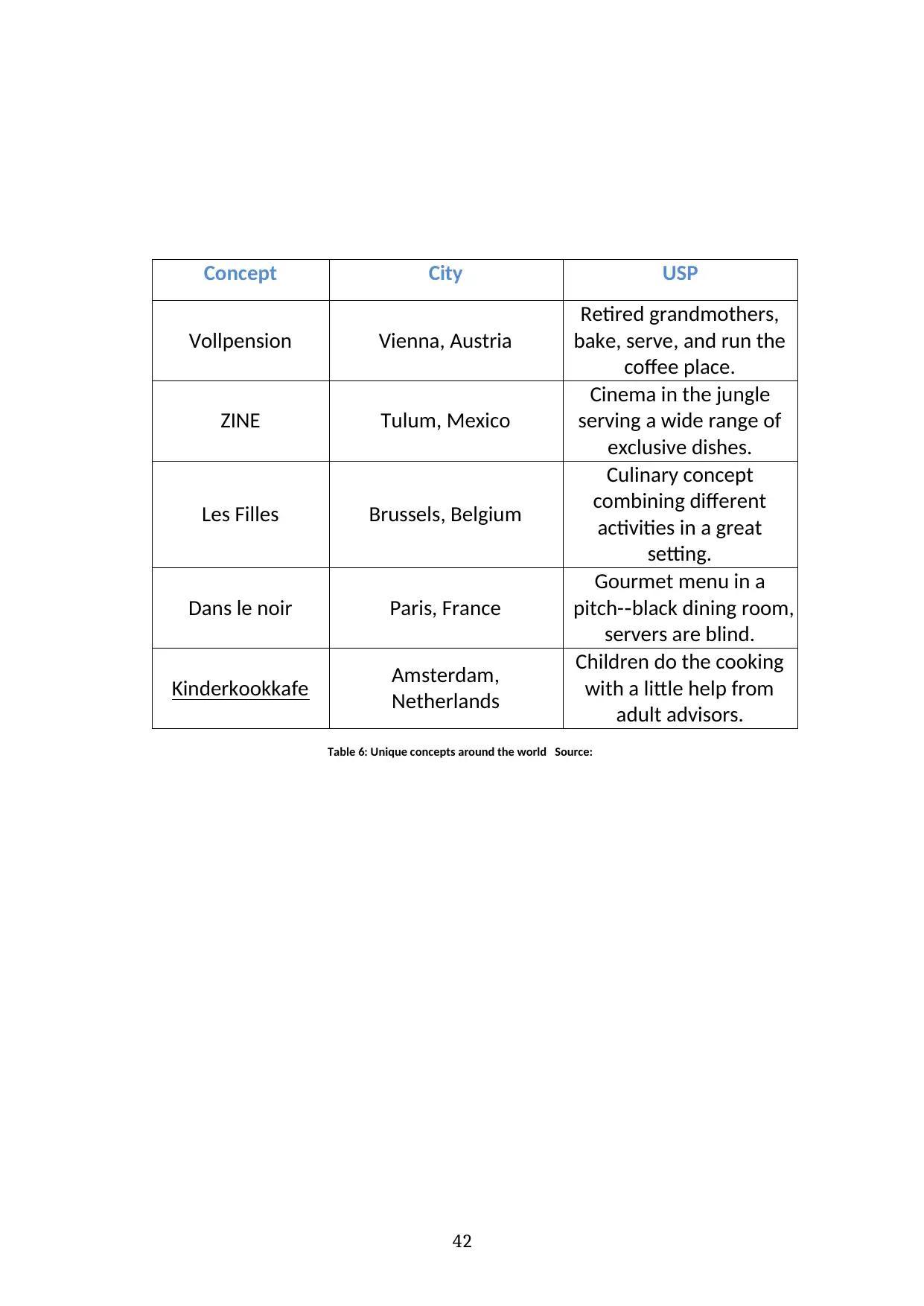
42
Table 6: Unique concepts around the world Source:
Concept City USP
Vollpension Vienna, Austria
Retired grandmothers,
bake, serve, and run the
coffee place.
ZINE Tulum, Mexico
Cinema in the jungle
serving a wide range of
exclusive dishes.
Les Filles Brussels, Belgium
Culinary concept
combining different
activities in a great
setting.
Dans le noir Paris, France
Gourmet menu in a
pitch- black dining room,‐
servers are blind.
Kinderkookkafe Amsterdam,
Netherlands
Children do the cooking
with a little help from
adult advisors.
Table 6: Unique concepts around the world Source:
Concept City USP
Vollpension Vienna, Austria
Retired grandmothers,
bake, serve, and run the
coffee place.
ZINE Tulum, Mexico
Cinema in the jungle
serving a wide range of
exclusive dishes.
Les Filles Brussels, Belgium
Culinary concept
combining different
activities in a great
setting.
Dans le noir Paris, France
Gourmet menu in a
pitch- black dining room,‐
servers are blind.
Kinderkookkafe Amsterdam,
Netherlands
Children do the cooking
with a little help from
adult advisors.
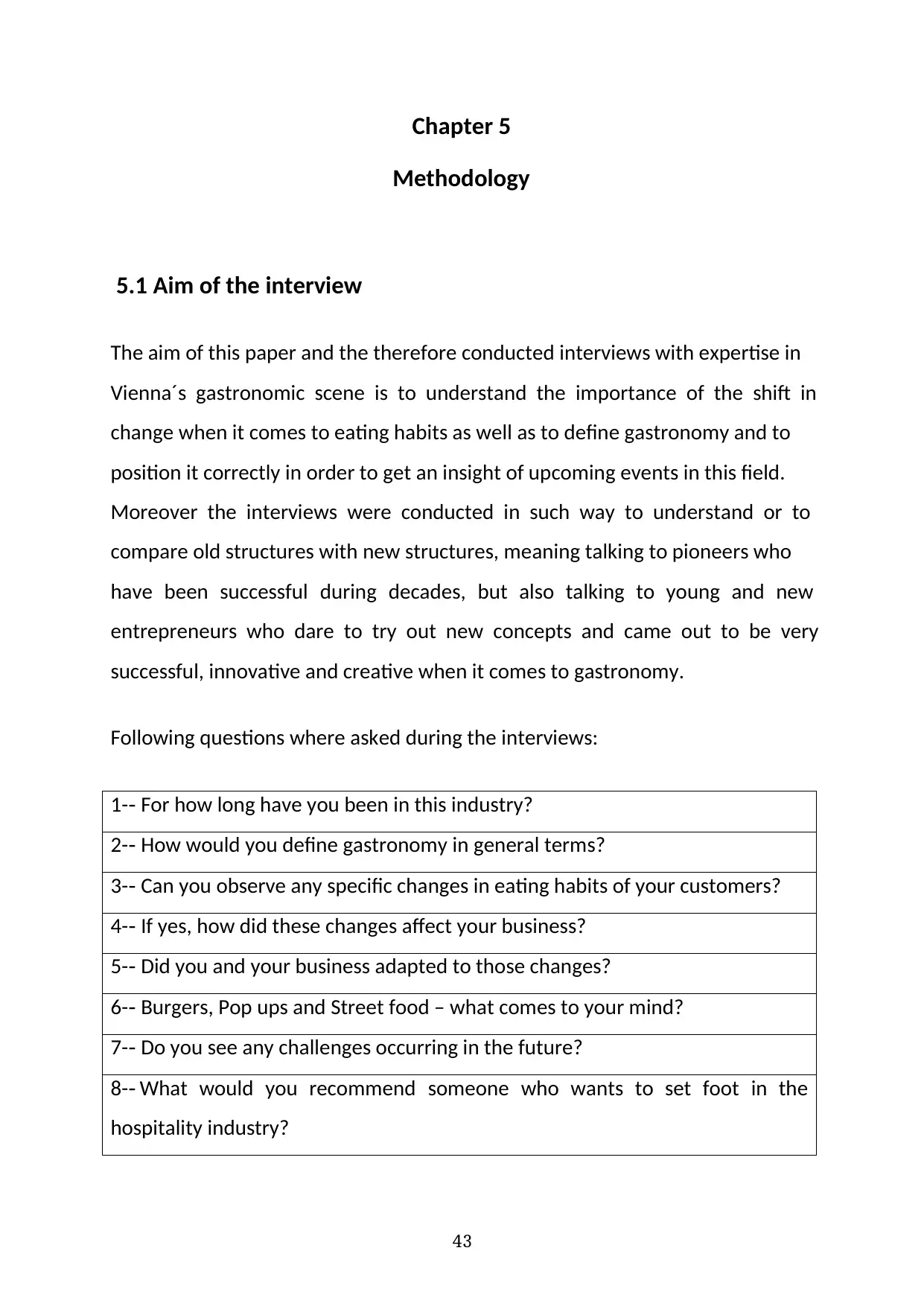
43
Chapter 5
Methodology
5.1 Aim of the interview
The aim of this paper and the therefore conducted interviews with expertise in
Vienna´s gastronomic scene is to understand the importance of the shift in
change when it comes to eating habits as well as to define gastronomy and to
position it correctly in order to get an insight of upcoming events in this field.
Moreover the interviews were conducted in such way to understand or to
compare old structures with new structures, meaning talking to pioneers who
have been successful during decades, but also talking to young and new
entrepreneurs who dare to try out new concepts and came out to be very
successful, innovative and creative when it comes to gastronomy.
Following questions where asked during the interviews:
1- For how long have you been in this industry?‐
2- How would you define gastronomy in general terms?‐
3- Can you observe any specific changes in eating habits of your customers?‐
4- If yes, how did these changes affect your business?‐
5- Did you and your business adapted to those changes?‐
6- Burgers, Pop ups and Street food – what comes to your mind?‐
7- Do you see any challenges occurring in the future?‐
8-‐ What would you recommend someone who wants to set foot in the
hospitality industry?
Chapter 5
Methodology
5.1 Aim of the interview
The aim of this paper and the therefore conducted interviews with expertise in
Vienna´s gastronomic scene is to understand the importance of the shift in
change when it comes to eating habits as well as to define gastronomy and to
position it correctly in order to get an insight of upcoming events in this field.
Moreover the interviews were conducted in such way to understand or to
compare old structures with new structures, meaning talking to pioneers who
have been successful during decades, but also talking to young and new
entrepreneurs who dare to try out new concepts and came out to be very
successful, innovative and creative when it comes to gastronomy.
Following questions where asked during the interviews:
1- For how long have you been in this industry?‐
2- How would you define gastronomy in general terms?‐
3- Can you observe any specific changes in eating habits of your customers?‐
4- If yes, how did these changes affect your business?‐
5- Did you and your business adapted to those changes?‐
6- Burgers, Pop ups and Street food – what comes to your mind?‐
7- Do you see any challenges occurring in the future?‐
8-‐ What would you recommend someone who wants to set foot in the
hospitality industry?
Paraphrase This Document
Need a fresh take? Get an instant paraphrase of this document with our AI Paraphraser
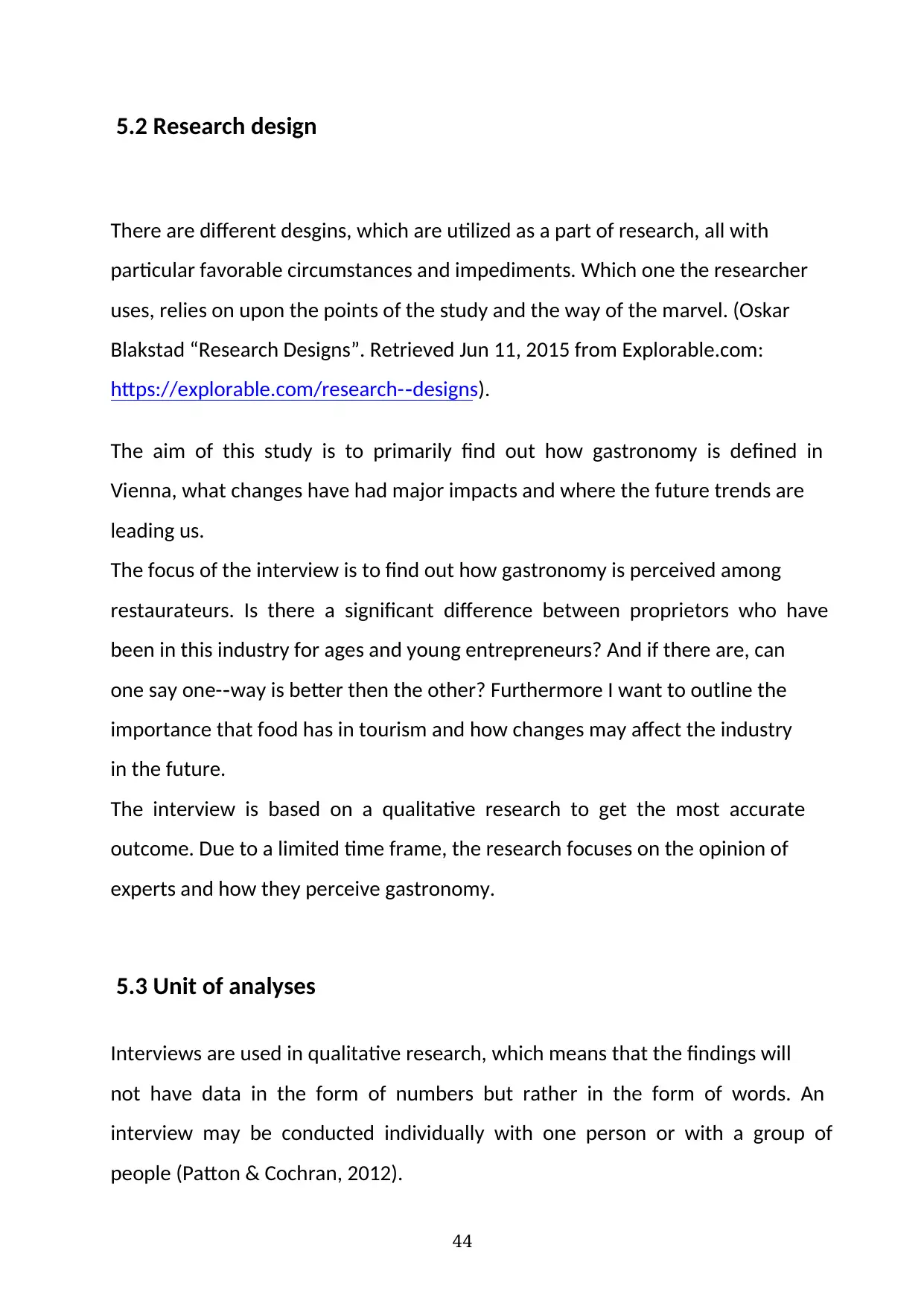
44
5.2 Research design
There are different desgins, which are utilized as a part of research, all with
particular favorable circumstances and impediments. Which one the researcher
uses, relies on upon the points of the study and the way of the marvel. (Oskar
Blakstad “Research Designs”. Retrieved Jun 11, 2015 from Explorable.com:
https://explorable.com/research- designs‐ ).
The aim of this study is to primarily find out how gastronomy is defined in
Vienna, what changes have had major impacts and where the future trends are
leading us.
The focus of the interview is to find out how gastronomy is perceived among
restaurateurs. Is there a significant difference between proprietors who have
been in this industry for ages and young entrepreneurs? And if there are, can
one say one- way is better then the other? Furthermore I want to outline the‐
importance that food has in tourism and how changes may affect the industry
in the future.
The interview is based on a qualitative research to get the most accurate
outcome. Due to a limited time frame, the research focuses on the opinion of
experts and how they perceive gastronomy.
5.3 Unit of analyses
Interviews are used in qualitative research, which means that the findings will
not have data in the form of numbers but rather in the form of words. An
interview may be conducted individually with one person or with a group of
people (Patton & Cochran, 2012).
5.2 Research design
There are different desgins, which are utilized as a part of research, all with
particular favorable circumstances and impediments. Which one the researcher
uses, relies on upon the points of the study and the way of the marvel. (Oskar
Blakstad “Research Designs”. Retrieved Jun 11, 2015 from Explorable.com:
https://explorable.com/research- designs‐ ).
The aim of this study is to primarily find out how gastronomy is defined in
Vienna, what changes have had major impacts and where the future trends are
leading us.
The focus of the interview is to find out how gastronomy is perceived among
restaurateurs. Is there a significant difference between proprietors who have
been in this industry for ages and young entrepreneurs? And if there are, can
one say one- way is better then the other? Furthermore I want to outline the‐
importance that food has in tourism and how changes may affect the industry
in the future.
The interview is based on a qualitative research to get the most accurate
outcome. Due to a limited time frame, the research focuses on the opinion of
experts and how they perceive gastronomy.
5.3 Unit of analyses
Interviews are used in qualitative research, which means that the findings will
not have data in the form of numbers but rather in the form of words. An
interview may be conducted individually with one person or with a group of
people (Patton & Cochran, 2012).
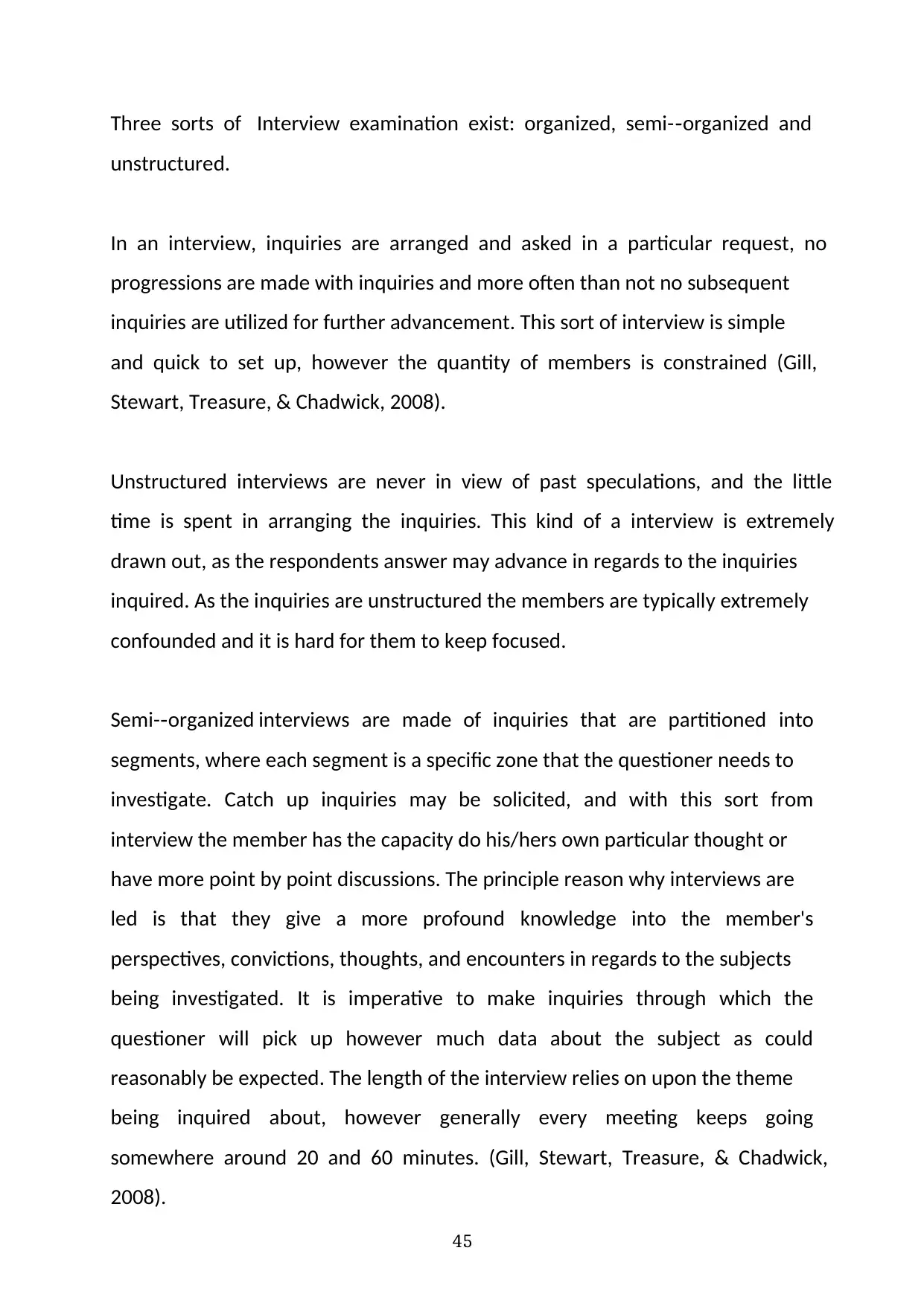
45
Three sorts of Interview examination exist: organized, semi- organized and‐
unstructured.
In an interview, inquiries are arranged and asked in a particular request, no
progressions are made with inquiries and more often than not no subsequent
inquiries are utilized for further advancement. This sort of interview is simple
and quick to set up, however the quantity of members is constrained (Gill,
Stewart, Treasure, & Chadwick, 2008).
Unstructured interviews are never in view of past speculations, and the little
time is spent in arranging the inquiries. This kind of a interview is extremely
drawn out, as the respondents answer may advance in regards to the inquiries
inquired. As the inquiries are unstructured the members are typically extremely
confounded and it is hard for them to keep focused.
Semi- organized‐ interviews are made of inquiries that are partitioned into
segments, where each segment is a specific zone that the questioner needs to
investigate. Catch up inquiries may be solicited, and with this sort from
interview the member has the capacity do his/hers own particular thought or
have more point by point discussions. The principle reason why interviews are
led is that they give a more profound knowledge into the member's
perspectives, convictions, thoughts, and encounters in regards to the subjects
being investigated. It is imperative to make inquiries through which the
questioner will pick up however much data about the subject as could
reasonably be expected. The length of the interview relies on upon the theme
being inquired about, however generally every meeting keeps going
somewhere around 20 and 60 minutes. (Gill, Stewart, Treasure, & Chadwick,
2008).
Three sorts of Interview examination exist: organized, semi- organized and‐
unstructured.
In an interview, inquiries are arranged and asked in a particular request, no
progressions are made with inquiries and more often than not no subsequent
inquiries are utilized for further advancement. This sort of interview is simple
and quick to set up, however the quantity of members is constrained (Gill,
Stewart, Treasure, & Chadwick, 2008).
Unstructured interviews are never in view of past speculations, and the little
time is spent in arranging the inquiries. This kind of a interview is extremely
drawn out, as the respondents answer may advance in regards to the inquiries
inquired. As the inquiries are unstructured the members are typically extremely
confounded and it is hard for them to keep focused.
Semi- organized‐ interviews are made of inquiries that are partitioned into
segments, where each segment is a specific zone that the questioner needs to
investigate. Catch up inquiries may be solicited, and with this sort from
interview the member has the capacity do his/hers own particular thought or
have more point by point discussions. The principle reason why interviews are
led is that they give a more profound knowledge into the member's
perspectives, convictions, thoughts, and encounters in regards to the subjects
being investigated. It is imperative to make inquiries through which the
questioner will pick up however much data about the subject as could
reasonably be expected. The length of the interview relies on upon the theme
being inquired about, however generally every meeting keeps going
somewhere around 20 and 60 minutes. (Gill, Stewart, Treasure, & Chadwick,
2008).
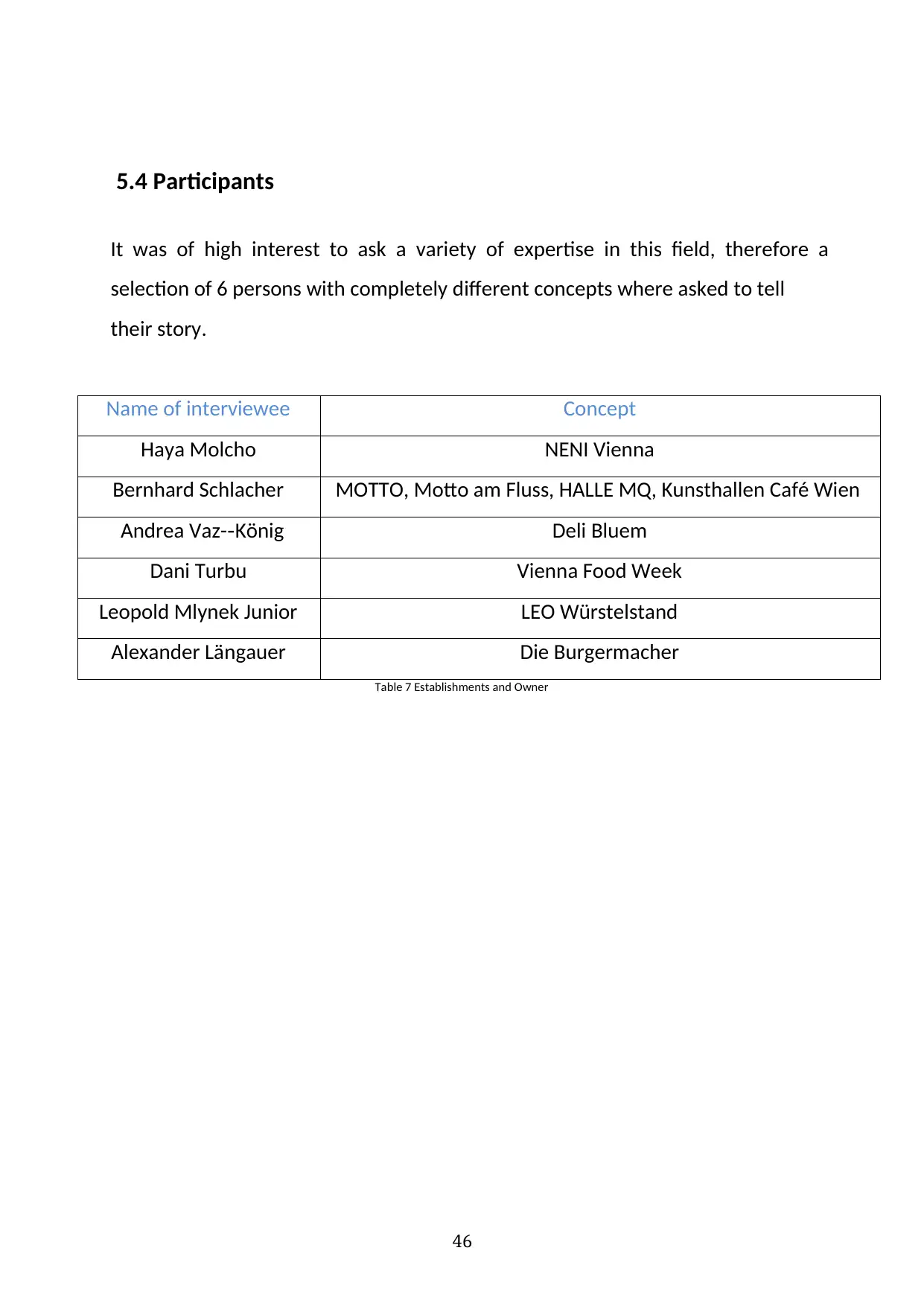
46
5.4 Participants
It was of high interest to ask a variety of expertise in this field, therefore a
selection of 6 persons with completely different concepts where asked to tell
their story.
Name of interviewee Concept
Haya Molcho NENI Vienna
Bernhard Schlacher MOTTO, Motto am Fluss, HALLE MQ, Kunsthallen Café Wien
Andrea Vaz- König‐ Deli Bluem
Dani Turbu Vienna Food Week
Leopold Mlynek Junior LEO Würstelstand
Alexander Längauer Die Burgermacher
Table 7 Establishments and Owner
5.4 Participants
It was of high interest to ask a variety of expertise in this field, therefore a
selection of 6 persons with completely different concepts where asked to tell
their story.
Name of interviewee Concept
Haya Molcho NENI Vienna
Bernhard Schlacher MOTTO, Motto am Fluss, HALLE MQ, Kunsthallen Café Wien
Andrea Vaz- König‐ Deli Bluem
Dani Turbu Vienna Food Week
Leopold Mlynek Junior LEO Würstelstand
Alexander Längauer Die Burgermacher
Table 7 Establishments and Owner
Secure Best Marks with AI Grader
Need help grading? Try our AI Grader for instant feedback on your assignments.

47
5.5 Selection criteria
The main criteria used to distinguish where as follows:
a. Concept: In order to show the diversity of establishments based in
Vienna, as well on the different thinking approaches, why and how
is this concept working?
a. Age: Having a mix of different age ranges will show if there is a
difference whether someone has been in the industry for ages or
not.
b. Gender: Is there a connection between gender and the industry?
c. Professional: Does someone who has reached a certain academic
level have a better understanding of the industry?
d. Cultural background: Are restaurateurs who have a different
cultural background successful in Vienna?
Criteria selection Result
Samples size 6
Females 3
Males 3
Age range >50 years 1
Between 40 and 50 years 2
Under 30 years 3
Other nationality than Austrian 1
Other professional background than
gastronomy
4
5.5 Selection criteria
The main criteria used to distinguish where as follows:
a. Concept: In order to show the diversity of establishments based in
Vienna, as well on the different thinking approaches, why and how
is this concept working?
a. Age: Having a mix of different age ranges will show if there is a
difference whether someone has been in the industry for ages or
not.
b. Gender: Is there a connection between gender and the industry?
c. Professional: Does someone who has reached a certain academic
level have a better understanding of the industry?
d. Cultural background: Are restaurateurs who have a different
cultural background successful in Vienna?
Criteria selection Result
Samples size 6
Females 3
Males 3
Age range >50 years 1
Between 40 and 50 years 2
Under 30 years 3
Other nationality than Austrian 1
Other professional background than
gastronomy
4
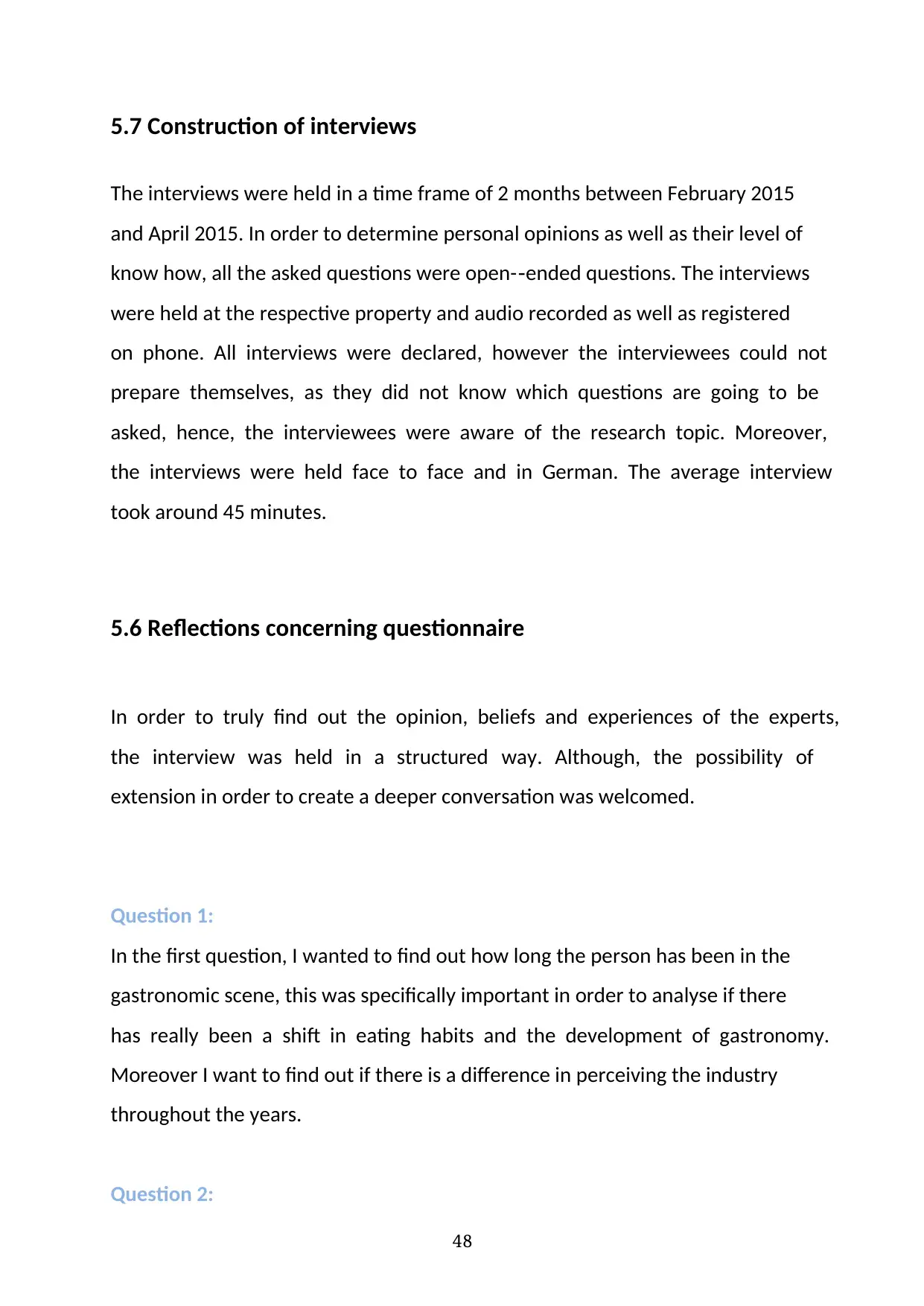
48
5.7 Construction of interviews
The interviews were held in a time frame of 2 months between February 2015
and April 2015. In order to determine personal opinions as well as their level of
know how, all the asked questions were open- ended questions. The interviews‐
were held at the respective property and audio recorded as well as registered
on phone. All interviews were declared, however the interviewees could not
prepare themselves, as they did not know which questions are going to be
asked, hence, the interviewees were aware of the research topic. Moreover,
the interviews were held face to face and in German. The average interview
took around 45 minutes.
5.6 Reflections concerning questionnaire
In order to truly find out the opinion, beliefs and experiences of the experts,
the interview was held in a structured way. Although, the possibility of
extension in order to create a deeper conversation was welcomed.
Question 1:
In the first question, I wanted to find out how long the person has been in the
gastronomic scene, this was specifically important in order to analyse if there
has really been a shift in eating habits and the development of gastronomy.
Moreover I want to find out if there is a difference in perceiving the industry
throughout the years.
Question 2:
5.7 Construction of interviews
The interviews were held in a time frame of 2 months between February 2015
and April 2015. In order to determine personal opinions as well as their level of
know how, all the asked questions were open- ended questions. The interviews‐
were held at the respective property and audio recorded as well as registered
on phone. All interviews were declared, however the interviewees could not
prepare themselves, as they did not know which questions are going to be
asked, hence, the interviewees were aware of the research topic. Moreover,
the interviews were held face to face and in German. The average interview
took around 45 minutes.
5.6 Reflections concerning questionnaire
In order to truly find out the opinion, beliefs and experiences of the experts,
the interview was held in a structured way. Although, the possibility of
extension in order to create a deeper conversation was welcomed.
Question 1:
In the first question, I wanted to find out how long the person has been in the
gastronomic scene, this was specifically important in order to analyse if there
has really been a shift in eating habits and the development of gastronomy.
Moreover I want to find out if there is a difference in perceiving the industry
throughout the years.
Question 2:
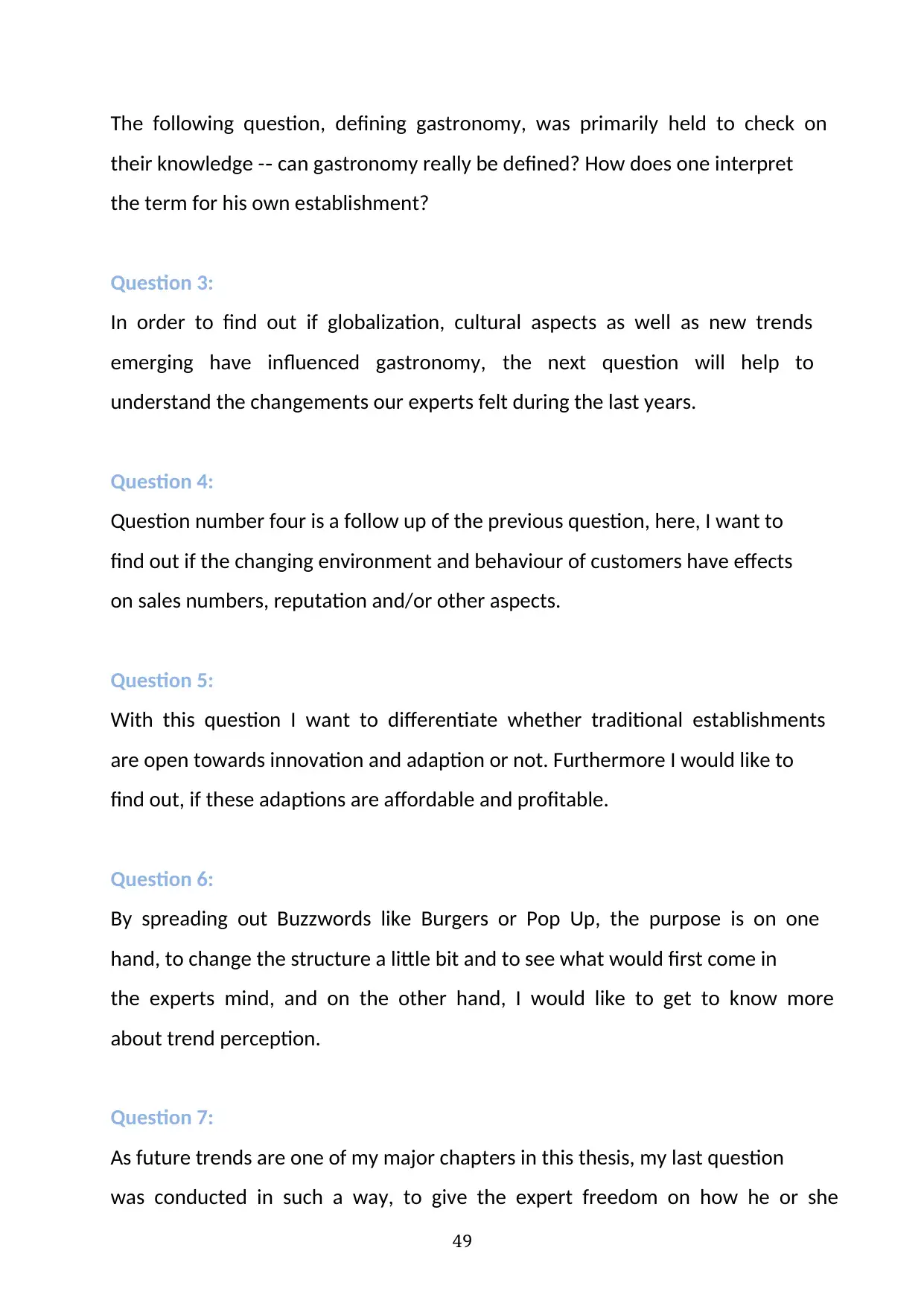
49
The following question, defining gastronomy, was primarily held to check on
their knowledge - can gastronomy really be defined? How does one interpret‐
the term for his own establishment?
Question 3:
In order to find out if globalization, cultural aspects as well as new trends
emerging have influenced gastronomy, the next question will help to
understand the changements our experts felt during the last years.
Question 4:
Question number four is a follow up of the previous question, here, I want to
find out if the changing environment and behaviour of customers have effects
on sales numbers, reputation and/or other aspects.
Question 5:
With this question I want to differentiate whether traditional establishments
are open towards innovation and adaption or not. Furthermore I would like to
find out, if these adaptions are affordable and profitable.
Question 6:
By spreading out Buzzwords like Burgers or Pop Up, the purpose is on one
hand, to change the structure a little bit and to see what would first come in
the experts mind, and on the other hand, I would like to get to know more
about trend perception.
Question 7:
As future trends are one of my major chapters in this thesis, my last question
was conducted in such a way, to give the expert freedom on how he or she
The following question, defining gastronomy, was primarily held to check on
their knowledge - can gastronomy really be defined? How does one interpret‐
the term for his own establishment?
Question 3:
In order to find out if globalization, cultural aspects as well as new trends
emerging have influenced gastronomy, the next question will help to
understand the changements our experts felt during the last years.
Question 4:
Question number four is a follow up of the previous question, here, I want to
find out if the changing environment and behaviour of customers have effects
on sales numbers, reputation and/or other aspects.
Question 5:
With this question I want to differentiate whether traditional establishments
are open towards innovation and adaption or not. Furthermore I would like to
find out, if these adaptions are affordable and profitable.
Question 6:
By spreading out Buzzwords like Burgers or Pop Up, the purpose is on one
hand, to change the structure a little bit and to see what would first come in
the experts mind, and on the other hand, I would like to get to know more
about trend perception.
Question 7:
As future trends are one of my major chapters in this thesis, my last question
was conducted in such a way, to give the expert freedom on how he or she
Paraphrase This Document
Need a fresh take? Get an instant paraphrase of this document with our AI Paraphraser

50
interprets “future challenges”. This is especially interesting in order to learn
more about competitiveness. Does a successful restaurateur admit weaknesses
or anxieties? Have he or she thought of giving up on gastronomy? Is
gastronomy an industry that remains for ever?
Question 8:
In this very last question, I wanted to find out what the motivation of the
expert towards their work is.
interprets “future challenges”. This is especially interesting in order to learn
more about competitiveness. Does a successful restaurateur admit weaknesses
or anxieties? Have he or she thought of giving up on gastronomy? Is
gastronomy an industry that remains for ever?
Question 8:
In this very last question, I wanted to find out what the motivation of the
expert towards their work is.
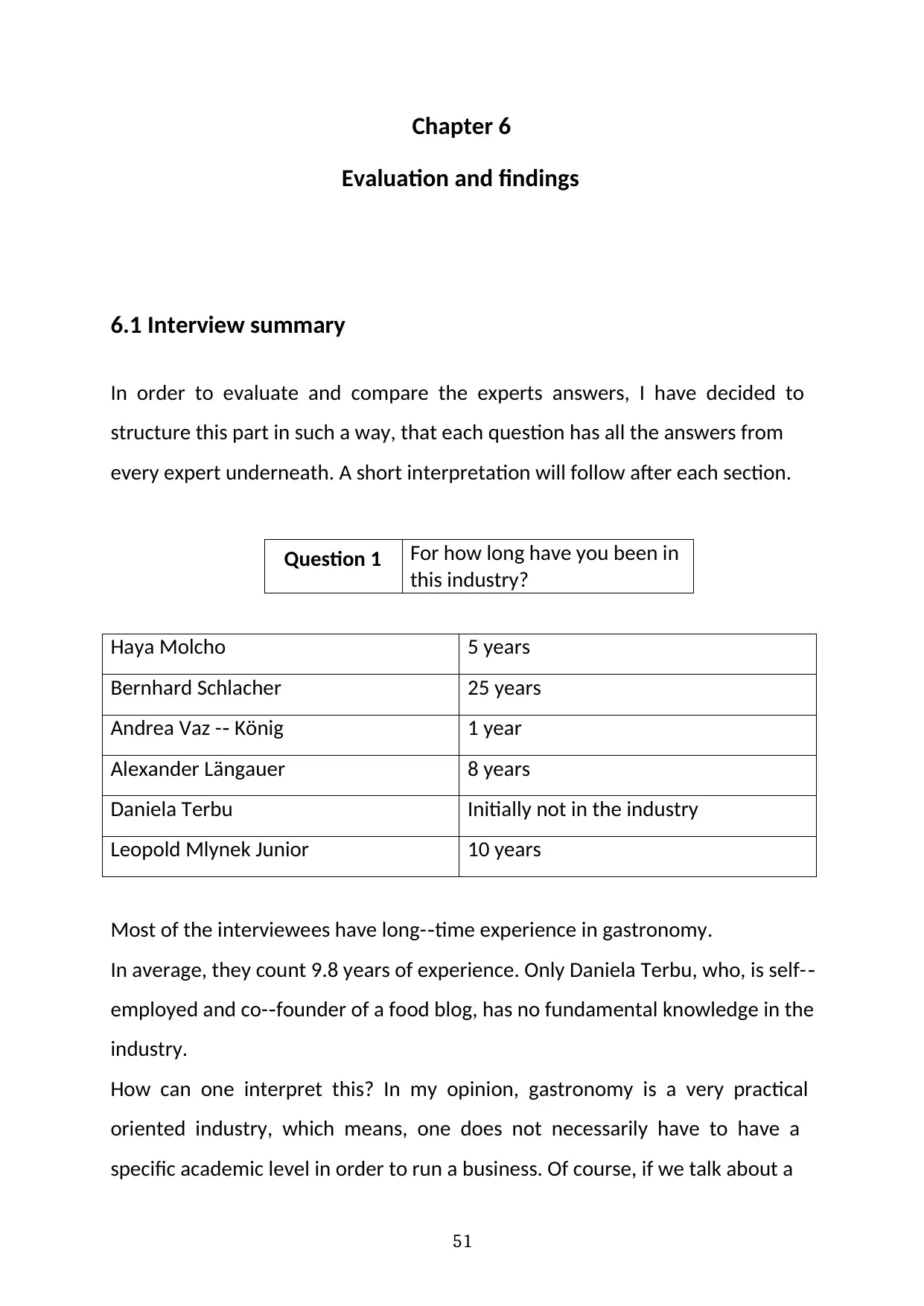
51
Chapter 6
Evaluation and findings
6.1 Interview summary
In order to evaluate and compare the experts answers, I have decided to
structure this part in such a way, that each question has all the answers from
every expert underneath. A short interpretation will follow after each section.
Question 1 For how long have you been in
this industry?
Haya Molcho 5 years
Bernhard Schlacher 25 years
Andrea Vaz - König‐ 1 year
Alexander Längauer 8 years
Daniela Terbu Initially not in the industry
Leopold Mlynek Junior 10 years
Most of the interviewees have long- time experience in gastronomy.‐
In average, they count 9.8 years of experience. Only Daniela Terbu, who, is self- ‐
employed and co- founder of a food blog, has no fundamental knowledge in the‐
industry.
How can one interpret this? In my opinion, gastronomy is a very practical
oriented industry, which means, one does not necessarily have to have a
specific academic level in order to run a business. Of course, if we talk about a
Chapter 6
Evaluation and findings
6.1 Interview summary
In order to evaluate and compare the experts answers, I have decided to
structure this part in such a way, that each question has all the answers from
every expert underneath. A short interpretation will follow after each section.
Question 1 For how long have you been in
this industry?
Haya Molcho 5 years
Bernhard Schlacher 25 years
Andrea Vaz - König‐ 1 year
Alexander Längauer 8 years
Daniela Terbu Initially not in the industry
Leopold Mlynek Junior 10 years
Most of the interviewees have long- time experience in gastronomy.‐
In average, they count 9.8 years of experience. Only Daniela Terbu, who, is self- ‐
employed and co- founder of a food blog, has no fundamental knowledge in the‐
industry.
How can one interpret this? In my opinion, gastronomy is a very practical
oriented industry, which means, one does not necessarily have to have a
specific academic level in order to run a business. Of course, if we talk about a

52
managerial position, one has to have a certain know how, but the industry is
seeking for people with passion and commitment towards work.
The perception of gastronomy from the interviewees’ point of view is all in all
very broad. None of them could find a stable definition, as literature already
showed, it is very hard to define the term gastronomy.
Summarized, one could say that gastronomy is about satisfying a human´s need
with passion, combined with the willingness to work hard for an optimal
outcome of a shared interest – in this case food.
Question 2 How would you define
gastronomy?
Haya Molcho Passion and the willingness to create
an environment of good food for the
soul.
Bernhard Schlacher Hard physical work.
Andrea Vaz - König‐ The well being. The sharing and
exchange of a common interest.
Alexander Längauer Satisfying people with good service.
Daniela Terbu Mixture of many factors such as
cultures, lifestyle and last but not
least – satisfying a human need.
Leopold Mlynek Junior Gastronomy is very diverse.
managerial position, one has to have a certain know how, but the industry is
seeking for people with passion and commitment towards work.
The perception of gastronomy from the interviewees’ point of view is all in all
very broad. None of them could find a stable definition, as literature already
showed, it is very hard to define the term gastronomy.
Summarized, one could say that gastronomy is about satisfying a human´s need
with passion, combined with the willingness to work hard for an optimal
outcome of a shared interest – in this case food.
Question 2 How would you define
gastronomy?
Haya Molcho Passion and the willingness to create
an environment of good food for the
soul.
Bernhard Schlacher Hard physical work.
Andrea Vaz - König‐ The well being. The sharing and
exchange of a common interest.
Alexander Längauer Satisfying people with good service.
Daniela Terbu Mixture of many factors such as
cultures, lifestyle and last but not
least – satisfying a human need.
Leopold Mlynek Junior Gastronomy is very diverse.
Secure Best Marks with AI Grader
Need help grading? Try our AI Grader for instant feedback on your assignments.
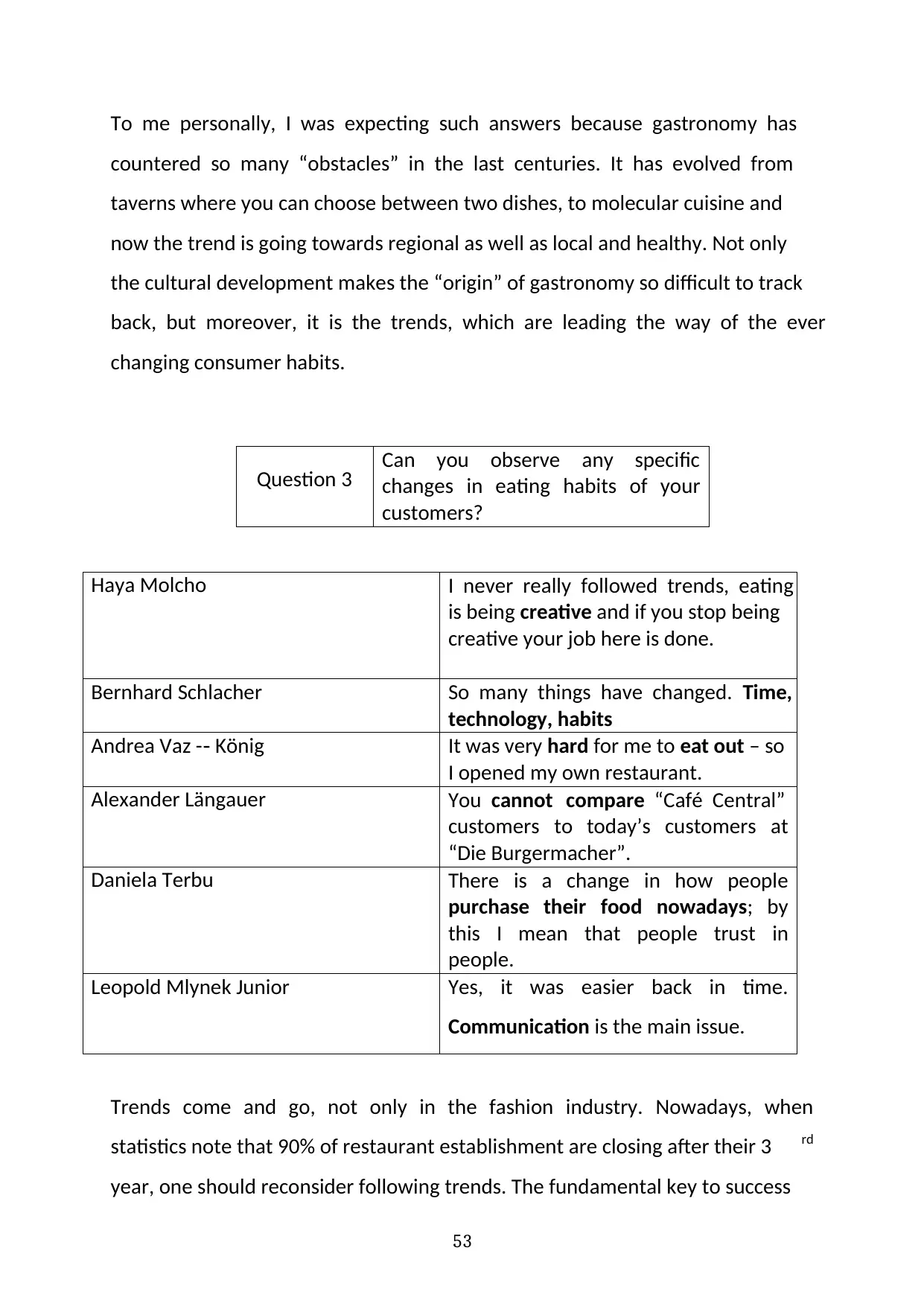
53
To me personally, I was expecting such answers because gastronomy has
countered so many “obstacles” in the last centuries. It has evolved from
taverns where you can choose between two dishes, to molecular cuisine and
now the trend is going towards regional as well as local and healthy. Not only
the cultural development makes the “origin” of gastronomy so difficult to track
back, but moreover, it is the trends, which are leading the way of the ever
changing consumer habits.
Trends come and go, not only in the fashion industry. Nowadays, when
statistics note that 90% of restaurant establishment are closing after their 3 rd
year, one should reconsider following trends. The fundamental key to success
Question 3 Can you observe any specific
changes in eating habits of your
customers?
Haya Molcho I never really followed trends, eating
is being creative and if you stop being
creative your job here is done.
Bernhard Schlacher So many things have changed. Time,
technology, habits
Andrea Vaz - König‐ It was very hard for me to eat out – so
I opened my own restaurant.
Alexander Längauer You cannot compare “Café Central”
customers to today’s customers at
“Die Burgermacher”.
Daniela Terbu There is a change in how people
purchase their food nowadays; by
this I mean that people trust in
people.
Leopold Mlynek Junior Yes, it was easier back in time.
Communication is the main issue.
To me personally, I was expecting such answers because gastronomy has
countered so many “obstacles” in the last centuries. It has evolved from
taverns where you can choose between two dishes, to molecular cuisine and
now the trend is going towards regional as well as local and healthy. Not only
the cultural development makes the “origin” of gastronomy so difficult to track
back, but moreover, it is the trends, which are leading the way of the ever
changing consumer habits.
Trends come and go, not only in the fashion industry. Nowadays, when
statistics note that 90% of restaurant establishment are closing after their 3 rd
year, one should reconsider following trends. The fundamental key to success
Question 3 Can you observe any specific
changes in eating habits of your
customers?
Haya Molcho I never really followed trends, eating
is being creative and if you stop being
creative your job here is done.
Bernhard Schlacher So many things have changed. Time,
technology, habits
Andrea Vaz - König‐ It was very hard for me to eat out – so
I opened my own restaurant.
Alexander Längauer You cannot compare “Café Central”
customers to today’s customers at
“Die Burgermacher”.
Daniela Terbu There is a change in how people
purchase their food nowadays; by
this I mean that people trust in
people.
Leopold Mlynek Junior Yes, it was easier back in time.
Communication is the main issue.

54
is an elaborated business plan. In order to achieve your goal of being
independent, market research is indispensible. One has to know his customers
as well as his competitive set and a business oriented thinking with a good
intuition when it comes to decision- making.‐
By comparing the answers of question number four within the experts, it is
easy to conclude, that if one wants to stay competitive and have long- term‐
success, it is of high importance to segment the market accordingly to your
establishment, try to target different audience groups as well as to be
confident with the product one is selling. I think if one´s passion is gastronomy,
endurance and patience are needed in order to fulfil the dream. I don’t think
Question 4 If yes, how did these changes affect
your business?
Haya Molcho I have launched my own supermarket
brand to reach new customers.
Bernhard Schlacher Differentiation through different
channels. In my case, I have serveral
target groups…
Andrea Vaz - König‐ I think that my restaurant was the
change.
Alexander Längauer I took over “Die Burgermacher” a
couple of months ago because the
previous owner could not handle the
pressure of competition.
Daniela Terbu -‐
Leopold Mlynek Junior People perceive sausages differently
then they used to. It is a hard
business.
is an elaborated business plan. In order to achieve your goal of being
independent, market research is indispensible. One has to know his customers
as well as his competitive set and a business oriented thinking with a good
intuition when it comes to decision- making.‐
By comparing the answers of question number four within the experts, it is
easy to conclude, that if one wants to stay competitive and have long- term‐
success, it is of high importance to segment the market accordingly to your
establishment, try to target different audience groups as well as to be
confident with the product one is selling. I think if one´s passion is gastronomy,
endurance and patience are needed in order to fulfil the dream. I don’t think
Question 4 If yes, how did these changes affect
your business?
Haya Molcho I have launched my own supermarket
brand to reach new customers.
Bernhard Schlacher Differentiation through different
channels. In my case, I have serveral
target groups…
Andrea Vaz - König‐ I think that my restaurant was the
change.
Alexander Längauer I took over “Die Burgermacher” a
couple of months ago because the
previous owner could not handle the
pressure of competition.
Daniela Terbu -‐
Leopold Mlynek Junior People perceive sausages differently
then they used to. It is a hard
business.
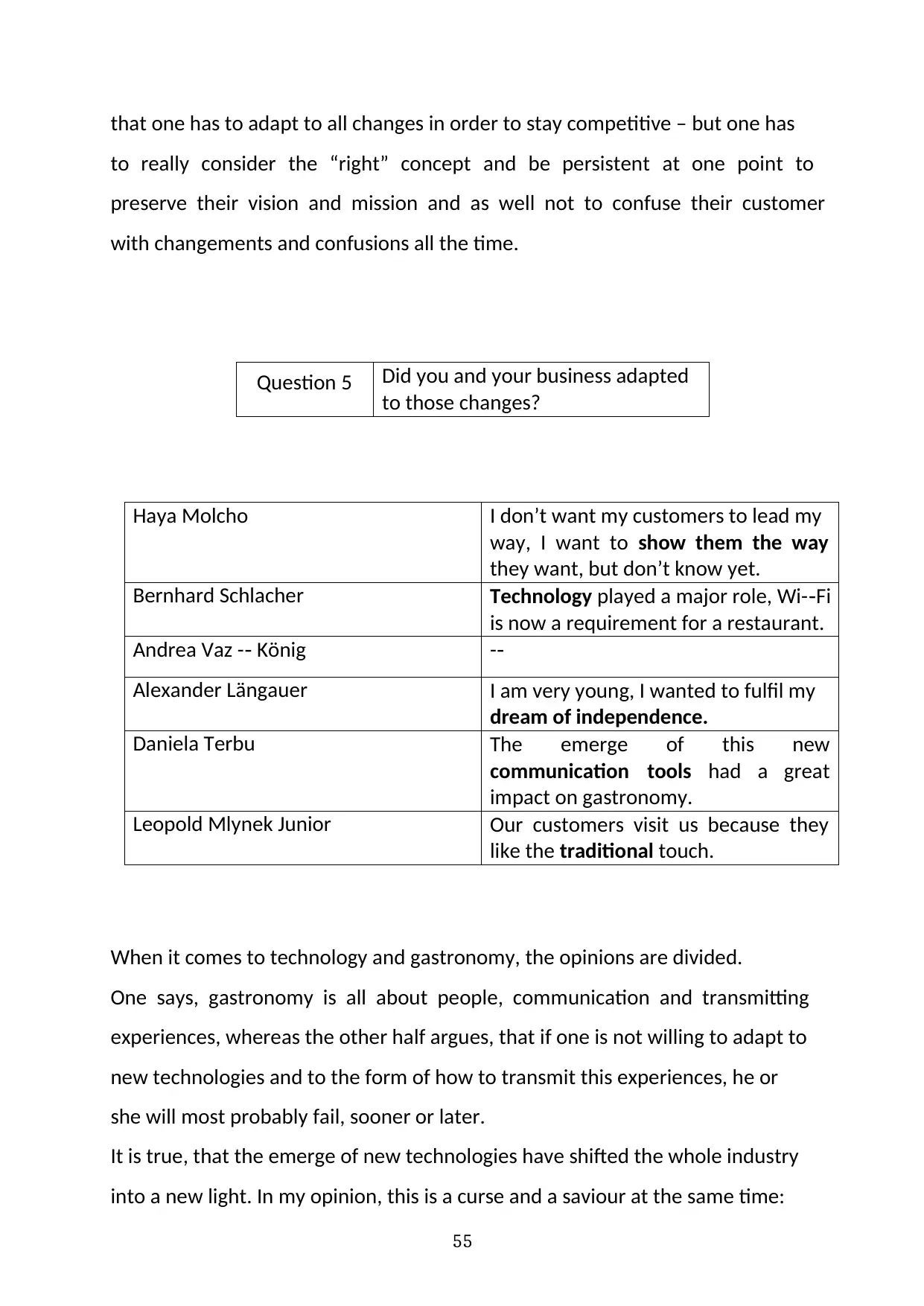
55
that one has to adapt to all changes in order to stay competitive – but one has
to really consider the “right” concept and be persistent at one point to
preserve their vision and mission and as well not to confuse their customer
with changements and confusions all the time.
When it comes to technology and gastronomy, the opinions are divided.
One says, gastronomy is all about people, communication and transmitting
experiences, whereas the other half argues, that if one is not willing to adapt to
new technologies and to the form of how to transmit this experiences, he or
she will most probably fail, sooner or later.
It is true, that the emerge of new technologies have shifted the whole industry
into a new light. In my opinion, this is a curse and a saviour at the same time:
Question 5 Did you and your business adapted
to those changes?
Haya Molcho I don’t want my customers to lead my
way, I want to show them the way
they want, but don’t know yet.
Bernhard Schlacher Technology played a major role, Wi- Fi‐
is now a requirement for a restaurant.
Andrea Vaz - König‐ -‐
Alexander Längauer I am very young, I wanted to fulfil my
dream of independence.
Daniela Terbu The emerge of this new
communication tools had a great
impact on gastronomy.
Leopold Mlynek Junior Our customers visit us because they
like the traditional touch.
that one has to adapt to all changes in order to stay competitive – but one has
to really consider the “right” concept and be persistent at one point to
preserve their vision and mission and as well not to confuse their customer
with changements and confusions all the time.
When it comes to technology and gastronomy, the opinions are divided.
One says, gastronomy is all about people, communication and transmitting
experiences, whereas the other half argues, that if one is not willing to adapt to
new technologies and to the form of how to transmit this experiences, he or
she will most probably fail, sooner or later.
It is true, that the emerge of new technologies have shifted the whole industry
into a new light. In my opinion, this is a curse and a saviour at the same time:
Question 5 Did you and your business adapted
to those changes?
Haya Molcho I don’t want my customers to lead my
way, I want to show them the way
they want, but don’t know yet.
Bernhard Schlacher Technology played a major role, Wi- Fi‐
is now a requirement for a restaurant.
Andrea Vaz - König‐ -‐
Alexander Längauer I am very young, I wanted to fulfil my
dream of independence.
Daniela Terbu The emerge of this new
communication tools had a great
impact on gastronomy.
Leopold Mlynek Junior Our customers visit us because they
like the traditional touch.
Paraphrase This Document
Need a fresh take? Get an instant paraphrase of this document with our AI Paraphraser
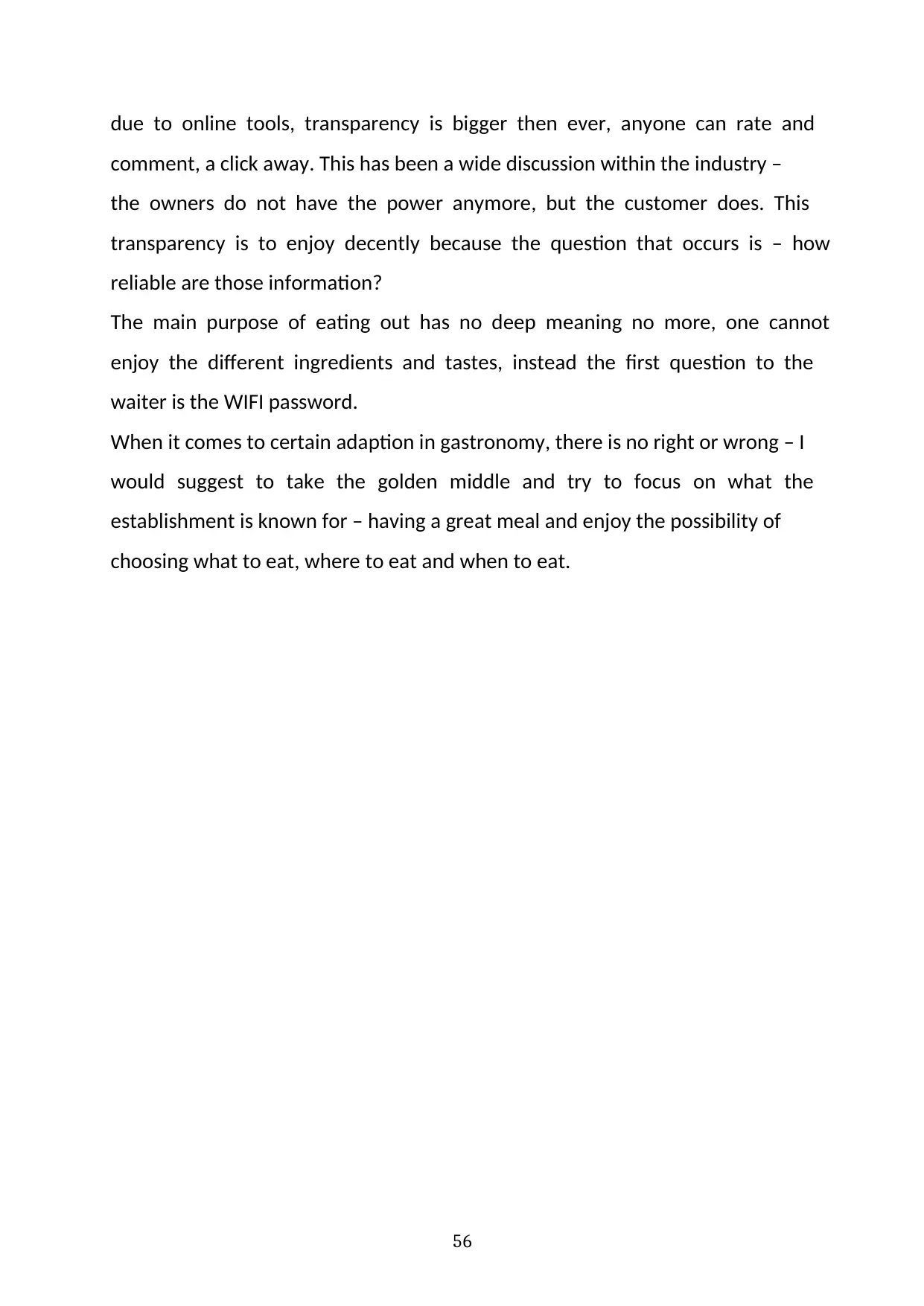
56
due to online tools, transparency is bigger then ever, anyone can rate and
comment, a click away. This has been a wide discussion within the industry –
the owners do not have the power anymore, but the customer does. This
transparency is to enjoy decently because the question that occurs is – how
reliable are those information?
The main purpose of eating out has no deep meaning no more, one cannot
enjoy the different ingredients and tastes, instead the first question to the
waiter is the WIFI password.
When it comes to certain adaption in gastronomy, there is no right or wrong – I
would suggest to take the golden middle and try to focus on what the
establishment is known for – having a great meal and enjoy the possibility of
choosing what to eat, where to eat and when to eat.
due to online tools, transparency is bigger then ever, anyone can rate and
comment, a click away. This has been a wide discussion within the industry –
the owners do not have the power anymore, but the customer does. This
transparency is to enjoy decently because the question that occurs is – how
reliable are those information?
The main purpose of eating out has no deep meaning no more, one cannot
enjoy the different ingredients and tastes, instead the first question to the
waiter is the WIFI password.
When it comes to certain adaption in gastronomy, there is no right or wrong – I
would suggest to take the golden middle and try to focus on what the
establishment is known for – having a great meal and enjoy the possibility of
choosing what to eat, where to eat and when to eat.

57
With new generations coming up, being raised up in a completely different
surrounding with a variety of possibilities it was only a matter of time to
“invent” gastronomy new, or more precisely, to perceive it differently then
previous generations. One can argue that there has always been street food
market around the world, and burgers aren’t a new invention as well, but the
marketing strategies are. As we are yearning to live simpler and with more
awareness, people started going back in time to rediscover what they have
forgotten during time. Street food markets are one of them. Although they
initially were appealing to the lower class, today, it has become a place where
you will find great food – most probably burgers – at a very high price, but
people are willing to pay this price because it has become part of their lifestyle.
The problem occurs, when it transform into mass products, and it upsets
restaurateurs, understandably, considering the fact, that restaurateurs pay a
Question 6 Burgers, Pop ups and
Street food – what comes
to your mind?
Haya Molcho Too many burgers! Why?
Bernhard Schlacher Today you find your Burger in
street food markets. What is
local about a Burger in
Vienna?
Andrea Vaz - König‐ I prefer the healthy nutrition;
Pop ups are very interesting
concepts
Alexander Längauer Burgers: simple product –
great impact
Daniela Terbu Vienna Food Week – check it
out!
Leopold Mlynek Junior I do sell Burgers as well
because the demand was so
high.
With new generations coming up, being raised up in a completely different
surrounding with a variety of possibilities it was only a matter of time to
“invent” gastronomy new, or more precisely, to perceive it differently then
previous generations. One can argue that there has always been street food
market around the world, and burgers aren’t a new invention as well, but the
marketing strategies are. As we are yearning to live simpler and with more
awareness, people started going back in time to rediscover what they have
forgotten during time. Street food markets are one of them. Although they
initially were appealing to the lower class, today, it has become a place where
you will find great food – most probably burgers – at a very high price, but
people are willing to pay this price because it has become part of their lifestyle.
The problem occurs, when it transform into mass products, and it upsets
restaurateurs, understandably, considering the fact, that restaurateurs pay a
Question 6 Burgers, Pop ups and
Street food – what comes
to your mind?
Haya Molcho Too many burgers! Why?
Bernhard Schlacher Today you find your Burger in
street food markets. What is
local about a Burger in
Vienna?
Andrea Vaz - König‐ I prefer the healthy nutrition;
Pop ups are very interesting
concepts
Alexander Längauer Burgers: simple product –
great impact
Daniela Terbu Vienna Food Week – check it
out!
Leopold Mlynek Junior I do sell Burgers as well
because the demand was so
high.
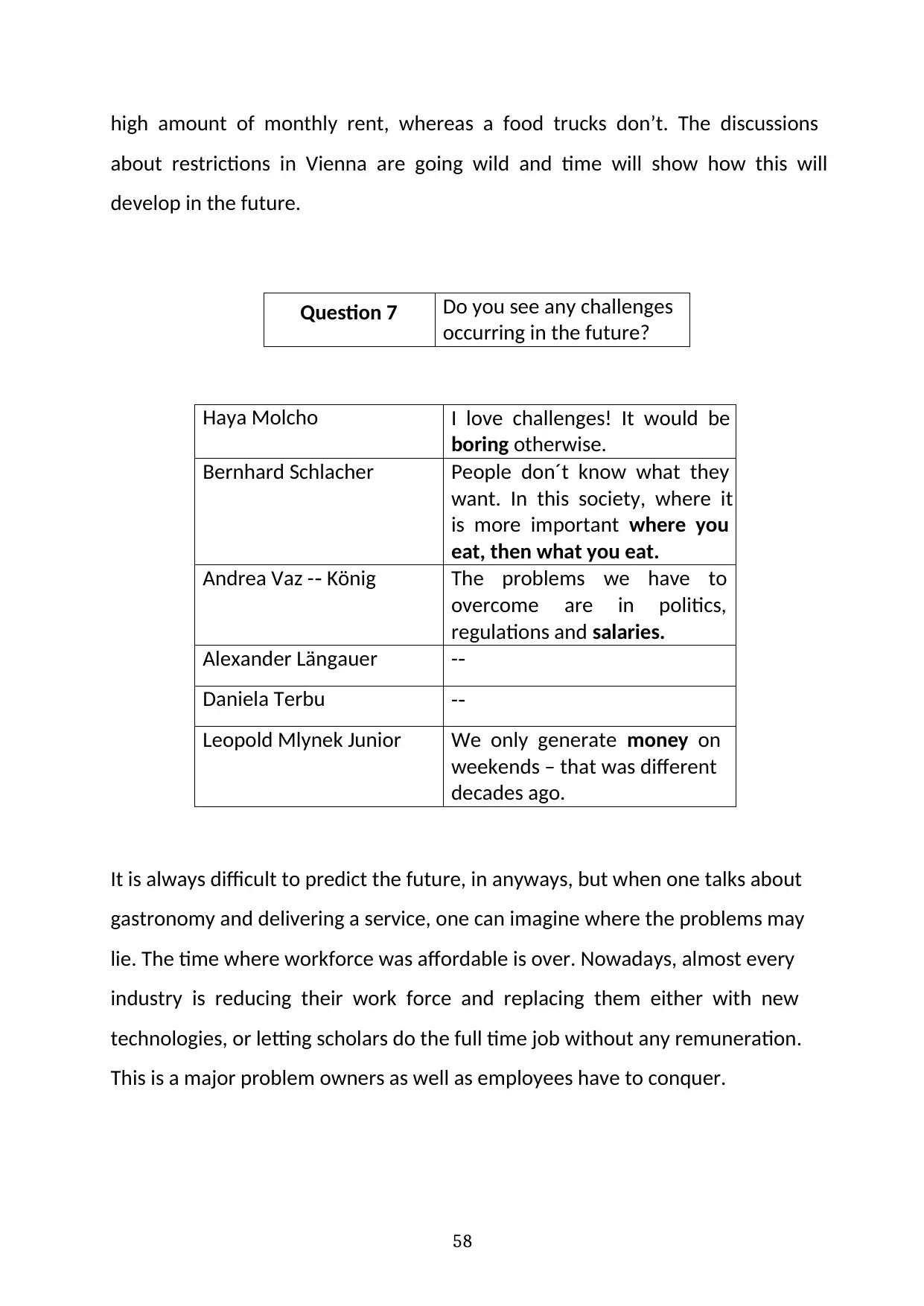
58
high amount of monthly rent, whereas a food trucks don’t. The discussions
about restrictions in Vienna are going wild and time will show how this will
develop in the future.
It is always difficult to predict the future, in anyways, but when one talks about
gastronomy and delivering a service, one can imagine where the problems may
lie. The time where workforce was affordable is over. Nowadays, almost every
industry is reducing their work force and replacing them either with new
technologies, or letting scholars do the full time job without any remuneration.
This is a major problem owners as well as employees have to conquer.
Question 7 Do you see any challenges
occurring in the future?
Haya Molcho I love challenges! It would be
boring otherwise.
Bernhard Schlacher People don´t know what they
want. In this society, where it
is more important where you
eat, then what you eat.
Andrea Vaz - König‐ The problems we have to
overcome are in politics,
regulations and salaries.
Alexander Längauer -‐
Daniela Terbu -‐
Leopold Mlynek Junior We only generate money on
weekends – that was different
decades ago.
high amount of monthly rent, whereas a food trucks don’t. The discussions
about restrictions in Vienna are going wild and time will show how this will
develop in the future.
It is always difficult to predict the future, in anyways, but when one talks about
gastronomy and delivering a service, one can imagine where the problems may
lie. The time where workforce was affordable is over. Nowadays, almost every
industry is reducing their work force and replacing them either with new
technologies, or letting scholars do the full time job without any remuneration.
This is a major problem owners as well as employees have to conquer.
Question 7 Do you see any challenges
occurring in the future?
Haya Molcho I love challenges! It would be
boring otherwise.
Bernhard Schlacher People don´t know what they
want. In this society, where it
is more important where you
eat, then what you eat.
Andrea Vaz - König‐ The problems we have to
overcome are in politics,
regulations and salaries.
Alexander Längauer -‐
Daniela Terbu -‐
Leopold Mlynek Junior We only generate money on
weekends – that was different
decades ago.
Secure Best Marks with AI Grader
Need help grading? Try our AI Grader for instant feedback on your assignments.
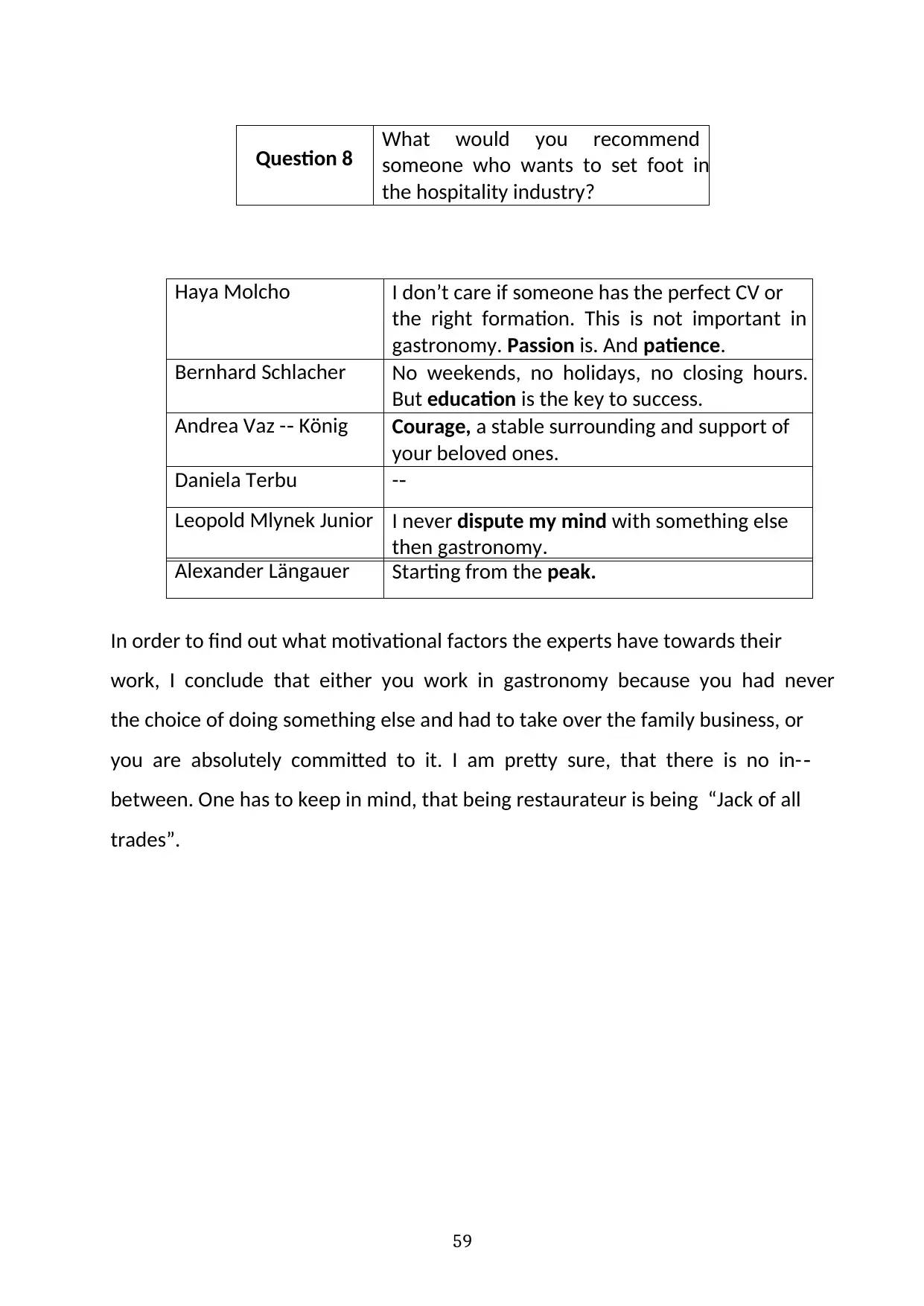
59
In order to find out what motivational factors the experts have towards their
work, I conclude that either you work in gastronomy because you had never
the choice of doing something else and had to take over the family business, or
you are absolutely committed to it. I am pretty sure, that there is no in- ‐
between. One has to keep in mind, that being restaurateur is being “Jack of all
trades”.
Question 8 What would you recommend
someone who wants to set foot in
the hospitality industry?
Haya Molcho I don’t care if someone has the perfect CV or
the right formation. This is not important in
gastronomy. Passion is. And patience.
Bernhard Schlacher No weekends, no holidays, no closing hours.
But education is the key to success.
Andrea Vaz - König‐ Courage, a stable surrounding and support of
your beloved ones.
Daniela Terbu -‐
Leopold Mlynek Junior I never dispute my mind with something else
then gastronomy.
Alexander Längauer Starting from the peak.
In order to find out what motivational factors the experts have towards their
work, I conclude that either you work in gastronomy because you had never
the choice of doing something else and had to take over the family business, or
you are absolutely committed to it. I am pretty sure, that there is no in- ‐
between. One has to keep in mind, that being restaurateur is being “Jack of all
trades”.
Question 8 What would you recommend
someone who wants to set foot in
the hospitality industry?
Haya Molcho I don’t care if someone has the perfect CV or
the right formation. This is not important in
gastronomy. Passion is. And patience.
Bernhard Schlacher No weekends, no holidays, no closing hours.
But education is the key to success.
Andrea Vaz - König‐ Courage, a stable surrounding and support of
your beloved ones.
Daniela Terbu -‐
Leopold Mlynek Junior I never dispute my mind with something else
then gastronomy.
Alexander Längauer Starting from the peak.
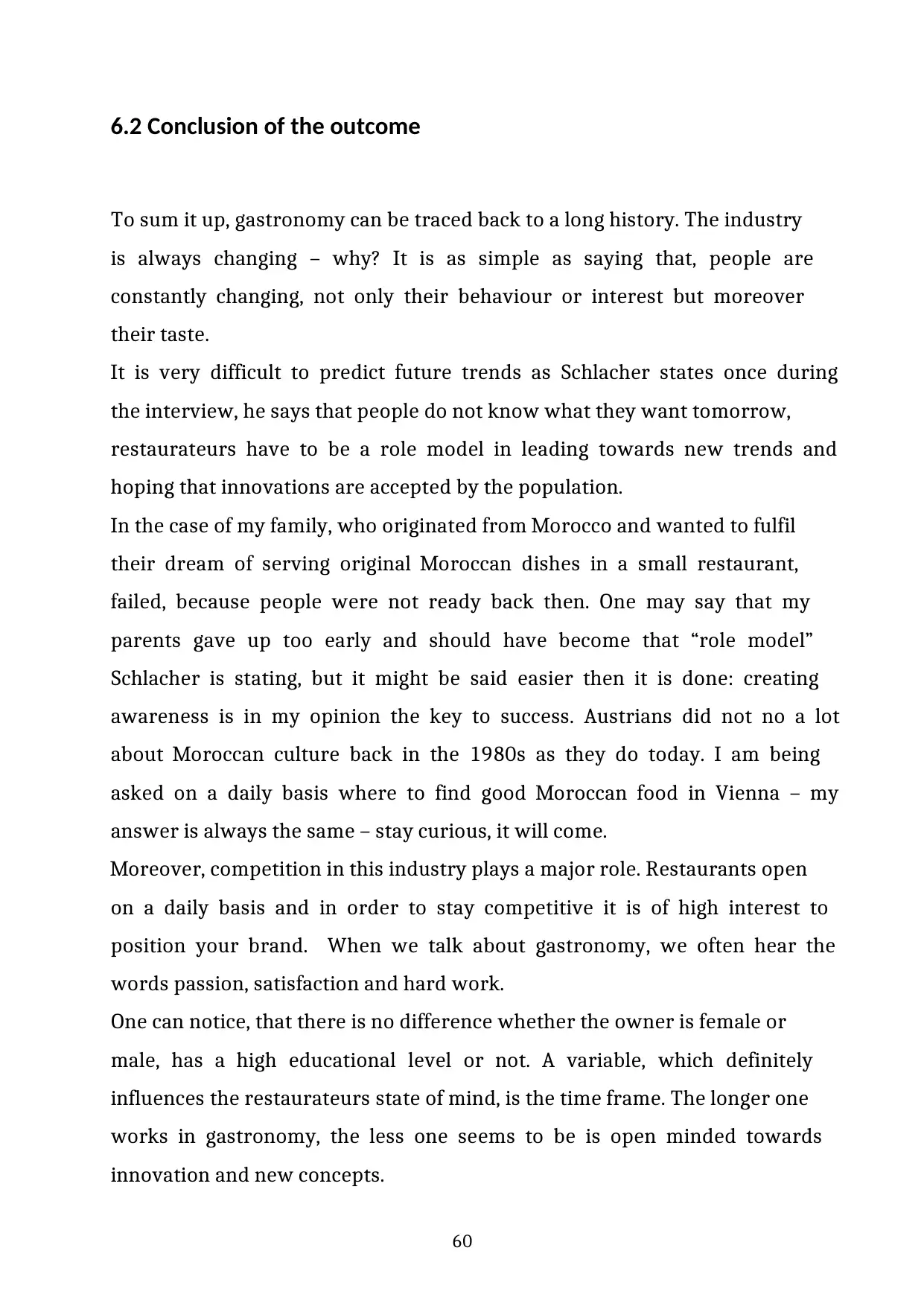
60
6.2 Conclusion of the outcome
To sum it up, gastronomy can be traced back to a long history. The industry
is always changing – why? It is as simple as saying that, people are
constantly changing, not only their behaviour or interest but moreover
their taste.
It is very difficult to predict future trends as Schlacher states once during
the interview, he says that people do not know what they want tomorrow,
restaurateurs have to be a role model in leading towards new trends and
hoping that innovations are accepted by the population.
In the case of my family, who originated from Morocco and wanted to fulfil
their dream of serving original Moroccan dishes in a small restaurant,
failed, because people were not ready back then. One may say that my
parents gave up too early and should have become that “role model”
Schlacher is stating, but it might be said easier then it is done: creating
awareness is in my opinion the key to success. Austrians did not no a lot
about Moroccan culture back in the 1980s as they do today. I am being
asked on a daily basis where to find good Moroccan food in Vienna – my
answer is always the same – stay curious, it will come.
Moreover, competition in this industry plays a major role. Restaurants open
on a daily basis and in order to stay competitive it is of high interest to
position your brand. When we talk about gastronomy, we often hear the
words passion, satisfaction and hard work.
One can notice, that there is no difference whether the owner is female or
male, has a high educational level or not. A variable, which definitely
influences the restaurateurs state of mind, is the time frame. The longer one
works in gastronomy, the less one seems to be is open minded towards
innovation and new concepts.
6.2 Conclusion of the outcome
To sum it up, gastronomy can be traced back to a long history. The industry
is always changing – why? It is as simple as saying that, people are
constantly changing, not only their behaviour or interest but moreover
their taste.
It is very difficult to predict future trends as Schlacher states once during
the interview, he says that people do not know what they want tomorrow,
restaurateurs have to be a role model in leading towards new trends and
hoping that innovations are accepted by the population.
In the case of my family, who originated from Morocco and wanted to fulfil
their dream of serving original Moroccan dishes in a small restaurant,
failed, because people were not ready back then. One may say that my
parents gave up too early and should have become that “role model”
Schlacher is stating, but it might be said easier then it is done: creating
awareness is in my opinion the key to success. Austrians did not no a lot
about Moroccan culture back in the 1980s as they do today. I am being
asked on a daily basis where to find good Moroccan food in Vienna – my
answer is always the same – stay curious, it will come.
Moreover, competition in this industry plays a major role. Restaurants open
on a daily basis and in order to stay competitive it is of high interest to
position your brand. When we talk about gastronomy, we often hear the
words passion, satisfaction and hard work.
One can notice, that there is no difference whether the owner is female or
male, has a high educational level or not. A variable, which definitely
influences the restaurateurs state of mind, is the time frame. The longer one
works in gastronomy, the less one seems to be is open minded towards
innovation and new concepts.
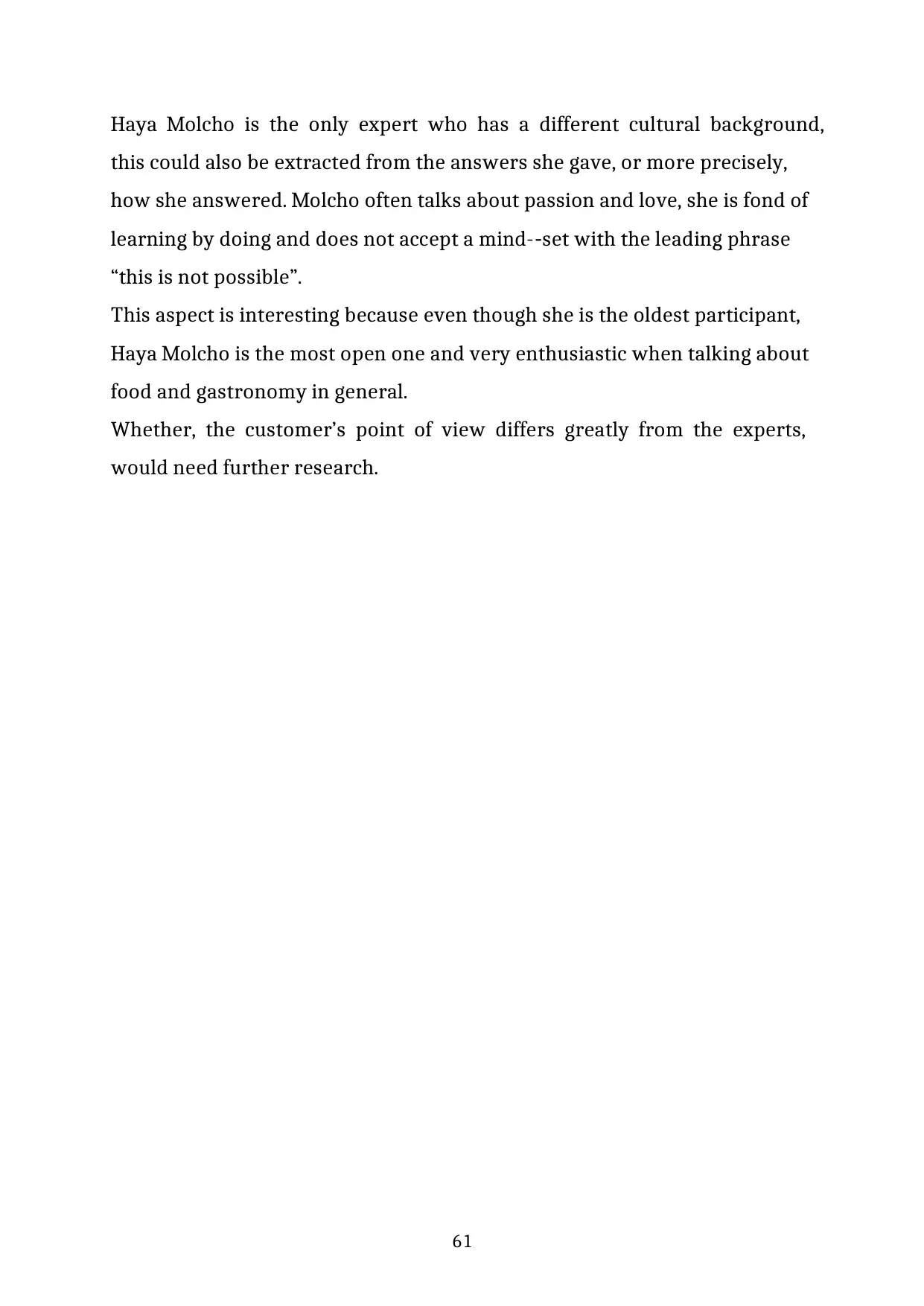
61
Haya Molcho is the only expert who has a different cultural background,
this could also be extracted from the answers she gave, or more precisely,
how she answered. Molcho often talks about passion and love, she is fond of
learning by doing and does not accept a mind- set with the leading phrase‐
“this is not possible”.
This aspect is interesting because even though she is the oldest participant,
Haya Molcho is the most open one and very enthusiastic when talking about
food and gastronomy in general.
Whether, the customer’s point of view differs greatly from the experts,
would need further research.
Haya Molcho is the only expert who has a different cultural background,
this could also be extracted from the answers she gave, or more precisely,
how she answered. Molcho often talks about passion and love, she is fond of
learning by doing and does not accept a mind- set with the leading phrase‐
“this is not possible”.
This aspect is interesting because even though she is the oldest participant,
Haya Molcho is the most open one and very enthusiastic when talking about
food and gastronomy in general.
Whether, the customer’s point of view differs greatly from the experts,
would need further research.
Paraphrase This Document
Need a fresh take? Get an instant paraphrase of this document with our AI Paraphraser
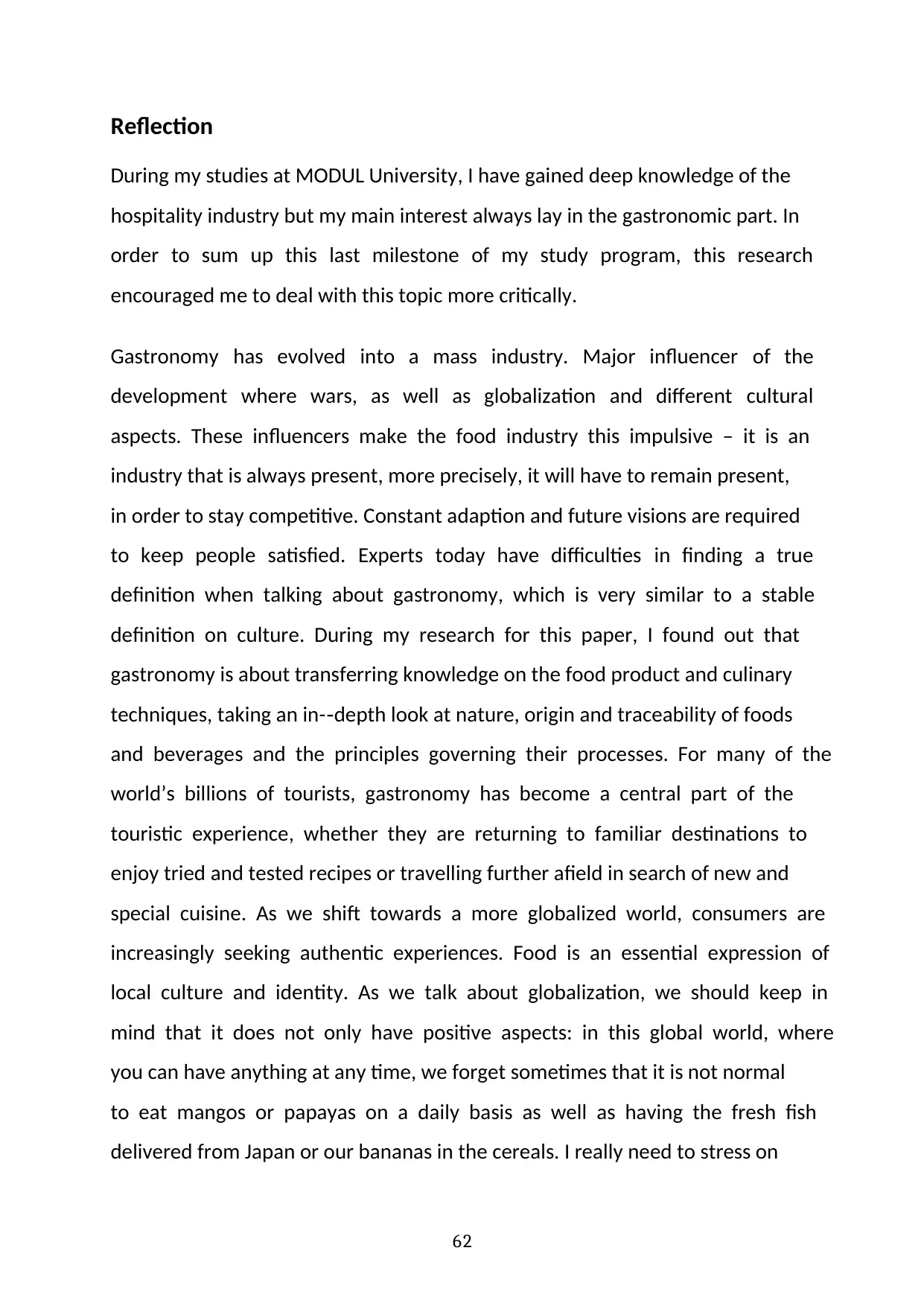
62
Reflection
During my studies at MODUL University, I have gained deep knowledge of the
hospitality industry but my main interest always lay in the gastronomic part. In
order to sum up this last milestone of my study program, this research
encouraged me to deal with this topic more critically.
Gastronomy has evolved into a mass industry. Major influencer of the
development where wars, as well as globalization and different cultural
aspects. These influencers make the food industry this impulsive – it is an
industry that is always present, more precisely, it will have to remain present,
in order to stay competitive. Constant adaption and future visions are required
to keep people satisfied. Experts today have difficulties in finding a true
definition when talking about gastronomy, which is very similar to a stable
definition on culture. During my research for this paper, I found out that
gastronomy is about transferring knowledge on the food product and culinary
techniques, taking an in- depth look at nature, origin and traceability of foods‐
and beverages and the principles governing their processes. For many of the
world’s billions of tourists, gastronomy has become a central part of the
touristic experience, whether they are returning to familiar destinations to
enjoy tried and tested recipes or travelling further afield in search of new and
special cuisine. As we shift towards a more globalized world, consumers are
increasingly seeking authentic experiences. Food is an essential expression of
local culture and identity. As we talk about globalization, we should keep in
mind that it does not only have positive aspects: in this global world, where
you can have anything at any time, we forget sometimes that it is not normal
to eat mangos or papayas on a daily basis as well as having the fresh fish
delivered from Japan or our bananas in the cereals. I really need to stress on
Reflection
During my studies at MODUL University, I have gained deep knowledge of the
hospitality industry but my main interest always lay in the gastronomic part. In
order to sum up this last milestone of my study program, this research
encouraged me to deal with this topic more critically.
Gastronomy has evolved into a mass industry. Major influencer of the
development where wars, as well as globalization and different cultural
aspects. These influencers make the food industry this impulsive – it is an
industry that is always present, more precisely, it will have to remain present,
in order to stay competitive. Constant adaption and future visions are required
to keep people satisfied. Experts today have difficulties in finding a true
definition when talking about gastronomy, which is very similar to a stable
definition on culture. During my research for this paper, I found out that
gastronomy is about transferring knowledge on the food product and culinary
techniques, taking an in- depth look at nature, origin and traceability of foods‐
and beverages and the principles governing their processes. For many of the
world’s billions of tourists, gastronomy has become a central part of the
touristic experience, whether they are returning to familiar destinations to
enjoy tried and tested recipes or travelling further afield in search of new and
special cuisine. As we shift towards a more globalized world, consumers are
increasingly seeking authentic experiences. Food is an essential expression of
local culture and identity. As we talk about globalization, we should keep in
mind that it does not only have positive aspects: in this global world, where
you can have anything at any time, we forget sometimes that it is not normal
to eat mangos or papayas on a daily basis as well as having the fresh fish
delivered from Japan or our bananas in the cereals. I really need to stress on
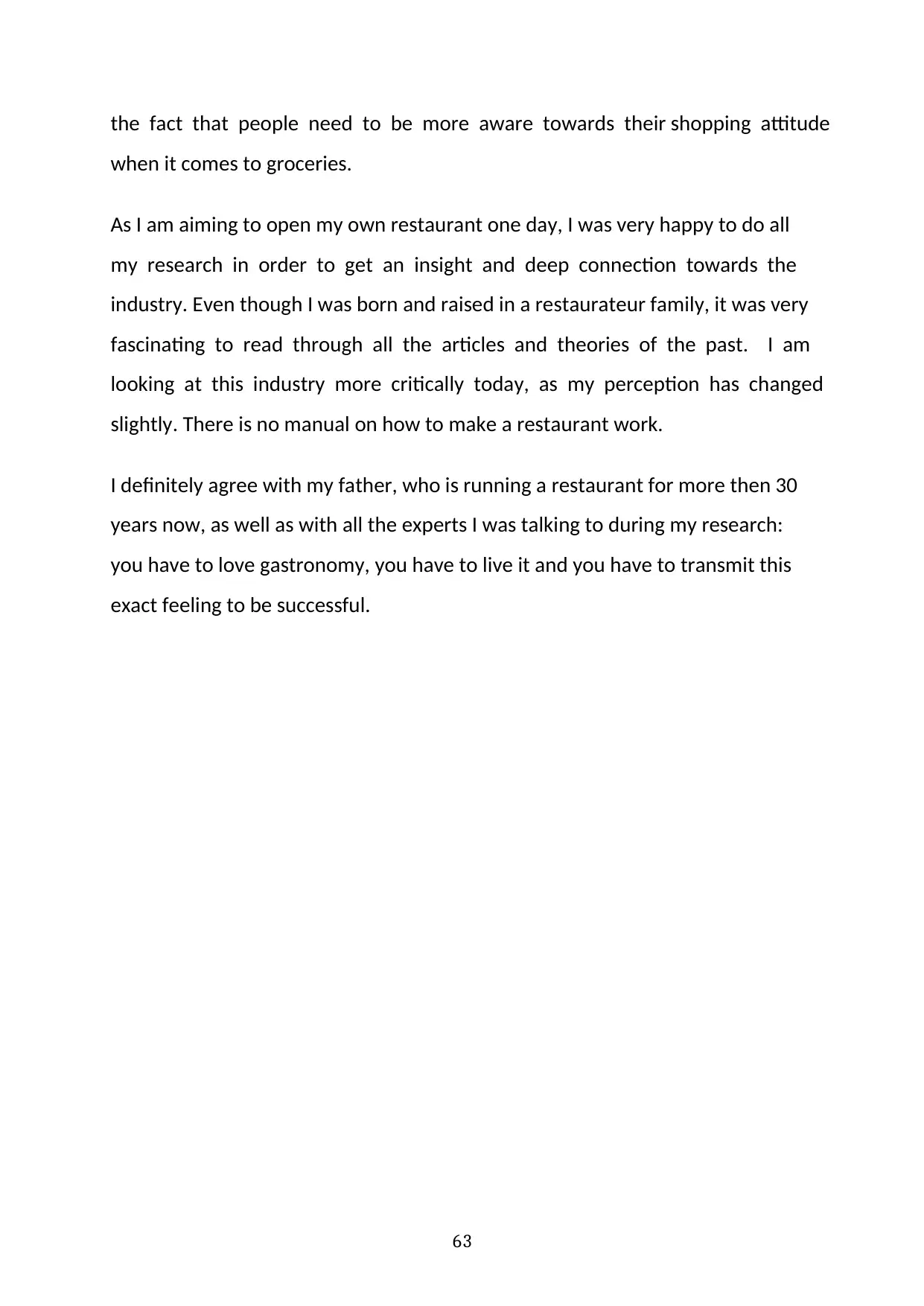
63
the fact that people need to be more aware towards their shopping attitude
when it comes to groceries.
As I am aiming to open my own restaurant one day, I was very happy to do all
my research in order to get an insight and deep connection towards the
industry. Even though I was born and raised in a restaurateur family, it was very
fascinating to read through all the articles and theories of the past. I am
looking at this industry more critically today, as my perception has changed
slightly. There is no manual on how to make a restaurant work.
I definitely agree with my father, who is running a restaurant for more then 30
years now, as well as with all the experts I was talking to during my research:
you have to love gastronomy, you have to live it and you have to transmit this
exact feeling to be successful.
the fact that people need to be more aware towards their shopping attitude
when it comes to groceries.
As I am aiming to open my own restaurant one day, I was very happy to do all
my research in order to get an insight and deep connection towards the
industry. Even though I was born and raised in a restaurateur family, it was very
fascinating to read through all the articles and theories of the past. I am
looking at this industry more critically today, as my perception has changed
slightly. There is no manual on how to make a restaurant work.
I definitely agree with my father, who is running a restaurant for more then 30
years now, as well as with all the experts I was talking to during my research:
you have to love gastronomy, you have to live it and you have to transmit this
exact feeling to be successful.
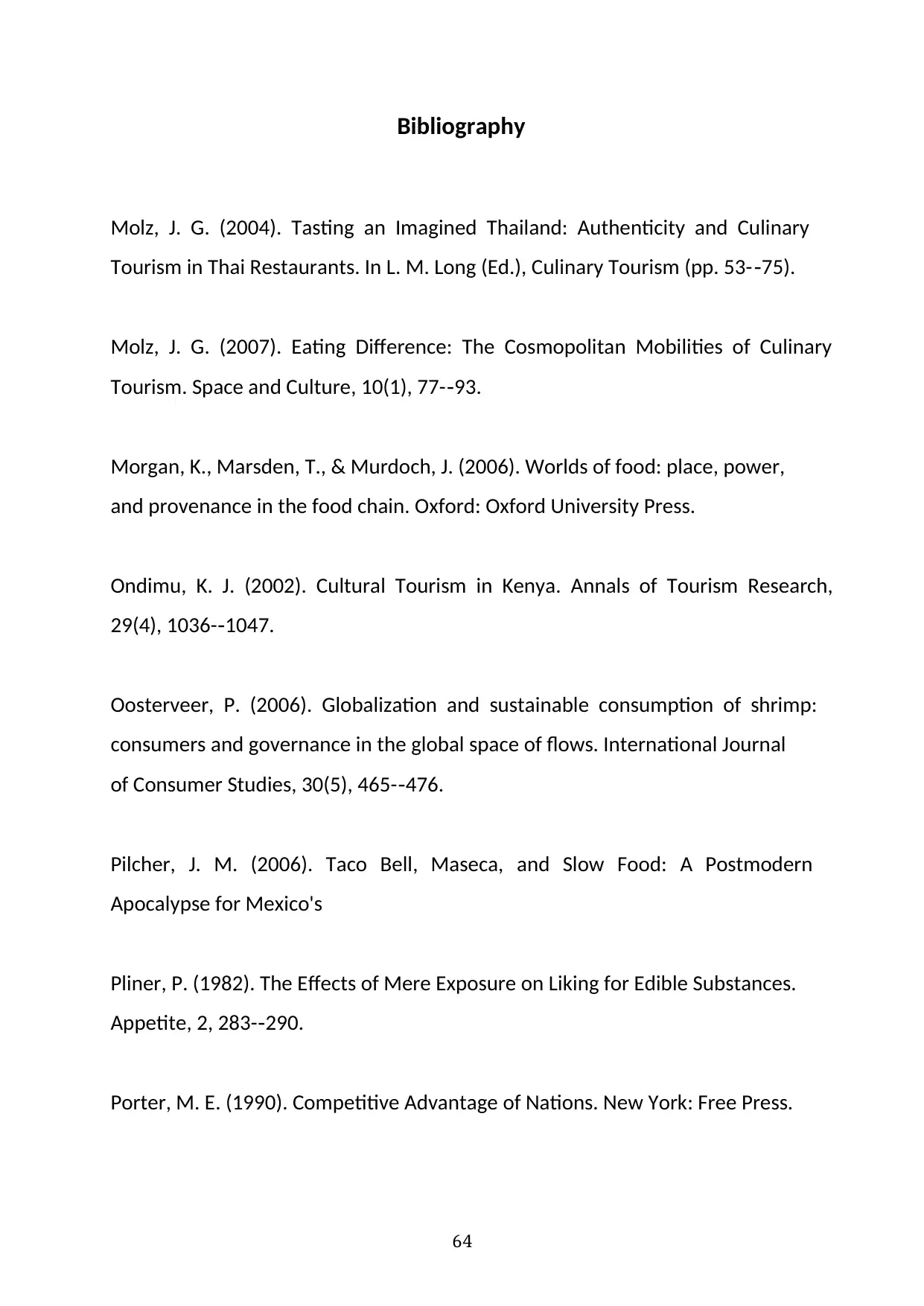
64
Bibliography
Molz, J. G. (2004). Tasting an Imagined Thailand: Authenticity and Culinary
Tourism in Thai Restaurants. In L. M. Long (Ed.), Culinary Tourism (pp. 53- 75).‐
Molz, J. G. (2007). Eating Difference: The Cosmopolitan Mobilities of Culinary
Tourism. Space and Culture, 10(1), 77- 93.‐
Morgan, K., Marsden, T., & Murdoch, J. (2006). Worlds of food: place, power,
and provenance in the food chain. Oxford: Oxford University Press.
Ondimu, K. J. (2002). Cultural Tourism in Kenya. Annals of Tourism Research,
29(4), 1036- 1047.‐
Oosterveer, P. (2006). Globalization and sustainable consumption of shrimp:
consumers and governance in the global space of flows. International Journal
of Consumer Studies, 30(5), 465- 476.‐
Pilcher, J. M. (2006). Taco Bell, Maseca, and Slow Food: A Postmodern
Apocalypse for Mexico's
Pliner, P. (1982). The Effects of Mere Exposure on Liking for Edible Substances.
Appetite, 2, 283- 290.‐
Porter, M. E. (1990). Competitive Advantage of Nations. New York: Free Press.
Bibliography
Molz, J. G. (2004). Tasting an Imagined Thailand: Authenticity and Culinary
Tourism in Thai Restaurants. In L. M. Long (Ed.), Culinary Tourism (pp. 53- 75).‐
Molz, J. G. (2007). Eating Difference: The Cosmopolitan Mobilities of Culinary
Tourism. Space and Culture, 10(1), 77- 93.‐
Morgan, K., Marsden, T., & Murdoch, J. (2006). Worlds of food: place, power,
and provenance in the food chain. Oxford: Oxford University Press.
Ondimu, K. J. (2002). Cultural Tourism in Kenya. Annals of Tourism Research,
29(4), 1036- 1047.‐
Oosterveer, P. (2006). Globalization and sustainable consumption of shrimp:
consumers and governance in the global space of flows. International Journal
of Consumer Studies, 30(5), 465- 476.‐
Pilcher, J. M. (2006). Taco Bell, Maseca, and Slow Food: A Postmodern
Apocalypse for Mexico's
Pliner, P. (1982). The Effects of Mere Exposure on Liking for Edible Substances.
Appetite, 2, 283- 290.‐
Porter, M. E. (1990). Competitive Advantage of Nations. New York: Free Press.
Secure Best Marks with AI Grader
Need help grading? Try our AI Grader for instant feedback on your assignments.
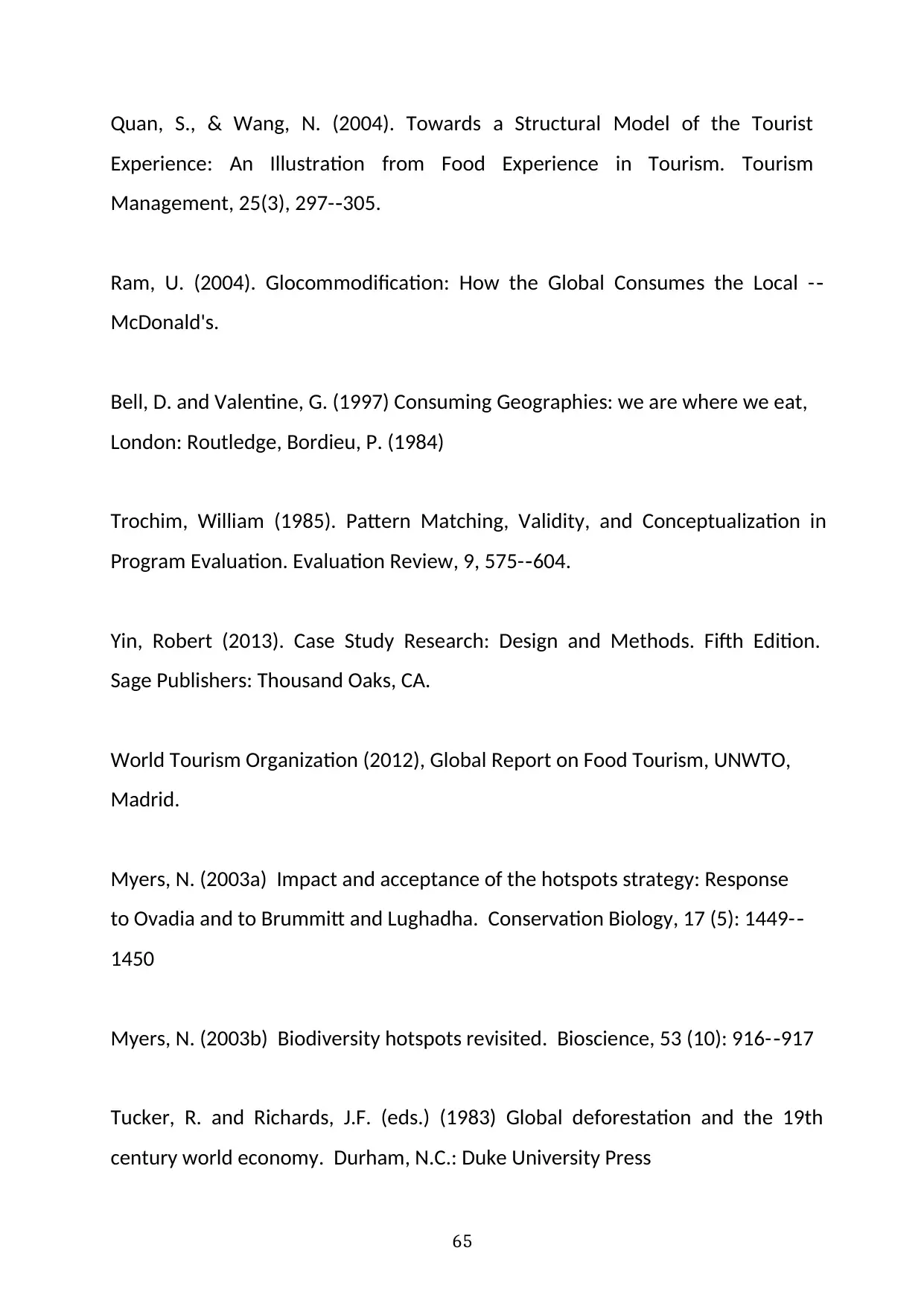
65
Quan, S., & Wang, N. (2004). Towards a Structural Model of the Tourist
Experience: An Illustration from Food Experience in Tourism. Tourism
Management, 25(3), 297- 305.‐
Ram, U. (2004). Glocommodification: How the Global Consumes the Local -‐
McDonald's.
Bell, D. and Valentine, G. (1997) Consuming Geographies: we are where we eat,
London: Routledge, Bordieu, P. (1984)
Trochim, William (1985). Pattern Matching, Validity, and Conceptualization in
Program Evaluation. Evaluation Review, 9, 575- 604.‐
Yin, Robert (2013). Case Study Research: Design and Methods. Fifth Edition.
Sage Publishers: Thousand Oaks, CA.
World Tourism Organization (2012), Global Report on Food Tourism, UNWTO,
Madrid.
Myers, N. (2003a) Impact and acceptance of the hotspots strategy: Response
to Ovadia and to Brummitt and Lughadha. Conservation Biology, 17 (5): 1449- ‐
1450
Myers, N. (2003b) Biodiversity hotspots revisited. Bioscience, 53 (10): 916- 917‐
Tucker, R. and Richards, J.F. (eds.) (1983) Global deforestation and the 19th
century world economy. Durham, N.C.: Duke University Press
Quan, S., & Wang, N. (2004). Towards a Structural Model of the Tourist
Experience: An Illustration from Food Experience in Tourism. Tourism
Management, 25(3), 297- 305.‐
Ram, U. (2004). Glocommodification: How the Global Consumes the Local -‐
McDonald's.
Bell, D. and Valentine, G. (1997) Consuming Geographies: we are where we eat,
London: Routledge, Bordieu, P. (1984)
Trochim, William (1985). Pattern Matching, Validity, and Conceptualization in
Program Evaluation. Evaluation Review, 9, 575- 604.‐
Yin, Robert (2013). Case Study Research: Design and Methods. Fifth Edition.
Sage Publishers: Thousand Oaks, CA.
World Tourism Organization (2012), Global Report on Food Tourism, UNWTO,
Madrid.
Myers, N. (2003a) Impact and acceptance of the hotspots strategy: Response
to Ovadia and to Brummitt and Lughadha. Conservation Biology, 17 (5): 1449- ‐
1450
Myers, N. (2003b) Biodiversity hotspots revisited. Bioscience, 53 (10): 916- 917‐
Tucker, R. and Richards, J.F. (eds.) (1983) Global deforestation and the 19th
century world economy. Durham, N.C.: Duke University Press

66
Bartlett C.A. and Ghoshal S., 2002. Managing Across Borders: The Transnational
Solution. Harvard Business School Press: Boston.
Bateman, T.S. and Snell, S., 1996. Management: Building Competitive
Advantage. 3rd ed. Irwin Professional: Chicago.
Baumol, W.J., 2002a. Towards Microeconomics of Innovation: Growth Engine
Hallmark of Market Economics. Atlantic Economic Journal: Dordrecht.
Baumol, W.J., 2002b. The Free- Market‐ Innovation Machine: Analyzing the
Growth Miracle of Capitalism. Princeton University Press: Princeton.
Bertalanffy, L.v., 2008. General System Theory. George Braziller: New York.
Formica, P., 2007. Innovation: Knowledge Models and Tools. University of Tartu
– Centre for Entrepreneurship: Tartu.
Greg Richards, Gastronomy as a source of regional identity and tourism
development, 2001
Useem, J., & Useem, R., 1963 - Human Organizations, 22(3)‐
Dell Hymes, 1969 - Reinventing Anthropology.‐
Ralph L. Holloway Jr. ,1969 - Culture: A Human domain.‐
Michael Tomasello, 1999 - The Human Adaptation for Culture.‐
Bartlett C.A. and Ghoshal S., 2002. Managing Across Borders: The Transnational
Solution. Harvard Business School Press: Boston.
Bateman, T.S. and Snell, S., 1996. Management: Building Competitive
Advantage. 3rd ed. Irwin Professional: Chicago.
Baumol, W.J., 2002a. Towards Microeconomics of Innovation: Growth Engine
Hallmark of Market Economics. Atlantic Economic Journal: Dordrecht.
Baumol, W.J., 2002b. The Free- Market‐ Innovation Machine: Analyzing the
Growth Miracle of Capitalism. Princeton University Press: Princeton.
Bertalanffy, L.v., 2008. General System Theory. George Braziller: New York.
Formica, P., 2007. Innovation: Knowledge Models and Tools. University of Tartu
– Centre for Entrepreneurship: Tartu.
Greg Richards, Gastronomy as a source of regional identity and tourism
development, 2001
Useem, J., & Useem, R., 1963 - Human Organizations, 22(3)‐
Dell Hymes, 1969 - Reinventing Anthropology.‐
Ralph L. Holloway Jr. ,1969 - Culture: A Human domain.‐
Michael Tomasello, 1999 - The Human Adaptation for Culture.‐
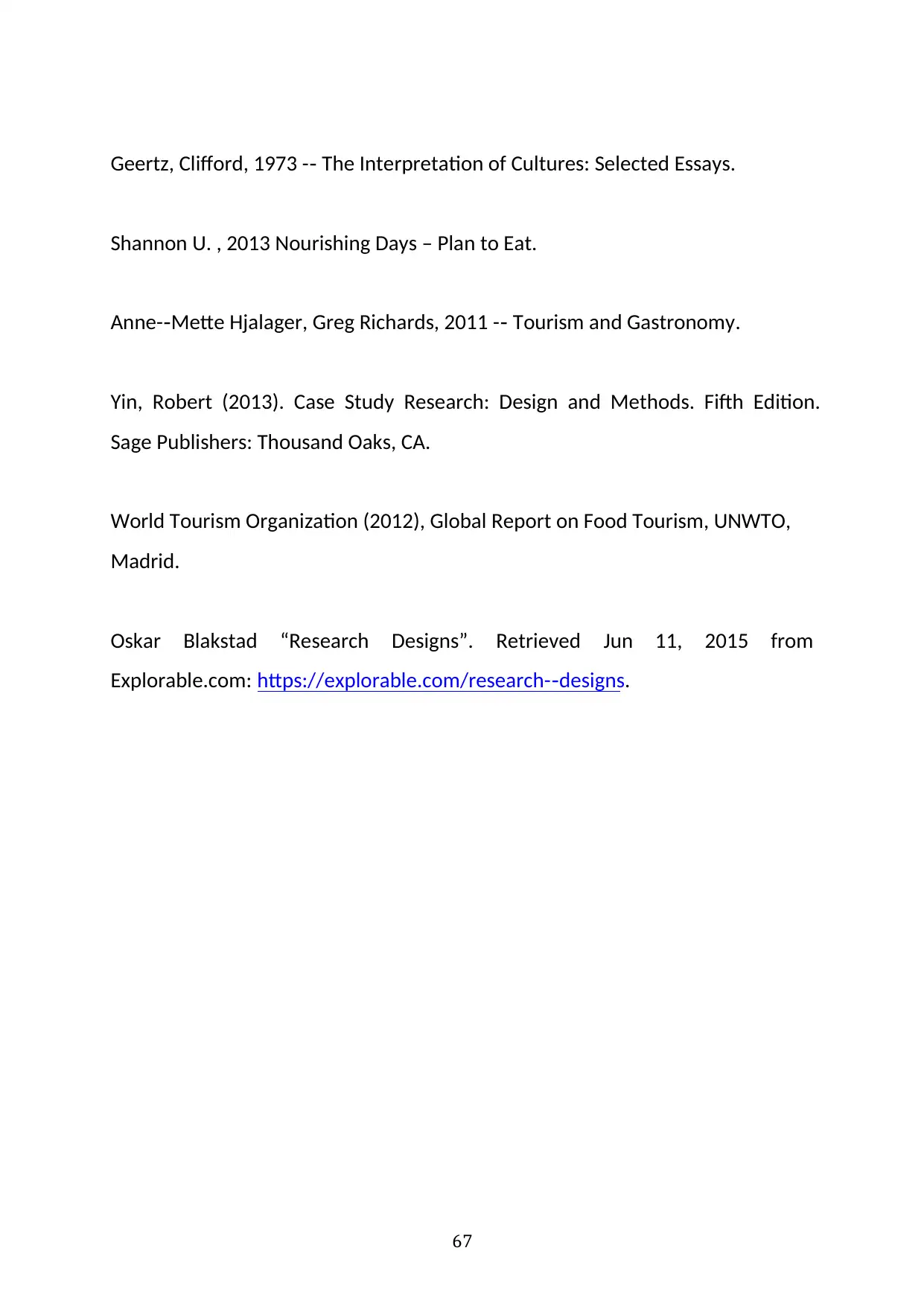
67
Geertz, Clifford, 1973 - The Interpretation of Cultures: Selected Essays.‐
Shannon U. , 2013 Nourishing Days – Plan to Eat.
Anne- Mette Hjalager, Greg Richards, 2011 - Tourism and Gastronomy.‐ ‐
Yin, Robert (2013). Case Study Research: Design and Methods. Fifth Edition.
Sage Publishers: Thousand Oaks, CA.
World Tourism Organization (2012), Global Report on Food Tourism, UNWTO,
Madrid.
Oskar Blakstad “Research Designs”. Retrieved Jun 11, 2015 from
Explorable.com: https://explorable.com/research- designs‐ .
Geertz, Clifford, 1973 - The Interpretation of Cultures: Selected Essays.‐
Shannon U. , 2013 Nourishing Days – Plan to Eat.
Anne- Mette Hjalager, Greg Richards, 2011 - Tourism and Gastronomy.‐ ‐
Yin, Robert (2013). Case Study Research: Design and Methods. Fifth Edition.
Sage Publishers: Thousand Oaks, CA.
World Tourism Organization (2012), Global Report on Food Tourism, UNWTO,
Madrid.
Oskar Blakstad “Research Designs”. Retrieved Jun 11, 2015 from
Explorable.com: https://explorable.com/research- designs‐ .
Paraphrase This Document
Need a fresh take? Get an instant paraphrase of this document with our AI Paraphraser
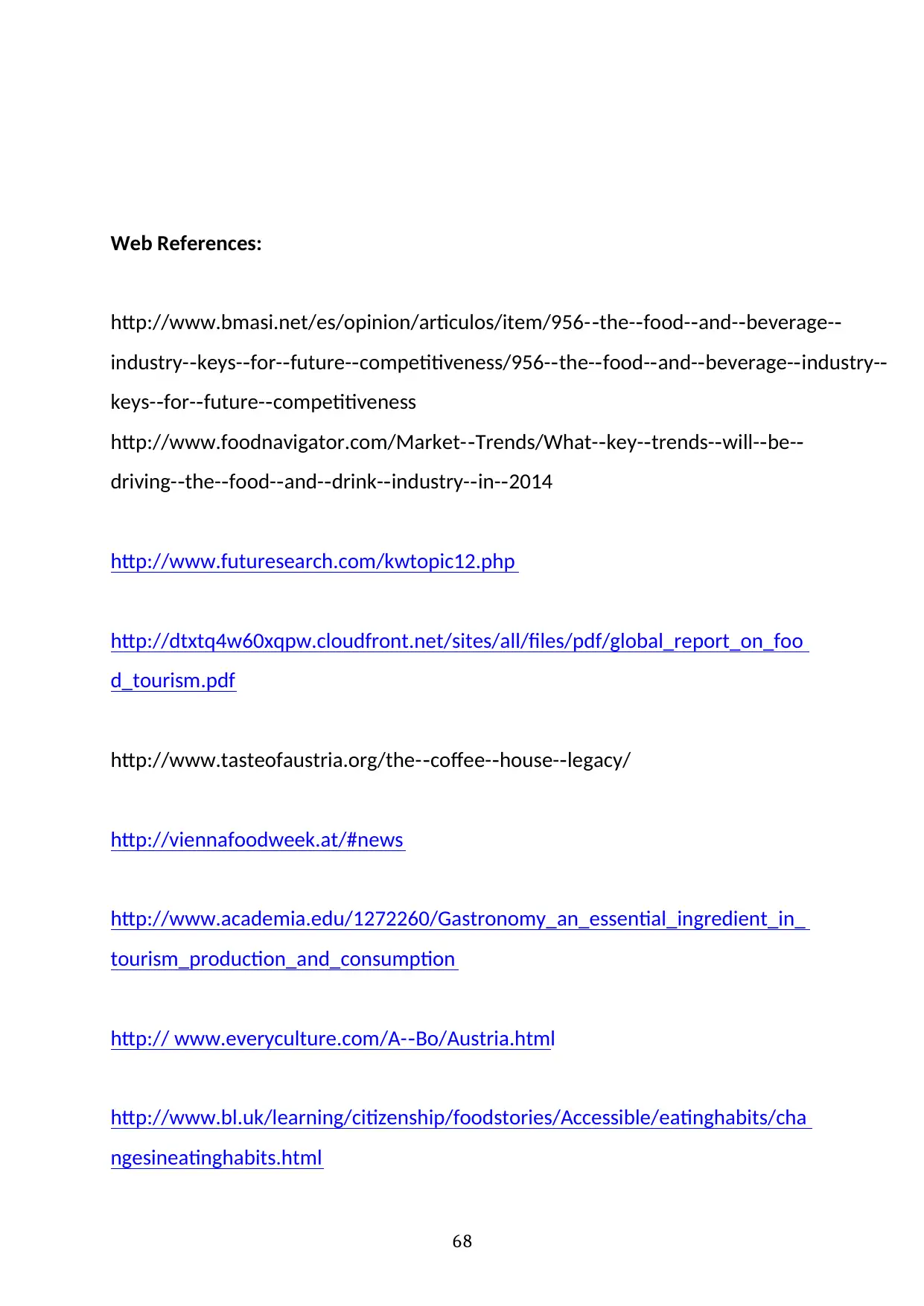
68
Web References:
http://www.bmasi.net/es/opinion/articulos/item/956- the- food- and- beverage-‐ ‐ ‐ ‐ ‐
industry- keys- for- future- competitiveness/956- the- food- and- beverage- industry-‐ ‐ ‐ ‐ ‐ ‐ ‐ ‐ ‐ ‐
keys- for- future- competitiveness‐ ‐ ‐
http://www.foodnavigator.com/Market- Trends/What- key- trends- will- be-‐ ‐ ‐ ‐ ‐ ‐
driving- the- food- and- drink- industry- in- 2014‐ ‐ ‐ ‐ ‐ ‐ ‐
http://www.futuresearch.com/kwtopic12.php
http://dtxtq4w60xqpw.cloudfront.net/sites/all/files/pdf/global_report_on_foo
d_tourism.pdf
http://www.tasteofaustria.org/the- coffee- house- legacy/‐ ‐ ‐
http://viennafoodweek.at/#news
http://www.academia.edu/1272260/Gastronomy_an_essential_ingredient_in_
tourism_production_and_consumption
http:// www.everyculture.com/A- Bo/Austria.html‐
http://www.bl.uk/learning/citizenship/foodstories/Accessible/eatinghabits/cha
ngesineatinghabits.html
Web References:
http://www.bmasi.net/es/opinion/articulos/item/956- the- food- and- beverage-‐ ‐ ‐ ‐ ‐
industry- keys- for- future- competitiveness/956- the- food- and- beverage- industry-‐ ‐ ‐ ‐ ‐ ‐ ‐ ‐ ‐ ‐
keys- for- future- competitiveness‐ ‐ ‐
http://www.foodnavigator.com/Market- Trends/What- key- trends- will- be-‐ ‐ ‐ ‐ ‐ ‐
driving- the- food- and- drink- industry- in- 2014‐ ‐ ‐ ‐ ‐ ‐ ‐
http://www.futuresearch.com/kwtopic12.php
http://dtxtq4w60xqpw.cloudfront.net/sites/all/files/pdf/global_report_on_foo
d_tourism.pdf
http://www.tasteofaustria.org/the- coffee- house- legacy/‐ ‐ ‐
http://viennafoodweek.at/#news
http://www.academia.edu/1272260/Gastronomy_an_essential_ingredient_in_
tourism_production_and_consumption
http:// www.everyculture.com/A- Bo/Austria.html‐
http://www.bl.uk/learning/citizenship/foodstories/Accessible/eatinghabits/cha
ngesineatinghabits.html

69
http://www.bmasi.net/es/opinion/articulos/item/956- the- food- and- beverage-‐ ‐ ‐ ‐ ‐
industry- keys- for- future- competitiveness/956- the- food- and- beverage- industry-‐ ‐ ‐ ‐ ‐ ‐ ‐ ‐ ‐ ‐
keys- for- future- competitiveness‐ ‐ ‐
http://silobrighton.com/
http://chmararosinke.com/mobile- gastfreundschaft‐
http://www.bmasi.net/es/opinion/articulos/item/956- the- food- and- beverage-‐ ‐ ‐ ‐ ‐
industry- keys- for- future- competitiveness/956- the- food- and- beverage- industry-‐ ‐ ‐ ‐ ‐ ‐ ‐ ‐ ‐ ‐
keys- for- future- competitiveness‐ ‐ ‐
http://silobrighton.com/
http://chmararosinke.com/mobile- gastfreundschaft‐
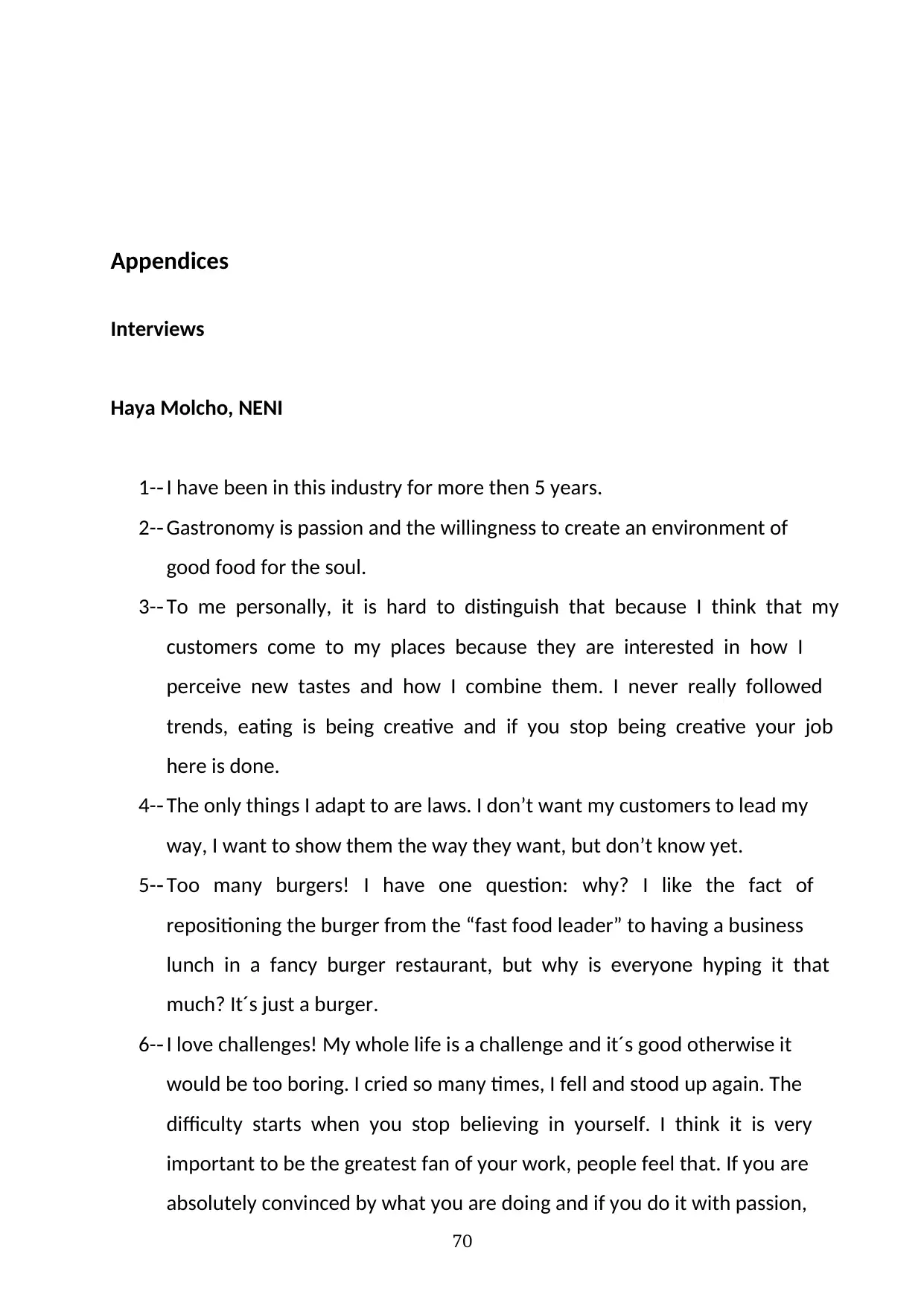
70
Appendices
Interviews
Haya Molcho, NENI
1-‐ I have been in this industry for more then 5 years.
2-‐ Gastronomy is passion and the willingness to create an environment of
good food for the soul.
3-‐ To me personally, it is hard to distinguish that because I think that my
customers come to my places because they are interested in how I
perceive new tastes and how I combine them. I never really followed
trends, eating is being creative and if you stop being creative your job
here is done.
4-‐ The only things I adapt to are laws. I don’t want my customers to lead my
way, I want to show them the way they want, but don’t know yet.
5-‐ Too many burgers! I have one question: why? I like the fact of
repositioning the burger from the “fast food leader” to having a business
lunch in a fancy burger restaurant, but why is everyone hyping it that
much? It´s just a burger.
6-‐ I love challenges! My whole life is a challenge and it´s good otherwise it
would be too boring. I cried so many times, I fell and stood up again. The
difficulty starts when you stop believing in yourself. I think it is very
important to be the greatest fan of your work, people feel that. If you are
absolutely convinced by what you are doing and if you do it with passion,
Appendices
Interviews
Haya Molcho, NENI
1-‐ I have been in this industry for more then 5 years.
2-‐ Gastronomy is passion and the willingness to create an environment of
good food for the soul.
3-‐ To me personally, it is hard to distinguish that because I think that my
customers come to my places because they are interested in how I
perceive new tastes and how I combine them. I never really followed
trends, eating is being creative and if you stop being creative your job
here is done.
4-‐ The only things I adapt to are laws. I don’t want my customers to lead my
way, I want to show them the way they want, but don’t know yet.
5-‐ Too many burgers! I have one question: why? I like the fact of
repositioning the burger from the “fast food leader” to having a business
lunch in a fancy burger restaurant, but why is everyone hyping it that
much? It´s just a burger.
6-‐ I love challenges! My whole life is a challenge and it´s good otherwise it
would be too boring. I cried so many times, I fell and stood up again. The
difficulty starts when you stop believing in yourself. I think it is very
important to be the greatest fan of your work, people feel that. If you are
absolutely convinced by what you are doing and if you do it with passion,
Secure Best Marks with AI Grader
Need help grading? Try our AI Grader for instant feedback on your assignments.
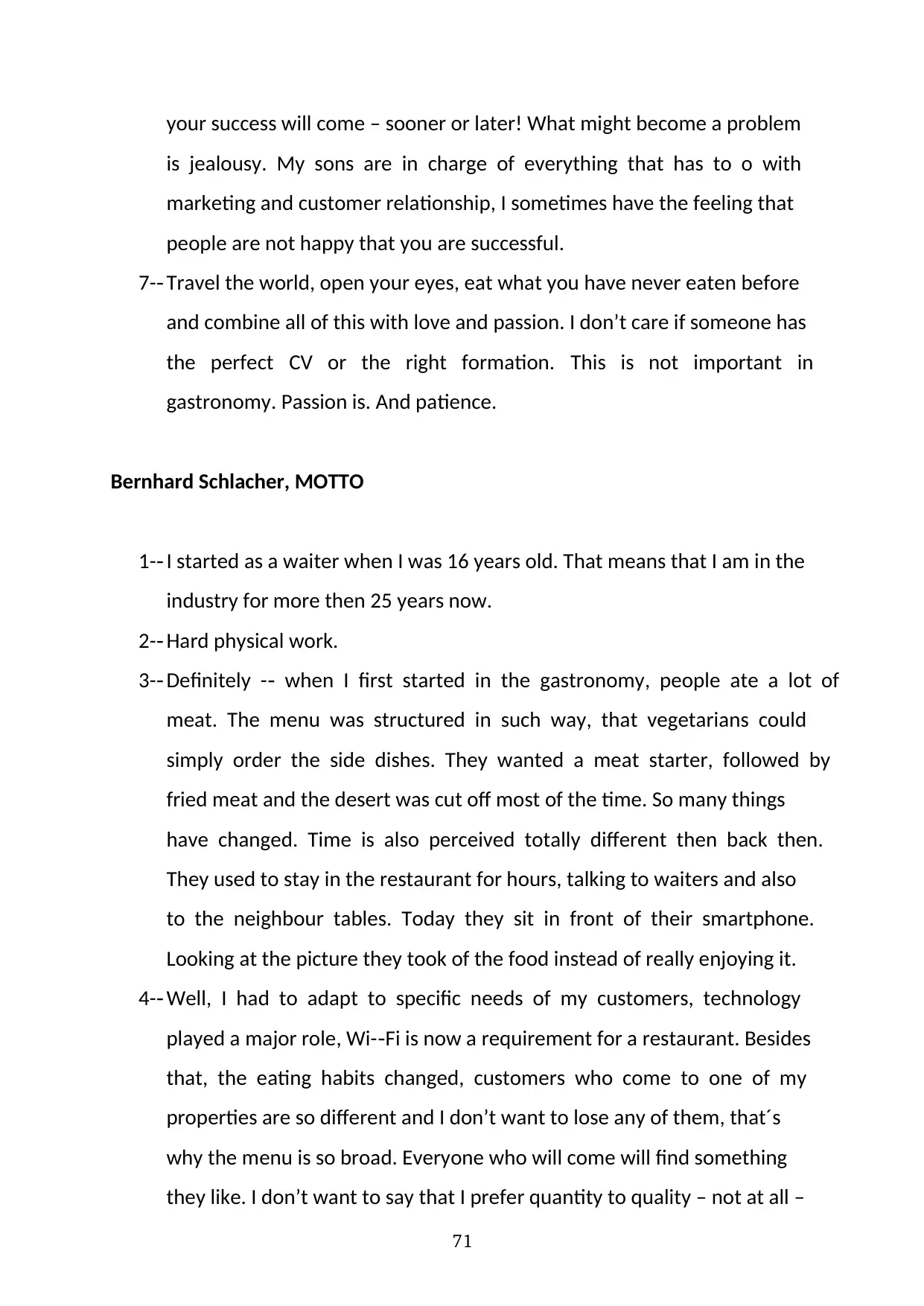
71
your success will come – sooner or later! What might become a problem
is jealousy. My sons are in charge of everything that has to o with
marketing and customer relationship, I sometimes have the feeling that
people are not happy that you are successful.
7-‐ Travel the world, open your eyes, eat what you have never eaten before
and combine all of this with love and passion. I don’t care if someone has
the perfect CV or the right formation. This is not important in
gastronomy. Passion is. And patience.
Bernhard Schlacher, MOTTO
1-‐ I started as a waiter when I was 16 years old. That means that I am in the
industry for more then 25 years now.
2-‐ Hard physical work.
3-‐ Definitely - when I first started in the gastronomy, people ate a lot of‐
meat. The menu was structured in such way, that vegetarians could
simply order the side dishes. They wanted a meat starter, followed by
fried meat and the desert was cut off most of the time. So many things
have changed. Time is also perceived totally different then back then.
They used to stay in the restaurant for hours, talking to waiters and also
to the neighbour tables. Today they sit in front of their smartphone.
Looking at the picture they took of the food instead of really enjoying it.
4-‐ Well, I had to adapt to specific needs of my customers, technology
played a major role, Wi- Fi is now a requirement for a restaurant. Besides‐
that, the eating habits changed, customers who come to one of my
properties are so different and I don’t want to lose any of them, that´s
why the menu is so broad. Everyone who will come will find something
they like. I don’t want to say that I prefer quantity to quality – not at all –
your success will come – sooner or later! What might become a problem
is jealousy. My sons are in charge of everything that has to o with
marketing and customer relationship, I sometimes have the feeling that
people are not happy that you are successful.
7-‐ Travel the world, open your eyes, eat what you have never eaten before
and combine all of this with love and passion. I don’t care if someone has
the perfect CV or the right formation. This is not important in
gastronomy. Passion is. And patience.
Bernhard Schlacher, MOTTO
1-‐ I started as a waiter when I was 16 years old. That means that I am in the
industry for more then 25 years now.
2-‐ Hard physical work.
3-‐ Definitely - when I first started in the gastronomy, people ate a lot of‐
meat. The menu was structured in such way, that vegetarians could
simply order the side dishes. They wanted a meat starter, followed by
fried meat and the desert was cut off most of the time. So many things
have changed. Time is also perceived totally different then back then.
They used to stay in the restaurant for hours, talking to waiters and also
to the neighbour tables. Today they sit in front of their smartphone.
Looking at the picture they took of the food instead of really enjoying it.
4-‐ Well, I had to adapt to specific needs of my customers, technology
played a major role, Wi- Fi is now a requirement for a restaurant. Besides‐
that, the eating habits changed, customers who come to one of my
properties are so different and I don’t want to lose any of them, that´s
why the menu is so broad. Everyone who will come will find something
they like. I don’t want to say that I prefer quantity to quality – not at all –
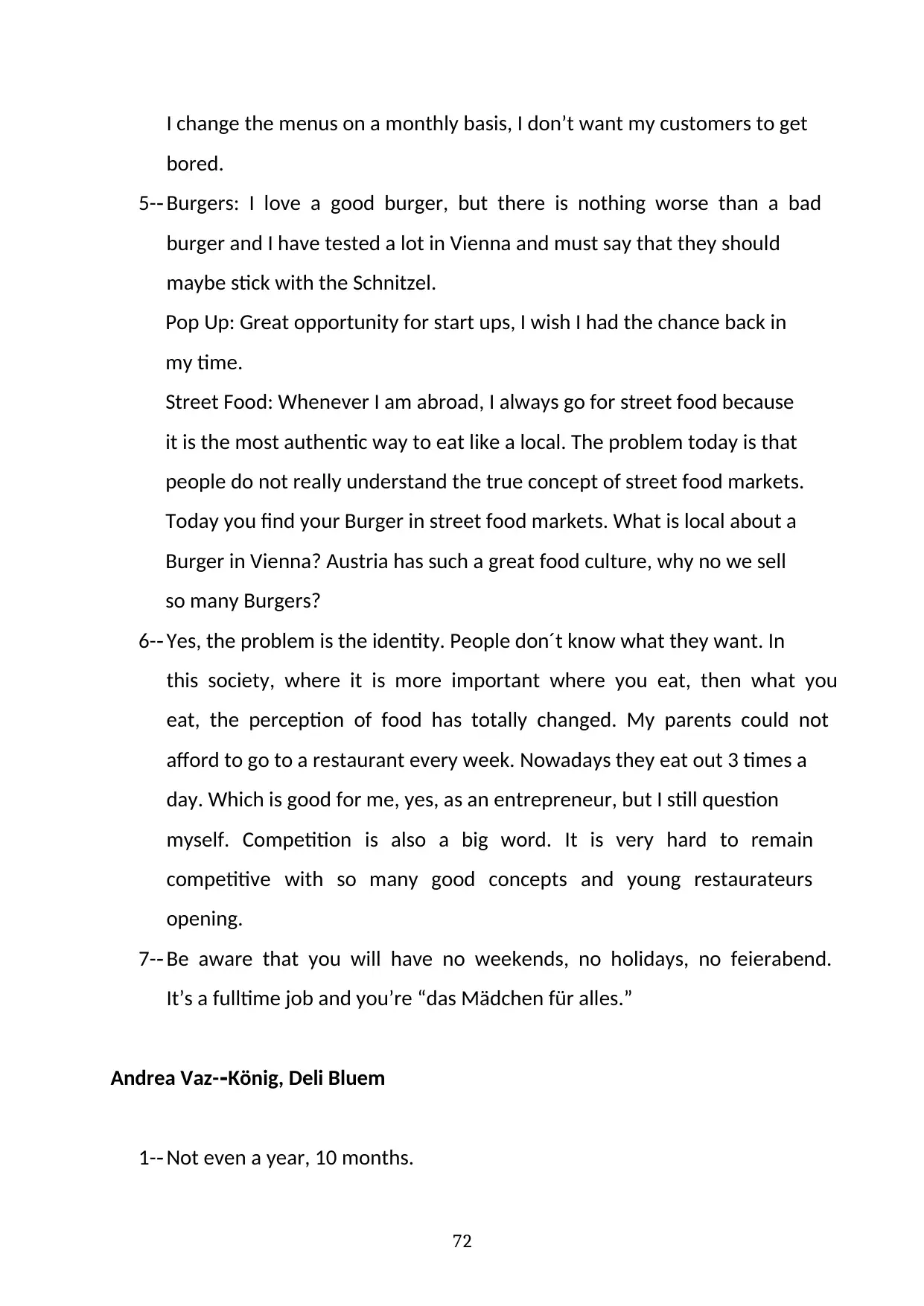
72
I change the menus on a monthly basis, I don’t want my customers to get
bored.
5-‐ Burgers: I love a good burger, but there is nothing worse than a bad
burger and I have tested a lot in Vienna and must say that they should
maybe stick with the Schnitzel.
Pop Up: Great opportunity for start ups, I wish I had the chance back in
my time.
Street Food: Whenever I am abroad, I always go for street food because
it is the most authentic way to eat like a local. The problem today is that
people do not really understand the true concept of street food markets.
Today you find your Burger in street food markets. What is local about a
Burger in Vienna? Austria has such a great food culture, why no we sell
so many Burgers?
6-‐ Yes, the problem is the identity. People don´t know what they want. In
this society, where it is more important where you eat, then what you
eat, the perception of food has totally changed. My parents could not
afford to go to a restaurant every week. Nowadays they eat out 3 times a
day. Which is good for me, yes, as an entrepreneur, but I still question
myself. Competition is also a big word. It is very hard to remain
competitive with so many good concepts and young restaurateurs
opening.
7-‐ Be aware that you will have no weekends, no holidays, no feierabend.
It’s a fulltime job and you’re “das Mädchen für alles.”
Andrea Vaz- König, Deli Bluem‐
1-‐ Not even a year, 10 months.
I change the menus on a monthly basis, I don’t want my customers to get
bored.
5-‐ Burgers: I love a good burger, but there is nothing worse than a bad
burger and I have tested a lot in Vienna and must say that they should
maybe stick with the Schnitzel.
Pop Up: Great opportunity for start ups, I wish I had the chance back in
my time.
Street Food: Whenever I am abroad, I always go for street food because
it is the most authentic way to eat like a local. The problem today is that
people do not really understand the true concept of street food markets.
Today you find your Burger in street food markets. What is local about a
Burger in Vienna? Austria has such a great food culture, why no we sell
so many Burgers?
6-‐ Yes, the problem is the identity. People don´t know what they want. In
this society, where it is more important where you eat, then what you
eat, the perception of food has totally changed. My parents could not
afford to go to a restaurant every week. Nowadays they eat out 3 times a
day. Which is good for me, yes, as an entrepreneur, but I still question
myself. Competition is also a big word. It is very hard to remain
competitive with so many good concepts and young restaurateurs
opening.
7-‐ Be aware that you will have no weekends, no holidays, no feierabend.
It’s a fulltime job and you’re “das Mädchen für alles.”
Andrea Vaz- König, Deli Bluem‐
1-‐ Not even a year, 10 months.
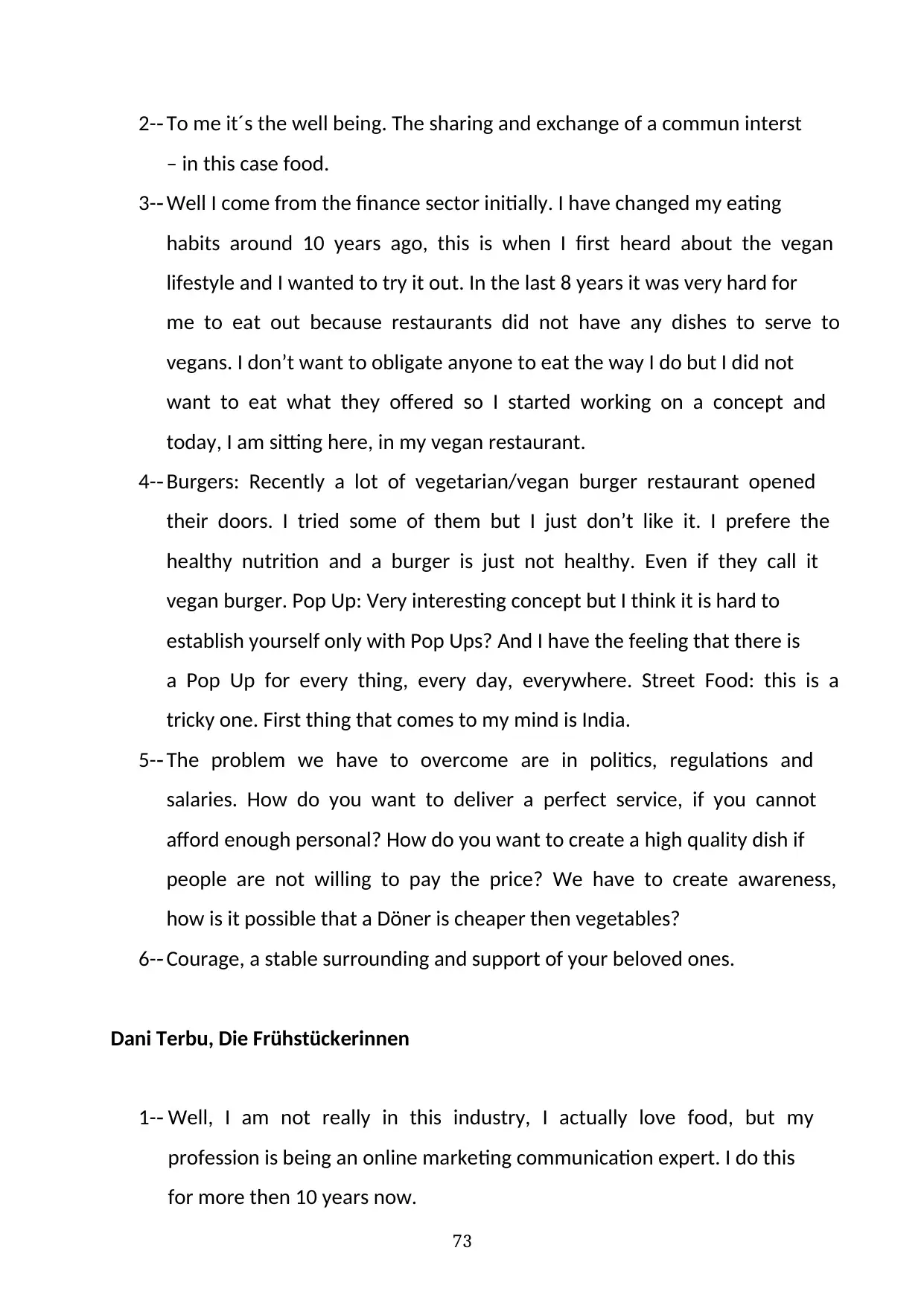
73
2-‐ To me it´s the well being. The sharing and exchange of a commun interst
– in this case food.
3-‐ Well I come from the finance sector initially. I have changed my eating
habits around 10 years ago, this is when I first heard about the vegan
lifestyle and I wanted to try it out. In the last 8 years it was very hard for
me to eat out because restaurants did not have any dishes to serve to
vegans. I don’t want to obligate anyone to eat the way I do but I did not
want to eat what they offered so I started working on a concept and
today, I am sitting here, in my vegan restaurant.
4-‐ Burgers: Recently a lot of vegetarian/vegan burger restaurant opened
their doors. I tried some of them but I just don’t like it. I prefere the
healthy nutrition and a burger is just not healthy. Even if they call it
vegan burger. Pop Up: Very interesting concept but I think it is hard to
establish yourself only with Pop Ups? And I have the feeling that there is
a Pop Up for every thing, every day, everywhere. Street Food: this is a
tricky one. First thing that comes to my mind is India.
5-‐ The problem we have to overcome are in politics, regulations and
salaries. How do you want to deliver a perfect service, if you cannot
afford enough personal? How do you want to create a high quality dish if
people are not willing to pay the price? We have to create awareness,
how is it possible that a Döner is cheaper then vegetables?
6-‐ Courage, a stable surrounding and support of your beloved ones.
Dani Terbu, Die Frühstückerinnen
1-‐ Well, I am not really in this industry, I actually love food, but my
profession is being an online marketing communication expert. I do this
for more then 10 years now.
2-‐ To me it´s the well being. The sharing and exchange of a commun interst
– in this case food.
3-‐ Well I come from the finance sector initially. I have changed my eating
habits around 10 years ago, this is when I first heard about the vegan
lifestyle and I wanted to try it out. In the last 8 years it was very hard for
me to eat out because restaurants did not have any dishes to serve to
vegans. I don’t want to obligate anyone to eat the way I do but I did not
want to eat what they offered so I started working on a concept and
today, I am sitting here, in my vegan restaurant.
4-‐ Burgers: Recently a lot of vegetarian/vegan burger restaurant opened
their doors. I tried some of them but I just don’t like it. I prefere the
healthy nutrition and a burger is just not healthy. Even if they call it
vegan burger. Pop Up: Very interesting concept but I think it is hard to
establish yourself only with Pop Ups? And I have the feeling that there is
a Pop Up for every thing, every day, everywhere. Street Food: this is a
tricky one. First thing that comes to my mind is India.
5-‐ The problem we have to overcome are in politics, regulations and
salaries. How do you want to deliver a perfect service, if you cannot
afford enough personal? How do you want to create a high quality dish if
people are not willing to pay the price? We have to create awareness,
how is it possible that a Döner is cheaper then vegetables?
6-‐ Courage, a stable surrounding and support of your beloved ones.
Dani Terbu, Die Frühstückerinnen
1-‐ Well, I am not really in this industry, I actually love food, but my
profession is being an online marketing communication expert. I do this
for more then 10 years now.
Paraphrase This Document
Need a fresh take? Get an instant paraphrase of this document with our AI Paraphraser
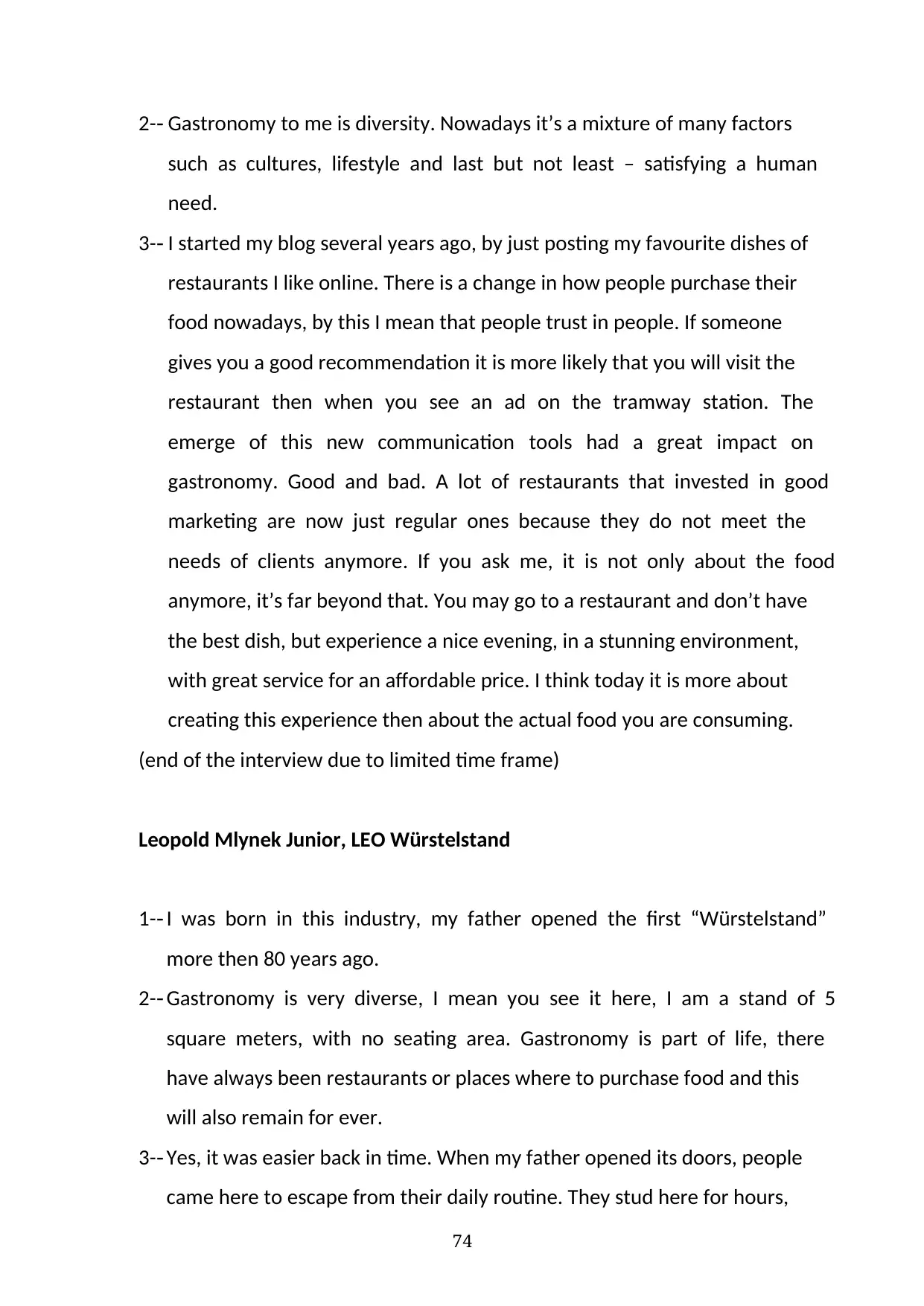
74
2-‐ Gastronomy to me is diversity. Nowadays it’s a mixture of many factors
such as cultures, lifestyle and last but not least – satisfying a human
need.
3-‐ I started my blog several years ago, by just posting my favourite dishes of
restaurants I like online. There is a change in how people purchase their
food nowadays, by this I mean that people trust in people. If someone
gives you a good recommendation it is more likely that you will visit the
restaurant then when you see an ad on the tramway station. The
emerge of this new communication tools had a great impact on
gastronomy. Good and bad. A lot of restaurants that invested in good
marketing are now just regular ones because they do not meet the
needs of clients anymore. If you ask me, it is not only about the food
anymore, it’s far beyond that. You may go to a restaurant and don’t have
the best dish, but experience a nice evening, in a stunning environment,
with great service for an affordable price. I think today it is more about
creating this experience then about the actual food you are consuming.
(end of the interview due to limited time frame)
Leopold Mlynek Junior, LEO Würstelstand
1-‐ I was born in this industry, my father opened the first “Würstelstand”
more then 80 years ago.
2-‐ Gastronomy is very diverse, I mean you see it here, I am a stand of 5
square meters, with no seating area. Gastronomy is part of life, there
have always been restaurants or places where to purchase food and this
will also remain for ever.
3-‐ Yes, it was easier back in time. When my father opened its doors, people
came here to escape from their daily routine. They stud here for hours,
2-‐ Gastronomy to me is diversity. Nowadays it’s a mixture of many factors
such as cultures, lifestyle and last but not least – satisfying a human
need.
3-‐ I started my blog several years ago, by just posting my favourite dishes of
restaurants I like online. There is a change in how people purchase their
food nowadays, by this I mean that people trust in people. If someone
gives you a good recommendation it is more likely that you will visit the
restaurant then when you see an ad on the tramway station. The
emerge of this new communication tools had a great impact on
gastronomy. Good and bad. A lot of restaurants that invested in good
marketing are now just regular ones because they do not meet the
needs of clients anymore. If you ask me, it is not only about the food
anymore, it’s far beyond that. You may go to a restaurant and don’t have
the best dish, but experience a nice evening, in a stunning environment,
with great service for an affordable price. I think today it is more about
creating this experience then about the actual food you are consuming.
(end of the interview due to limited time frame)
Leopold Mlynek Junior, LEO Würstelstand
1-‐ I was born in this industry, my father opened the first “Würstelstand”
more then 80 years ago.
2-‐ Gastronomy is very diverse, I mean you see it here, I am a stand of 5
square meters, with no seating area. Gastronomy is part of life, there
have always been restaurants or places where to purchase food and this
will also remain for ever.
3-‐ Yes, it was easier back in time. When my father opened its doors, people
came here to escape from their daily routine. They stud here for hours,
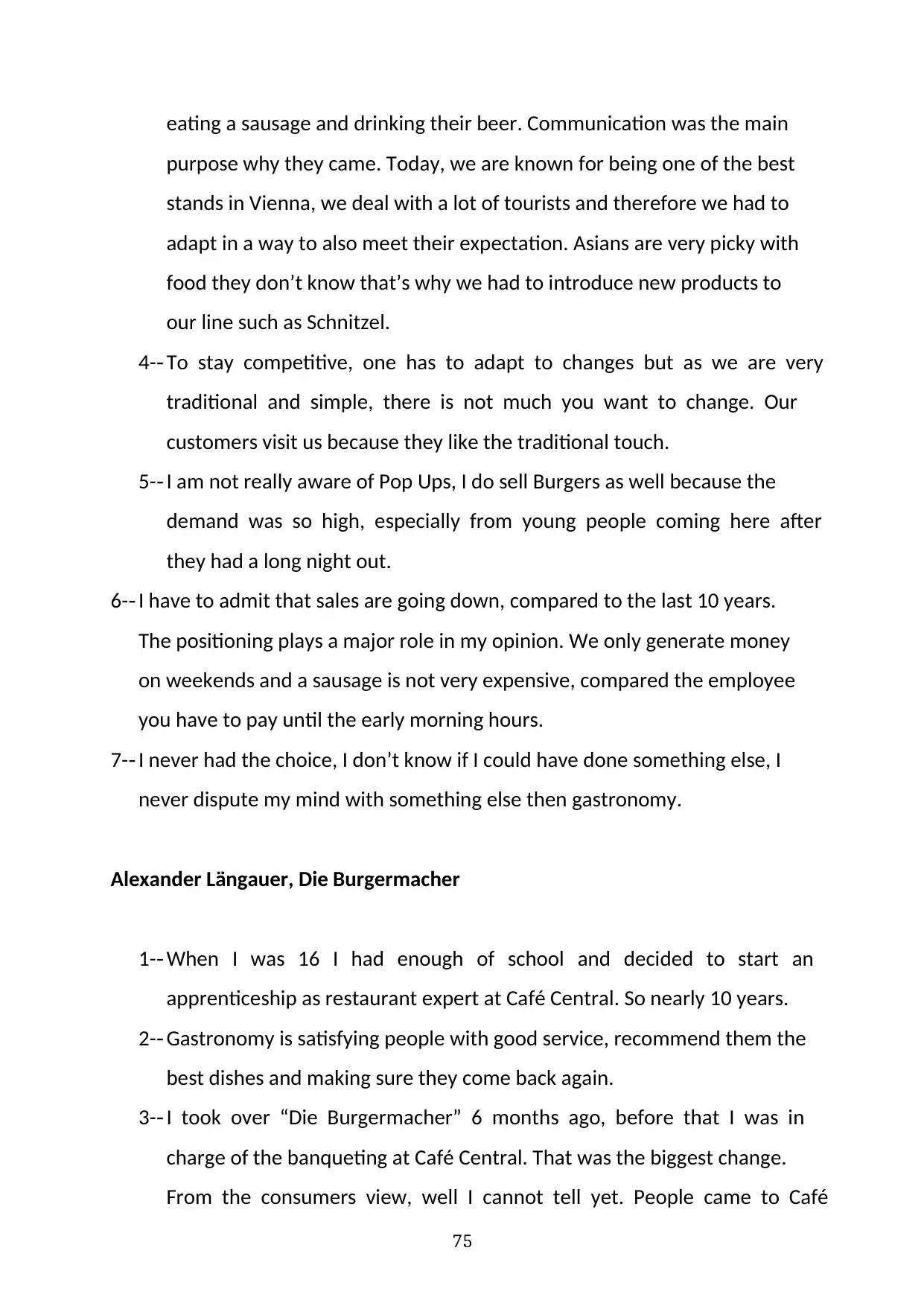
75
eating a sausage and drinking their beer. Communication was the main
purpose why they came. Today, we are known for being one of the best
stands in Vienna, we deal with a lot of tourists and therefore we had to
adapt in a way to also meet their expectation. Asians are very picky with
food they don’t know that’s why we had to introduce new products to
our line such as Schnitzel.
4-‐ To stay competitive, one has to adapt to changes but as we are very
traditional and simple, there is not much you want to change. Our
customers visit us because they like the traditional touch.
5-‐ I am not really aware of Pop Ups, I do sell Burgers as well because the
demand was so high, especially from young people coming here after
they had a long night out.
6-‐ I have to admit that sales are going down, compared to the last 10 years.
The positioning plays a major role in my opinion. We only generate money
on weekends and a sausage is not very expensive, compared the employee
you have to pay until the early morning hours.
7-‐ I never had the choice, I don’t know if I could have done something else, I
never dispute my mind with something else then gastronomy.
Alexander Längauer, Die Burgermacher
1-‐ When I was 16 I had enough of school and decided to start an
apprenticeship as restaurant expert at Café Central. So nearly 10 years.
2-‐ Gastronomy is satisfying people with good service, recommend them the
best dishes and making sure they come back again.
3-‐ I took over “Die Burgermacher” 6 months ago, before that I was in
charge of the banqueting at Café Central. That was the biggest change.
From the consumers view, well I cannot tell yet. People came to Café
eating a sausage and drinking their beer. Communication was the main
purpose why they came. Today, we are known for being one of the best
stands in Vienna, we deal with a lot of tourists and therefore we had to
adapt in a way to also meet their expectation. Asians are very picky with
food they don’t know that’s why we had to introduce new products to
our line such as Schnitzel.
4-‐ To stay competitive, one has to adapt to changes but as we are very
traditional and simple, there is not much you want to change. Our
customers visit us because they like the traditional touch.
5-‐ I am not really aware of Pop Ups, I do sell Burgers as well because the
demand was so high, especially from young people coming here after
they had a long night out.
6-‐ I have to admit that sales are going down, compared to the last 10 years.
The positioning plays a major role in my opinion. We only generate money
on weekends and a sausage is not very expensive, compared the employee
you have to pay until the early morning hours.
7-‐ I never had the choice, I don’t know if I could have done something else, I
never dispute my mind with something else then gastronomy.
Alexander Längauer, Die Burgermacher
1-‐ When I was 16 I had enough of school and decided to start an
apprenticeship as restaurant expert at Café Central. So nearly 10 years.
2-‐ Gastronomy is satisfying people with good service, recommend them the
best dishes and making sure they come back again.
3-‐ I took over “Die Burgermacher” 6 months ago, before that I was in
charge of the banqueting at Café Central. That was the biggest change.
From the consumers view, well I cannot tell yet. People came to Café
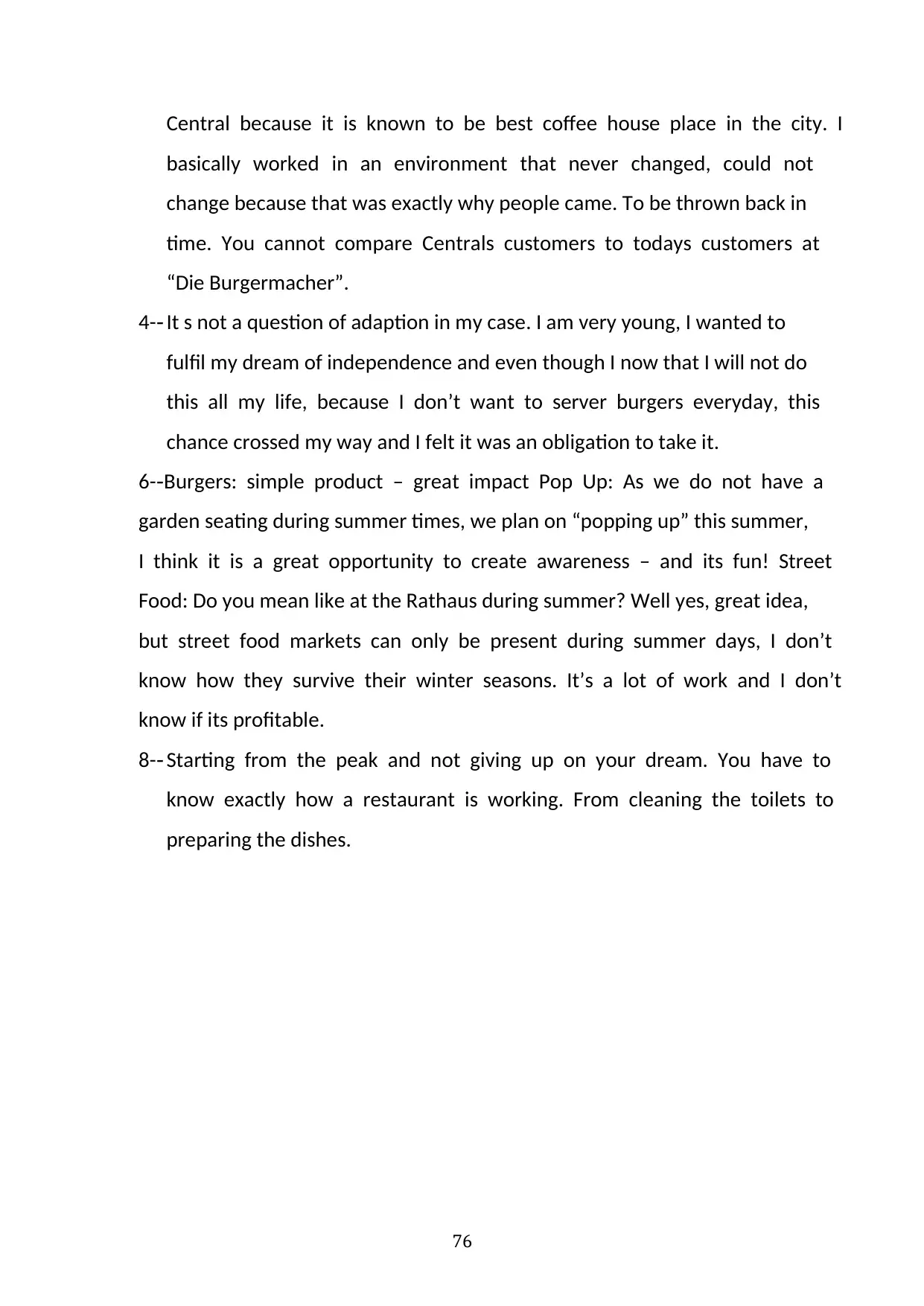
76
Central because it is known to be best coffee house place in the city. I
basically worked in an environment that never changed, could not
change because that was exactly why people came. To be thrown back in
time. You cannot compare Centrals customers to todays customers at
“Die Burgermacher”.
4-‐ It s not a question of adaption in my case. I am very young, I wanted to
fulfil my dream of independence and even though I now that I will not do
this all my life, because I don’t want to server burgers everyday, this
chance crossed my way and I felt it was an obligation to take it.
6- Burgers: simple product – great impact Pop Up: As we do not have a‐
garden seating during summer times, we plan on “popping up” this summer,
I think it is a great opportunity to create awareness – and its fun! Street
Food: Do you mean like at the Rathaus during summer? Well yes, great idea,
but street food markets can only be present during summer days, I don’t
know how they survive their winter seasons. It’s a lot of work and I don’t
know if its profitable.
8-‐ Starting from the peak and not giving up on your dream. You have to
know exactly how a restaurant is working. From cleaning the toilets to
preparing the dishes.
Central because it is known to be best coffee house place in the city. I
basically worked in an environment that never changed, could not
change because that was exactly why people came. To be thrown back in
time. You cannot compare Centrals customers to todays customers at
“Die Burgermacher”.
4-‐ It s not a question of adaption in my case. I am very young, I wanted to
fulfil my dream of independence and even though I now that I will not do
this all my life, because I don’t want to server burgers everyday, this
chance crossed my way and I felt it was an obligation to take it.
6- Burgers: simple product – great impact Pop Up: As we do not have a‐
garden seating during summer times, we plan on “popping up” this summer,
I think it is a great opportunity to create awareness – and its fun! Street
Food: Do you mean like at the Rathaus during summer? Well yes, great idea,
but street food markets can only be present during summer days, I don’t
know how they survive their winter seasons. It’s a lot of work and I don’t
know if its profitable.
8-‐ Starting from the peak and not giving up on your dream. You have to
know exactly how a restaurant is working. From cleaning the toilets to
preparing the dishes.
1 out of 76
Your All-in-One AI-Powered Toolkit for Academic Success.
+13062052269
info@desklib.com
Available 24*7 on WhatsApp / Email
![[object Object]](/_next/static/media/star-bottom.7253800d.svg)
Unlock your academic potential
© 2024 | Zucol Services PVT LTD | All rights reserved.